Accessibility: Metadata, Practices, Programs
Guest Edited by Nettie Lagace (Associate Executive Director, NISO)
Begins on Page 12
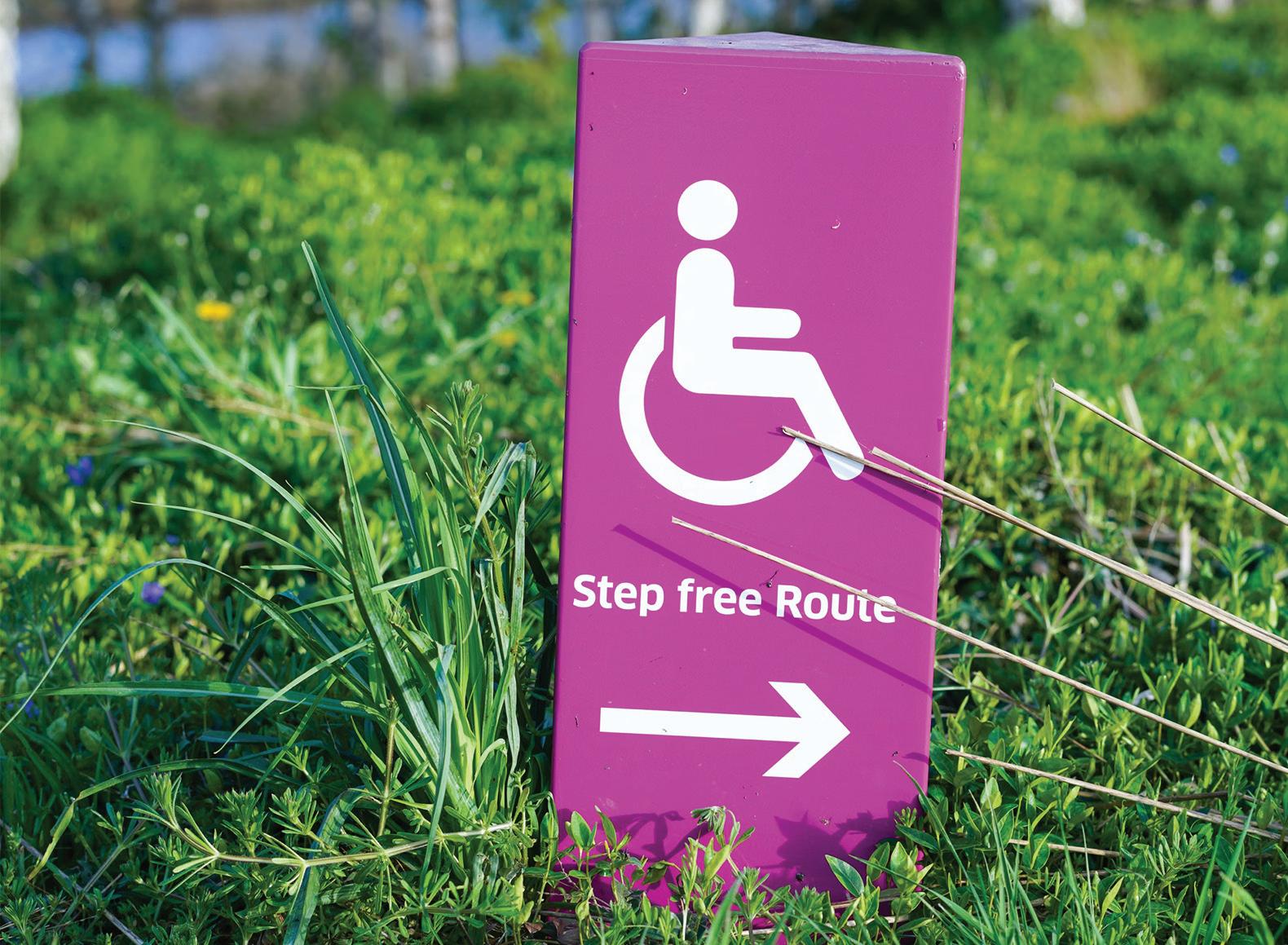
If Rumors Were Horses
Hi everyone, happy spring! Lots to talk about here! Don’t forget to send your rumors to editors@against-the-grain. com for inclusion!
Events and Travel
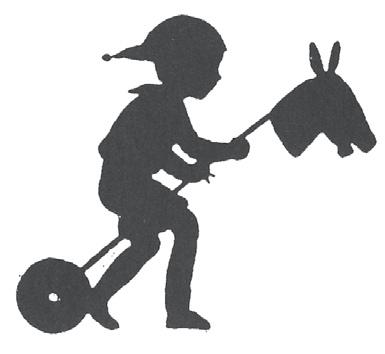
Leah Hinds attended the 2024 UKSG annual conference in Glasgow, Scotland, from April 8–10 along with around 800 others. There, she had the opportunity to catch up with several friends and colleagues in addition to attending the outstanding line-up of sessions and a lovely reception in the Glasgow City Science Center. Michael Upshall, Community and Outreach Manager for CORE at the Open University, wrote up a great report on the event. Michael and Leah had a nice conversation there at the recommendation of Matthew Ismail, our former ATG the Podcast host and EIC for the Charleston Briefings. Keep an eye on the podcast for an episode from Michael coming soon! UKSG 2025 will be held in Brighton from March 31–April 2.
The 2024 Fiesole Retreat is coming up soon from May 6–9 in Cape Town! This is the 24th annual meeting, and it will be focused on the theme of “Connecting Global South with Global
c/o Annual Reviews P.O. Box 10139 Palo Alto, CA 94303-0139 “Linking Publishers, Vendors and Librarians” ISSN: 1043-2094 VOLUME 36, NUMBER 2 APRIL 2024 TM WHAT TO LOOK FOR IN THIS ISSUE: Accessibility: Metadata, Practices, Programs .................. 12 Breaking Down Barriers: Considerations for Improving Accessibility in Libraries ......... 14 Accessibility at Elsevier: A Collaborative, ContinuousImprovement Approach .......... 18 Developing FRAME, EMMA, and ARM: Systems and Metadata for Sharing Resources Remediated for Accessibility ... 21 Accounting for Accessibility in Library Acquisitions: the Univ. of Tennessee Experience ........ 24 REGULAR COLUMNS Bet You Missed It ...................... 10 Reader’s Roundup..................... 27 Booklover ................................... 30 Legally Speaking ...................... 31 Questions and Answers ........... 34 And They Were There .............. 36 Wandering the Web ................. 38 Libraries, Leadership, and Synergies ................................... 40 The Digital Toolbox ................. 46 Back Talk 54 INTERVIEWS Dan Doody ................................. 49 PROFILES ENCOURAGED People, Library and Company Profiles ....................................... 51 Plus more ..................... See inside continued on
page 8

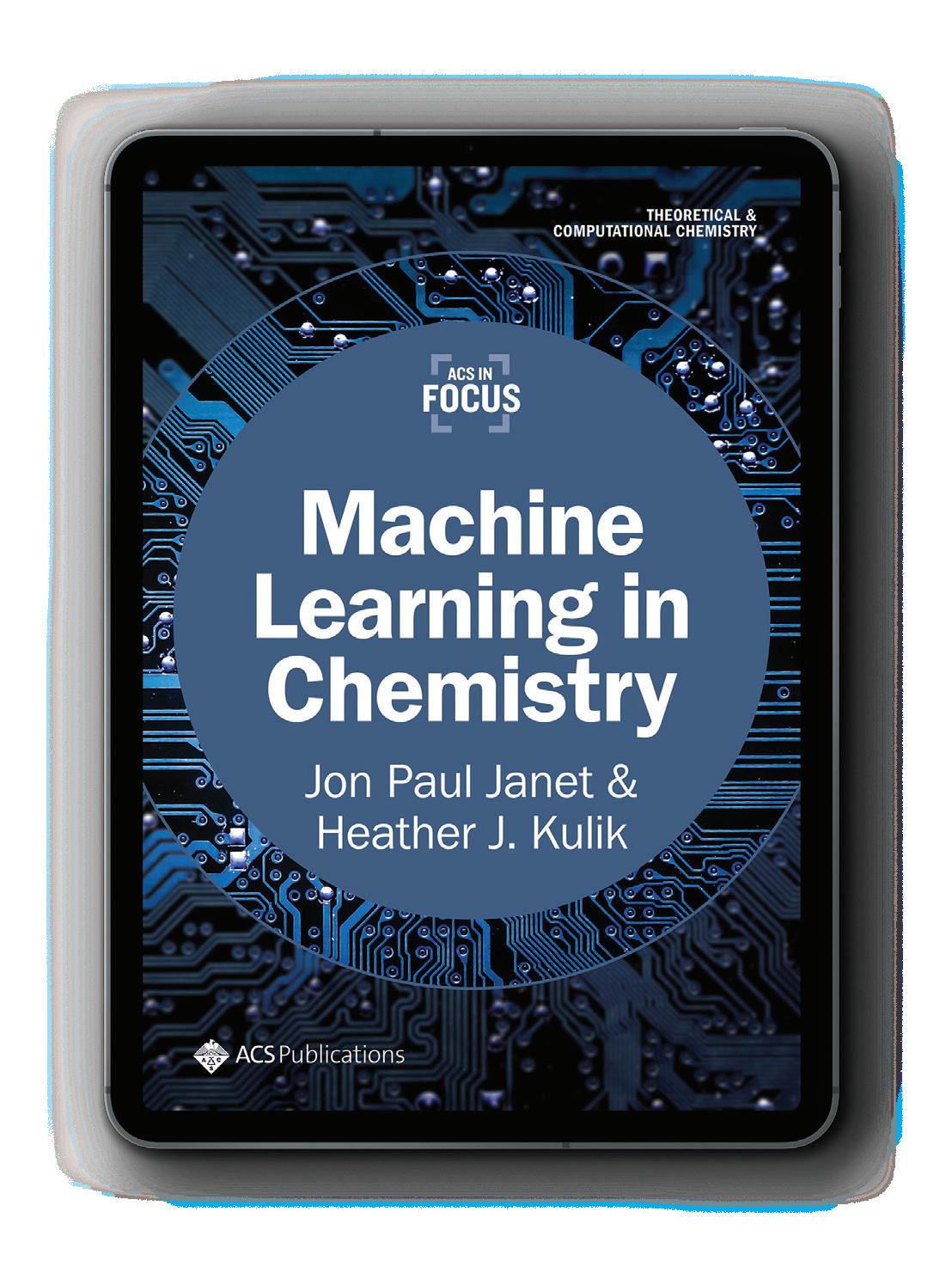
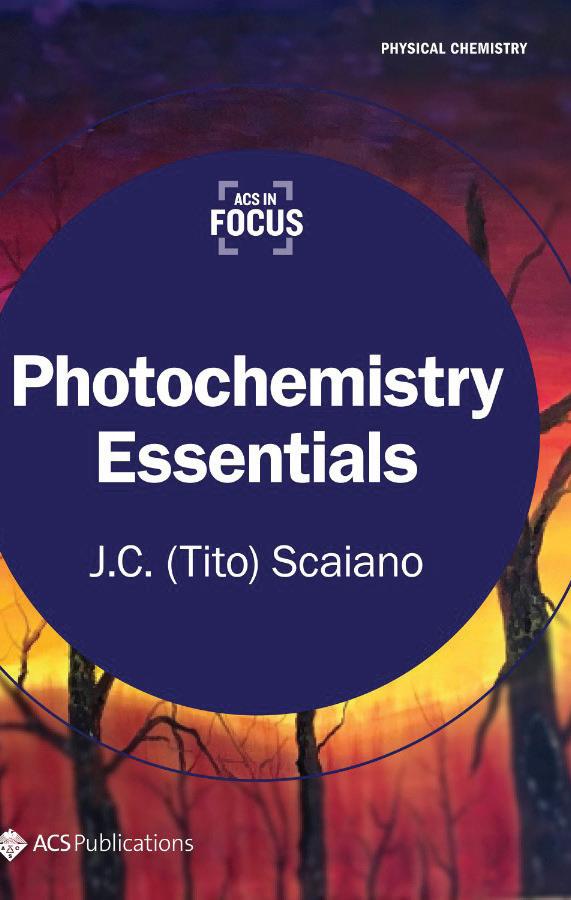
Empowering Researchers to Achieve More
Students and scientists face the constant challenge of keeping pace with the latest advancements and technologies. ACS In Focus, a comprehensive digital resource from the American Chemical Society, empowers readers to overcome these challenges by providing the tools they need to get up to speed quickly on emerging topics.
Find out more





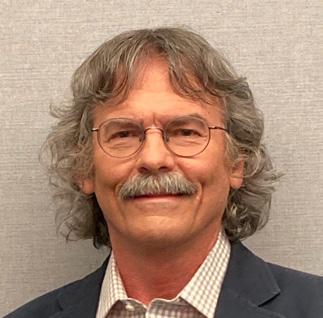



Optica Quantum is dedicated to highly selective research in quantum information science and technology, as enabled by optics and photonics. Its scope encompasses theoretical and experimental research as well as technological advances in and applications of quantum optics.
As an online-only Gold Open Access Journal, Optica Quantum rapidly publishes original peer-reviewed, high-impact results, provides state-of-the-art reviews of both emerging and established subareas of optics- and photonics-related QIST, and shares opinions from recognized authorities on new directions for this critical field.
Please tell your users about this exciting new journal and update your title list.
Editor-in-Chief Michael G. Raymer University of Oregon, USA Deputy Editor Sonja Franke-Arnold University of Glasgow, UK Deputy Editor Luis L. Sanchez-Soto Universidad Complutense de Madrid, Spain Deputy Editor Kartik Srinivasan NIST and University of Maryland, USA Volume 1 Issue 1 September 2023 opg.optica.org/opticaq ISSN 2837-6714
opg.optica.org/OpticaQ
A NEW OPEN ACCESS JOURNAL FOCUSED ON HIGH-IMPACT RESULTS
Rossana Morriello (Politecnico di Torino)
Contributing Editors:
Glenda Alvin (Tennessee State University)
Rick Anderson (Brigham Young University)
Sever Bordeianu (U. of New Mexico)
Todd Carpenter (NISO)
Ashley Krenelka Chase (Stetson Univ. College of Law)
Eleanor Cook (East Carolina University)
Kyle K. Courtney (Harvard University)
Cris Ferguson (Murray State)
Michelle Flinchbaugh (U. of MD Baltimore County)
Dr. Sven Fund (Fullstopp)
Tom Gilson (College of Charleston, Retired)
Michael Gruenberg (Gruenberg Consulting, LLC)
Bob Holley (Wayne State University, Retired)
Matthew Ismail (Charleston Briefings)
Donna Jacobs (MUSC, Retired)
Ramune Kubilius (Northwestern University)
Myer Kutz (Myer Kutz Associates, Inc.)
Tom Leonhardt (Retired)
Stacey Marien (American University)
Jack Montgomery (Retired)
Lesley Rice Montgomery (Tulane University)
Alayne Mundt (American University)
Bob Nardini (Retired)
Jim O’Donnell (Arizona State University)
Ann Okerson (Center for Research Libraries)
David Parker (Lived Places Publishing)
Genevieve Robinson (IGI Global)
Steve Rosato (OverDrive Academic)
Jared Seay (College of Charleston)
Corey Seeman (University of Michigan)
Bruce Strauch (The Citadel, Emeritus)
Lindsay Wertman (IGI Global) Graphics:
4 Against the Grain / April 2024 <https://www.charleston-hub.com/media/atg/>
– ISSUE
v.36 #2 April 2024 — © 2024 ISSUES, NEWS, & GOINGS ON Rumors 1 From Your Editor 6 Letters to the Editor .......................................................................................... 6 Advertising Deadlines ....................................................................................... 6 FEATURES Accessibility: Metadata, Practices, Programs 12 Breaking Down Barriers: Considerations for Improving Accessibility in Libraries 14 Accessibility at Elsevier: A Collaborative, Continuous-Improvement Approach......................................................................................................... 18 Developing FRAME, EMMA, and ARM: Systems and Metadata for Sharing Resources Remediated for Accessibility 21 Accounting for Accessibility in Library Acquisitions: the University of Tennessee Experience ..................................................................................... 24 Back Talk — Another New Library? What Fun!! ............................................. 54 REVIEWS Reader’s Roundup: Monographic Musings & Reference Reviews 27 Booklover — Greased Groove 30 LEGAL ISSUES Legally Speaking — That Word Doesn’t Mean What You Think It Means: Antitrust Edition ............................................................................................. 31 Questions and Answers — Copyright Column 34 PUBLISHING Bet You Missed It 10 And They Were There — Reports of Meetings 36 TECHNOLOGY & STANDARDS AND TEACHING & LEARNING Wandering the Web — April Showers Bring May Flowers: Online Reference Sites for Hobbyist Gardeners 38 Libraries, Leadership, and Synergies — Collections Trends: Changing Work, Evolving Skill Needs, and Career Directions ................................................... 40 BOOKSELLING AND VENDING The Digital Toolbox — One Size Does Not Fit All: Part 1 of 2 46 ATG INTERVIEWS & PROFILES Daniel J. Doody — Former President, CEO, & Owner, Doody Enterprises, Inc. .............................................................................................. 49 Profiles Encouraged ........................................................................................ 51 Against the Grain (ISSN: 1043-2094), Copyright 2023 by the name Against the Grain is published five times a year in February, April, June, September, and November by Against the Grain, LLC. Mailing Address: Annual Reviews, PO Box 10139, Palo Alto, CA 94303-0139. Subscribe online at https://www.charleston-hub.com/ membership-options/ Editor Emerita: Katina Strauch (College of Charleston, Retired) Editor:
Hinds (Charleston Hub) Manager: Caroline Goldsmith (Charleston Hub) Research Editor:
Luther (Informed
AGAINST THE GRAIN
HIGHLIGHTS
Leah
Judy
Strategies) International Editor:
Bowles & Carver, Old English Cuts & Illustrations. Grafton, More Silhouettes. Ehmcke, Graphic Trade Symbols By German Designers. Grafton, Ready-to-Use Old-Fashioned Illustrations. The Chap Book Style. Publisher: Annual Reviews, PO Box 10139 Palo Alto, CA 94303-0139 Production & Ad Sales: Toni Nix, Just Right Group, LLC., P.O. Box 412, Cottageville, SC 29435, phone: 843-835-8604 <justwrite@lowcountry.com> Advertising Information: Toni Nix, phone: 843-835-8604 <justwrite@lowcountry.com> Send correspondence, press releases, etc., to: Leah Hinds, Editor, Against the Grain <leah@charlestonlibraryconference.com> Authors’ opinions are to be regarded as their own. All rights reserved. Produced in the United States of America. Against the Grain is copyright ©2024
A New Type of Transformative Agreement for Research Publishing in Biology
“A sustainable path to open publication of biomedical research is a long-sought objective among the many science communication initiatives at Cold Spring Harbor. Our transformational offerings provide a model for any research-intensive institution whose scientists wish to make their articles openly available in these long-established, prestigious, not-for-profit journals.”
— Dr. John Inglis, Publisher of CSHL Press, co-founder of bioR χiv and medR χiv
Turn your subscription license into an OA publishing license — Immediate benefits for your authors and no extra cost for most institutions
Subscribers to Cold Spring Harbor Laboratory Press (CSHLP) journals now have the option to adopt a Transformative License Agreement. This allows corresponding authors from your institution to publish unlimited OA articles (once accepted for publication), while giving your users access to the complete collection of CSHLP journals.
Transformative license agreements offer a fully OA publishing option for your researchers whose papers are accepted at Genes & Development, Genome Research, Learning & Memory, RNA. For more information about a transformative license with Cold Spring Harbor Laboratory Press, please contact Doug LaFrenier at dlafrenier @cshjournals.org
Benefits include:
• Unlimited open access publication in CSHLP research journals
• Access to the complete collection of CSHLP journals
• No additional cost for most current subscribers (some minimums apply)
• The option to create a branded channel in bioRχiv for preprints posted by your authors (includes medRχiv postings)
Present your institution as an “end to end” open access advocate for the biological sciences.

For complete details, including specifics for your institution, visit
https://www.cshl.edu/cold-spring-harbor-laboratory-press/transformative-agreements/
From Your (here comes the sun!) Editor Emerita:
This issue is jam-packed with goodness! We’d like to thank Nettie Lagace, Associate Executive Director of NISO, for guest editing on the vitally important topic of digital accessibility. We reached out to Nettie following a presentation she organized on the same topic at the 2023 Charleston Conference to invite her to guest edit the issue, and we’re thrilled she and her co-presenters agreed to do so. Beth German, Assistant Director for Library Assessment and User Experience at Princeton University Library, tells us about how to break down barriers to accessibility in the library and how to work collaboratively to increase access. Nicholas Seow, Accessibility Specialist, and Simon Holt, Senior Product Manager, Content Accessibility, discuss their approach to accessibility at Elsevier. Bill Kasdorf, Principal of Kasdorf & Associates, LLC and Co-Founder of Publishing Technology Partners, gets technical with a discussion of systems and metadata to remediate resources for accessibility. And finally, we have a conversation with Elyssa M. Gould, Department Head, Acquisitions & Continuing Resources, and Leigh Mosley, Accessibility Coordinator, both at University of Tennessee, Knoxville, about their complete process for discovering, documenting, and communicating accessibility compliance for the library’s electronic collections. Wow!

Dan and for helping to conduct the interview! And I don’t know about you, but I LOVE flowers! Lesley Rice Montgomery’s Wandering the Web column in this issue brings us some good information on reference sites for hobby gardeners. Bring on the blooms! We also have our first cohort of reports from the 2023 Charleston Conference in “And They Were There,” organized by Sara F. Hess, Business and Entrepreneurship Librarian at Penn State. Reports are organized into several intriguing formats, including “Top 3” lists,” “What I Learned at…” and “Reflections of a First Timer.”
ATG Interviews Daniel J. Doody, recently retired President and CEO of Doody Enterprises. Thank you to Ramune Kubilius, Collection Development / Special Projects Librarian at Galter Health Sciences Library & Learning Center, Northwestern University Feinberg School of Medicine, for connecting us with
Letters to the Editor
Hey y’all! Each issue, we include a letter from one of our readers that’s sent to Katina or our editorial group. We love hearing from you! Please keep sending your
One of my favorite things to do is to take a golf cart ride here on Sullivans Island. Spring has sprung, the sun is shining, the birds are singing, and the waves are crashing on shore. We take our dog Circe along with us, too. Here’s a photo of the iconic lighthouse! The Charleston Light on Sullivan’s Island has guided mariners into the harbor since 1962. The distinctive lighthouse is part of the U.S. Coast Guard Historic District that includes historic buildings dating back to 1894 when the U.S. Life Saving Service protected seafarers from dangers along the nation’s coastlines. The National Park Service protects and preserves the historic district ( https://www.nps.gov/fosu/learn/ historyculture/charleston-light.htm).

Well, let’s get reading! Lots to cover! Love, Yr.Ed.
Send letters to <editors@against-the-grain.com>, or you can also send a letter to the editor from the Charleston Hub at http://www.charleston-hub.com/contact-us/
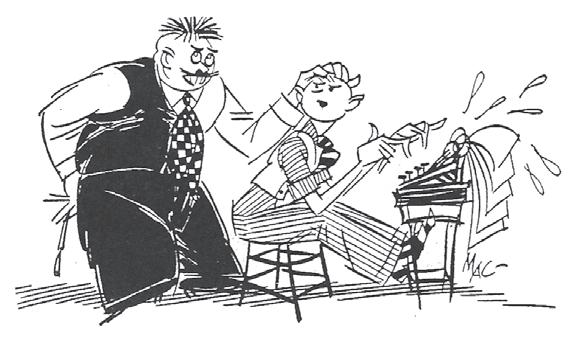
questions, comments, pet photos, or whatever updates you want to share with the ATG world. It means the world to us, really and truly, to get “mail” from our community. Send notes to editors@against-the-grain. com to be included next time!
In the meantime, here’s a cute dog photo to get us through. This is Cooper! He’s a 7-month-old Australian Shepherd that belongs to Leah Hinds, the Executive Director of the Charleston Hub. Maybe he should be our new mascot? The stereotypical library pet is a cat, but we have to be “Against the Grain” here, right?
Hope to hear from you soon!

6 Against the Grain / April 2024 <https://www.charleston-hub.com/media/atg/>
THE GRAIN ADVERTISING
VOLUME 36 — 2024 Issue Ad Reservation Camera-Ready February 2024 01/04/24 01/18/24 April 2024 02/22/24 03/07/24 June 2024 04/11/24 04/25/24 September 2024 06/06/24 07/11/24 November 2024 08/15/24 09/12/24 FOR MORE INFORMATION CONTACT Toni Nix <justwrite@lowcountry.com> Phone: 843-835-8604
AGAINST
DEADLINES

The success of ACM’s transition to sustainable OA is reliant on the engagement and participation of its partners. Please read our white paper presenting feedback and perspectives from six early adopters of ACMO.
Rumors continued from page 1
North: African Perspectives on Scholarly Communication.” We recently announced the travel grant program that supported attendance by 12 early career research librarians from 7 countries (Kenya, Malawi, South Africa, Tanzania, Uganda, Zambia, Zimbabwe), which was supported by funding from The Elsevier Foundation. The retreat will be held at the beautiful Vineyard Hotel, pictured here. In addition to the excellent program topics and speakers, there is also a rich social program including a Gala Dinner generously sponsored by EBSCO, long-time Fiesole Retreat supporter. The retreat is thankful for additional sponsorship support from Erasmus, Sabinet, MDPI, OCLC, Cambridge University Press, and De Gruyter. The full program and more details are available at https://www. fiesoleretreat.org/capetown_2024.

Attention! The Charleston Conference Call for Papers proposal form is now open! We’re thrilled to be working with the Ex Ordo conference management platform again this year for the proposal and review process. This year’s theme of “The Sky’s the Limit” is a rallying call for innovation, exploration, and limitless possibilities. This is your opportunity to contribute to one of the most dynamic conferences in the library and scholarly publishing industry. The in-person conference will be held November 11–15 in beautiful, historic downtown Charleston, and the virtual conference will be held December 9–13. We encourage submissions that offer practical insights, innovative thinking, diverse perspectives, and contribute to ongoing industry discussions, and promote active learning among attendees. We look forward to receiving your proposals and shaping another amazing conference experience together! Charleston Vendor Showcase and conference registration will both be opening in June. For more dates and important information, see our website at https://www.charleston-hub. com/the-charleston-conference/welcome/2024-charlestonconference/.
Did you catch our most recent Charleston In Between virtual conference last month? Sven Fund, Managing Director of Reviewer Credits, put together an amazing roster of speakers on the topic of Publishing Integrity. Videos are now available in a playlist on our YouTube channel!
Industry News
Russell Michalek, Trevor Dawes, and Jon Cawthorne have a new book out, published by ACRL, called Toxic Dynamics: Disrupting, Dismantling, and Transforming Academic Library Culture From the description: “By understanding the root causes of toxic cultures, recognizing their impact, and implementing solutions,
leaders can create a more supportive and positive work environment and improve morale, retention, and productivity. Toxic Dynamics is an important resource for anyone interested in improving workplace culture and addressing issues related to toxicity and inequity, and for library leaders at all levels.” Congrats on the publication and can’t wait to check it out!
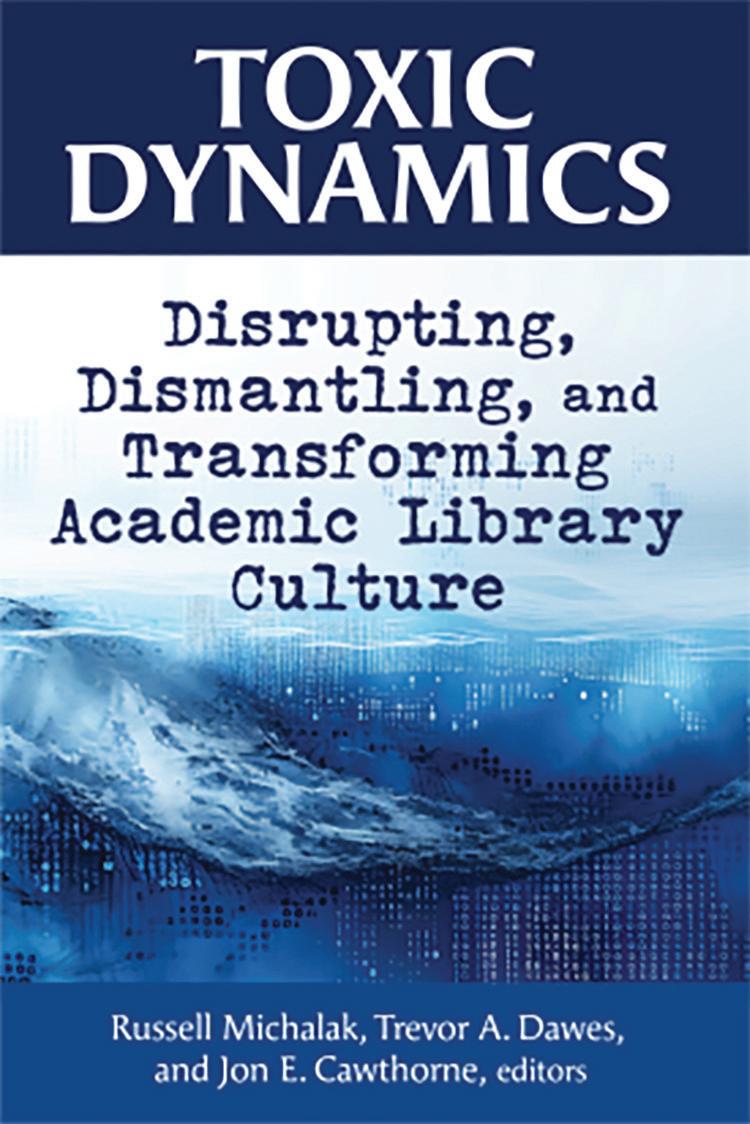
Have you heard? Bird is the word! bird (Base Inventory of Research Databases) is a new product from Paratext that provides a comprehensive guide to 7,500+ commercial and Open Access research databases from 2,000+ information suppliers. bird won Best Overall New Product and Best New Product Design at the 2023 Charleston Premiers!
And speaking of birds ... Mitchell Davis, who many of you know from BiblioLabs and more, was recently featured on the Down the Road podcast along with Farrah Hoffmire about their enterprise Rare Bird Farm in Madison County, NC. “Rare Bird Farm in the mountains of Madison County is an agricultural arts center that hosts performing arts, classes, workshops, and community events, all centered around the ideas of creativity, connection, and collaboration. While not a commercial farm, Rare Bird also raises animals, medicinal plants, and food.”
David Worlock brought my attention to the passing of Ivan Klimes, Publishing Director at Maxwell’s Pergamon Press. According to David, Ivan was the man “who really created, as publishing director of Maxwell’s Pergamon Press, the modern science journal.” https://www.davidworlock.com/2024/04/ ivan-klimes-a-founder-of-modern-science-journal-publishing/
Bits and Bytes
For those of us watching hurricanes, this tidbit caught my eye! The Gulf Stream is a major ocean current that brings warm water from the Gulf of Mexico into the Atlantic Ocean, significantly influencing weather patterns. Spanish explorer Juan Ponce de León first observed the current in 1513, but it wasn’t until the late 18th century that Benjamin Franklin became the first to chart out the path of the Gulf Stream on a map. While serving in London as deputy postmaster general for the American colonies, Franklin noticed a difference in sailing times between westbound and eastbound ships. He consulted his cousin Timothy Folger, a Nantucket whaler with deep knowledge of the area, who provided his insights into the powerful current. Together, Franklin and Folger charted the waters, and published their findings on a map in 1768, the first known physical depiction of what they termed the “Gulph Stream.” The map was distributed to Franklin’s mail ships, and the knowledge served as the basis of future Gulf study by the United States Coast Survey. https://historyfacts.com/ famous-figures/article/benjamin-franklin-facts/
THE WONDERFUL RAMUNE KUBILIUS SENDS US THIS ASTONISHING NEWS! Garbage collectors in Ankara, Turkey, started noticing an increasing number of books being thrown away. Rather than let them end up in landfills, they began rescuing the books. Initially, they shared the books
8 Against the Grain / April 2024
<https://www.charleston-hub.com/media/atg/>
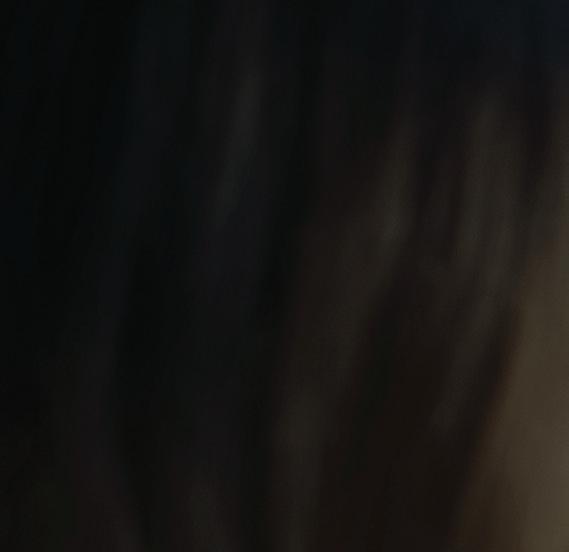


Now you can find Kanopy’s exclusive films in the same place as OverDrive’s catalog of millions of ebooks and audiobooks. It’s your one stop for building a collection of sought-after films and essential titles that your students and faculty need.

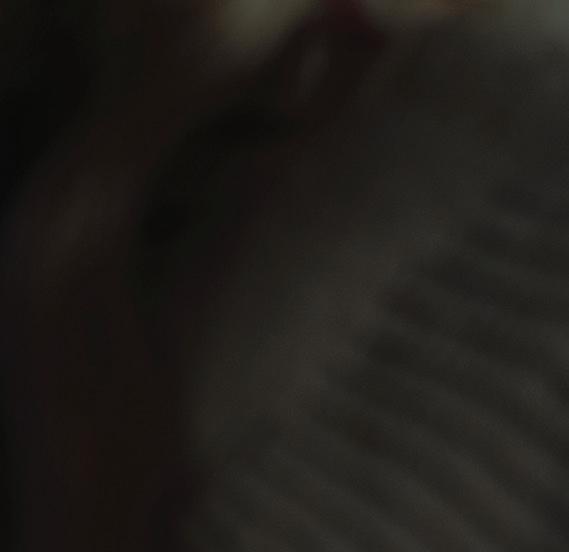
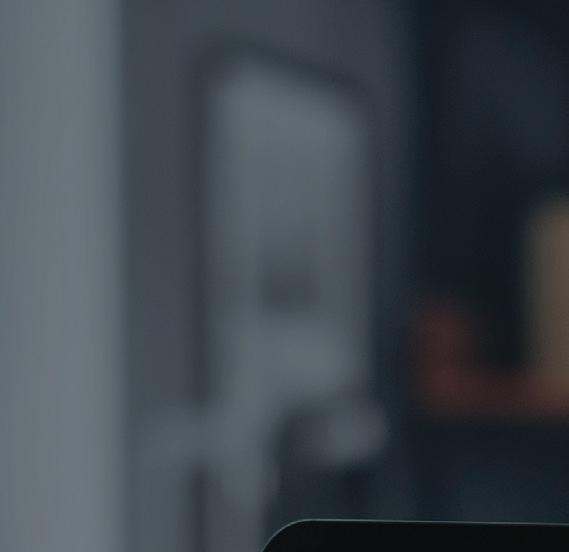
Films that matter and the largest catalog of digital books – in ONE place
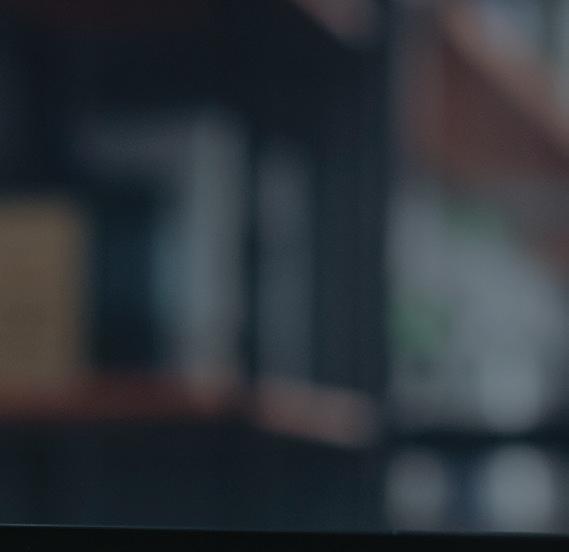
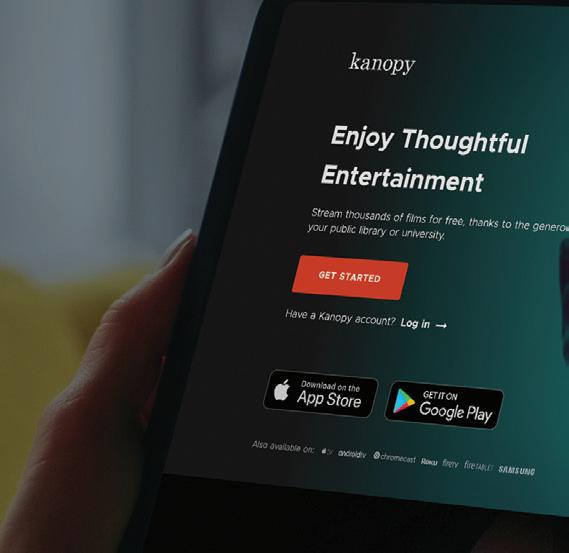


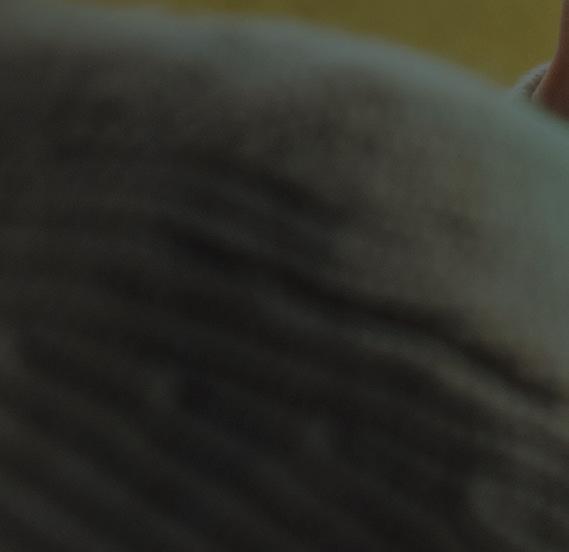
Chat with your account rep to expand your offerings or visit company.overdrive.com/academic-libraries/ to get started.
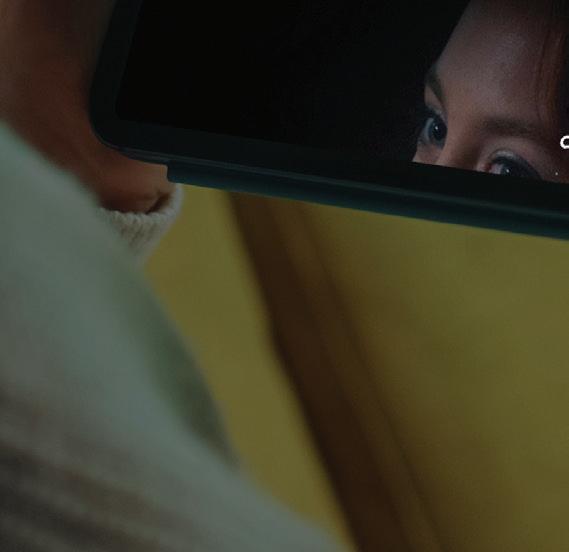
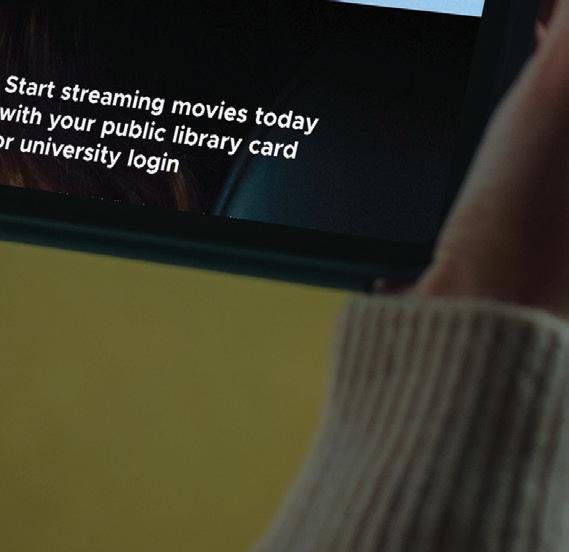

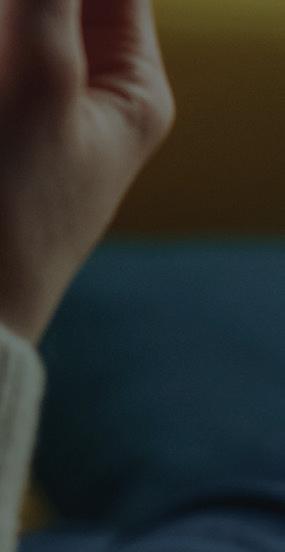
with colleagues and families. As the collection grew, they decided to create a public library in an abandoned brick factory within the Çankaya district. https://lithub.com/turkish-garbagecollectors-have-created-a-libraryfrom-discarded-books/
The library has been a huge success. It offers a wide range of books and even has a mobile library built into a converted garbage truck to reach more people. It’s become a community hub, a place to promote literacy and the joy of reading.
Local Charleston Updates

Congratulations to College of Charleston alumnus, Michael Bourke ’08 and his wife, Jenny Ferrara, for cleverly founding Philosophers & Fools Books and Beverages at 50 Bogard Street in Charleston. From the website: “Philosophers & Fools is a cozy neighborhood bookstore bar in Charleston, SC. Created by two people who love to read and sip on a glass of wine or a craft beer while they read, they crazily (or brilliantly?) said to one another, ‘Why don’t we create a space where others can enjoy this, too?’ And so, here we are. We’ve made our dream a reality. Everything we carry, from the books to the wine & beer, from the snacks to the decor has been thoughtfully selected by our team. Just ask — there’s a story for just about everything in the shop! We welcome
you to come in and discover a new book or find an old one not yet on your shelf, sit down for a conversation with friends, and enjoy something to drink or snack on. We look forward to talking about books with you.” Both the Charleston City Paper and the Post and Courier are raving about it! We can’t wait to stop in (it’s a 20-minute walk from the Francis Marion) and congratulate them!
Just saw the headline: “Have Americans lost their appetite for the basic burger?” It is an article by one of my favorite Charleston Post and Courier columnists, Warren Peper. Warren asks if the new cousin is the “boutique burger”? Warren recalls a burger place that had fond memories. The Goodie House on Calhoun Street across from the College of Charleston run by a mom and pop and their two sons. It only had seats for ten or so people and was always packed. Cerise Oberman and I always had the cheese omelets. Cerise left Charleston and is now in Plattsburgh, NY, where she and her husband Laurence Soroka founded Plattsburgh Expeditionary Studies (EXP) where they plan to provide deserving EXP students financial support by establishing the EXP award. alumni.plattsburgh.edu
That’s it for now. Thanks for reading and catch you back here in June!
9 Against the Grain / April 2024 <https://www.charleston-hub.com/media/atg/>
Bet You Missed It — Press Clippings — In the News
Carefully Selected by Your Crack Staff of News Sleuths
Column Editor: Bruce Strauch (The Citadel, Emeritus) <bruce.strauch@gmail.com>
Peppa Pig Finds Her Critics
Peppa Pig is a popular British cartoon about a cheeky piggy who lives with mummy, daddy and brother. Under its influence, American kids are starting to talk British. Merchandise sales of toys, pajamas, and theme parks have hit $1.7 billion a year. Peppa has trounced “Masha and the Bear,” “Spongebob Squarepants,” and “PAW Patrol.”
But Peppa is rude and pushy. She shoots barbs at her little brother and mocks Daddy’s girth. Millennial parents want socially sensitive kids. For them, Peppa is unkind, rude, and bossy. And fat-shaming is a no-no.
Hasbro, the owner, is aware of the criticism. Daddy pig has become more parental, cooking meals and reading to his kids. But Peppa will remain a typical 4-year-old.
And there is a Peppa film coming to theaters, a Lego set, and a Crocs collaboration.
See: Chavie Lieber, “‘Peppa Is a Brat’: Parents Turn On the Cheeky Preschooler Pig,” The Wall Street Journal, Feb. 26, 2024, p.A1.
Leaving Your Guts to a Med Museum
The Mütter Museum in Philadelphia has for 160 years shown the inner workings of humanity. The displays of human skeletons and preserved organs include an oversize colon of a man who died of constipation. A tumor removed from Grover Cleveland’s jaw can be viewed along with severed hands and a 17-inch-wide ovarian cyst.
“Not for the squeamish,” says one of the Yelp reviews.
The gift shop sells plush toys of the oversize colon along with E. coli, chlamydia and a flesh-eating virus.
For those wishing to leave their remains to the Mütter, the Museum unfortunately has paused new acquisitions until it completes a human remains policy.
See: Peter Loftus , “Mütter Museum Exhibits Show Guts, Including the ‘Mega Colon,’” The Wall Street Journal, Feb. 20, 2024, p.A1.
Obit of Note
N. Scott Momaday (1934-2024) was supposed to submit poetry to Harper, but he sent the novel House Made of Dawn instead. It wove stream-of-consciousness with a Native American circular oral structure to tell the tale of a WW II vet struggling to adjust to reservation life in New Mexico. It won the 1969 Pulitzer prize for fiction, the first for a Native American.
His father was Kiowa, his mother Cherokee, and they taught on Navajo, Apache, and Pueblo Reservations. Momaday grew up on horseback dreaming of being a writer. With a Ph.D. in English from Stanford, he taught at universities and wrote novels, poems, and essays. He is credited with trail-blazing for generations of Native American authors.
See: “The novelist who launched a Native literary renaissance,” The Week, Feb. 16, 2024, p.35.
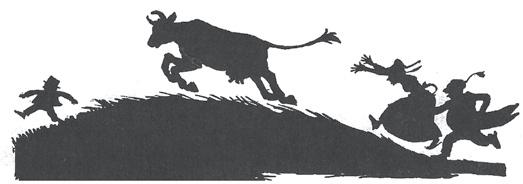
Tuck Shop in Lit
The Tuck Shop or snack shop was a vital element of the British boarding school both as a school fund-raiser and a supplement from the wretched meals. So, of course, it turns up in schoolboy/girl literature. The first mention is in Thomas Hughes 1857 novel Tom Brown’s School Days where Sally Harrowell’s pie shop served the Rugby School.
Enid Blyton’s Malory Towers and St. Clare’s series has the girls reveling in midnight feasts of jammy buns, pork pies, chocolate, sardines, and Nestle’s milk.
In Roald Dahl’s childhood memoir Boy, anxious mothers send weekly tuck to ravenous little sons: “home-made currant cake, a packet of squashed-fly biscuits, orange, apple, banana, pot of strawberry jam or Marmite, a bar of chocolate, a bag of Liquorice Allsorts and a tin of Bassett’s lemonade powder.”
Charles Hamilton’s Billy Bunter of Greyfriars School has the corpulent Bunter devouring sticky buns and a wedge of cake with a sea of crumbs at his feet.
J.K. Rowling in Harry Potter goes more stomach-churning with chocolate frogs and earwax-flavoured jelly beans.
See: Madeleine Silver, “Hitting the Sweet Spot,” Country Life, Feb. 28, 2024, p.66.
Brill Building
The Brill Building is an art deco structure at 1619 Broadway in midtown Manhattan. Songwriters, record labels, and recording studios were all under one roof. Staggering talent gathered there — Burt Bacharach, Hal David, Gerry Goffin, Carole King, Neil Diamond.
The “Tin Pan Alley” district had been the big-band era. From the early to mid-sixties, the Brill Building sound was rock ’n roll with hundreds of Billboard Hot 100 hits — “Stand By Me,” “One Fine Day,” “Be My Baby.”
Carole King and her husband Gerry Goffin wrote “Will You Love Me Tomorrow,” and the Shirelles recorded it in 1960 all there at the assembly-line pop of the vertically integrated eleven stories of the building. They then wrote “The LocoMotion” and had it recorded by their 17-year-old babysitter Little Eva.
Phil Spector produced the echo-resonant “River Deep, Mountain High,” and Tina Turner sang it. Jerry Leiber and Mike Stoller wrote “Hound Dog” and “Jailhouse Rock.”
The brilliance was short-lived. The Beatles and Bob Dylan composed and played their own songs setting a new trend. The songwriter-for-hire era ended.
Ed. Note: But not really. The pro song-writer is still very much with us. And many of the bands merely pretended to write their own material.
See: “What exactly is the ‘Brill Building sound’?” hello@ historyfacts.com, March 1, 2024.
continued on page 13

10 Against the Grain / April 2024 <https://www.charleston-hub.com/media/atg/>
MARY ANN LIEBERT, INC.
JOURNAL ARCHIVES
Make 40+ Years of Field-Defining Discoveries a Permanent Part of Your Collection
Research published in Mary Ann Liebert, Inc. journals makes history. Your researchers and your collection will benefit from having permanent access to the findings upon which important fields of inquiry are defined, giving your collection a breadth and depth to complement your subscription access.
A purchase of the Mary Ann Liebert, Inc. Journal Archive will:
• Secure perpetual access to all content published in all 100+ Mary Ann Liebert, Inc. journals, from volume 1, issue 1
• Deliver an important historical, retrospective complement to the cutting-edge research and innovations being published in current volumes
• Make it easy for you to purchase the exact titles you need for the volume years you need
• Support archival and historical research being done by your researchers to drive current innovations and discoveries forward
• Provide access to and a record of research done by your institution’s researchers in these important areas of inquiry over time and in perpetuity
Contact your Account Representative today or reach out to us at sales@liebertpub.com and secure perpetual access to a tailored package for as many titles, for as many years as needed to ensure access to the content that your users rely on for essential research.

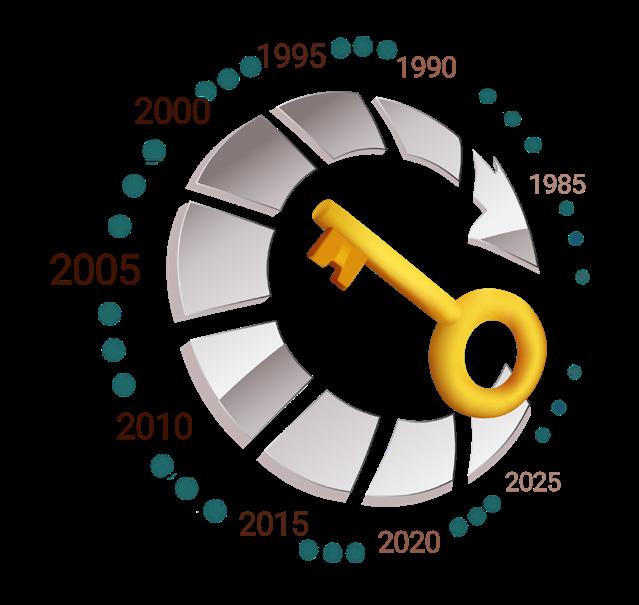
liebertpub.com/libraries
Accessibility: Metadata, Practices, Programs
By Nettie Lagace (Associate Executive Director, NISO) <nlagace@niso.org>
As guest editor, I’m delighted and honored to introduce this excellent Against the Grain collection of articles on the topic of accessibility. I took on this project as an opportunity to improve my own understanding and to learn new things. This area of work is constantly improving and there is always more to know.
This issue includes an assortment of perspectives on accessibility in general, on the mindsets we need to adopt for better support, and how we might better collaborate across the institution-vendor-content provider space to share information and create tools. Collaboration is a key factor to any advancement or improvement, especially in the accessibility space that affects so many of us, and I’m very pleased that all the articles promote this activity.
According to the Centers for Disease Control and Prevention, up to one in four adults in the United States have some sort of disability.1 Statistics are similar in the UK,2 Europe,3 and Canada.4 Of course, there are many forms of disability, but it’s likely that everyone either experiences a disability of their own or knows someone quite closely who is disabled. Disabilities can include vision or hearing impairments, motor disabilities, or neurodiversity, among others. Supporting accessibility needs to be a core part of our work in libraries and the information industry not only in order to ensure that our outputs are reaching the broadest possible audience but also to ensure effective input into decisions and directions. And improving accessibility actually benefits many more users than even the “target” audience; it’s likely that non-disabled users will take advantage of accessible features as well. For example, how many of us use captioned content, even that produced in our own language, to help better understand actors with strong regional accents, or to watch programs online when our family member next to us is sleeping?
In this ATG issue, we’re focusing on digital accessibility: the work to ensure that any online text or audiovisual content or web-based tool is usable by any user who needs it. It’s important to bear in mind some obstacles, as described by Joni Dames in her practical paper, “An Incomplete Guide to Creating Accessible Content”:
• Visual (not everyone can see your content)
• Aural (not everyone can hear your content)
• Physical (not everyone can click on things in your content)
• Geographical (not everyone has fast, stable Internet to download your content)
• Cognitive (not everyone can understand your content)
• Cultural (the visual signifiers in your content mean different things in different countries)5
It can be easy to take our own abilities and perspectives for granted. Such complacency can block the creativity and innovation needed to solve accessibility issues experienced by others.
Our authors demonstrate no short supply of awareness and appetite to tackle these issues in their organizations and those of their partners:

As Beth mentions, we need to ensure that resources and tools are fully available for staff users as well as end users. Her article describes an application of external frameworks supporting accessible principles to improve library processes, to ensure that these processes may truly help all library users by thinking about them in new ways.
Simon and Nicholas relate how important it is to collaborate with others, internally and externally, to improve systems and continually promote work within a vendor operation. Their account of how they rely on the WCAG standard to create VPATs and embed accessibility into product design, and create a culture of continuous improvement, is to be admired.
Bill discusses how individual efforts at remediating inaccessible course content — an extremely labor-intensive activity — can be analyzed and brought together to create standards to support better sharing and collaboration and improve tools for access. The benefits impact users and the institutions who serve them and foster a network of experts who can rely on each other.
Elyssa and Leigh describe their library’s subscribed product testing and tracking program, which supports their own users directly — but also provides a basis for collaboration and sharing information across libraries and fosters better communication with vendors and content providers.
Collaboration and sharing can bear real fruit!
A Few Additional Inspirations from Sources Outside Our Community:
Many varied statistics are cited in an illuminating web accessibility report issued earlier this year by Pixelplex, some describing market sizes and forecasts, others describing the state of accessibility and how digital experiences are still viewed as “inadequate” because of the lack of support. But the report also includes forward-looking remarks, such as the potential for AI to contribute positively to this area of work, and how most organizations see the adoption of a digital accessibility policy to be a competitive advantage. Pixelplex states, “By prioritizing web accessibility, you enhance customer engagement and experience, minimize legal risks, and position your business as forward-looking and customer-centric.”6
And as stated by s.e. smith in The Nation in an article about creative approaches to supporting communication with and spaces for disabled people, “Accessibility can also challenge nondisabled people, or those who don’t share a given impairment, to think about how they view the disability community. […] Accessibility doesn’t have to, and shouldn’t, be a burden.”7 Indeed.
I’m impressed with the expertise and advice included here from our authors. I think you will find it helpful, too.
12 Against the Grain / April 2024
<https://www.charleston-hub.com/media/atg/>
AMS MathViewer
More interactive than PDF. As easy as print.
MathViewer is a dual-panel journal platform that offers a rich, accessible alternative to print and PDF. Its innovative design makes it easy to explore figures, review references, and navigate articles using assistive technologies.
www.ams.org/AMSMathViewer
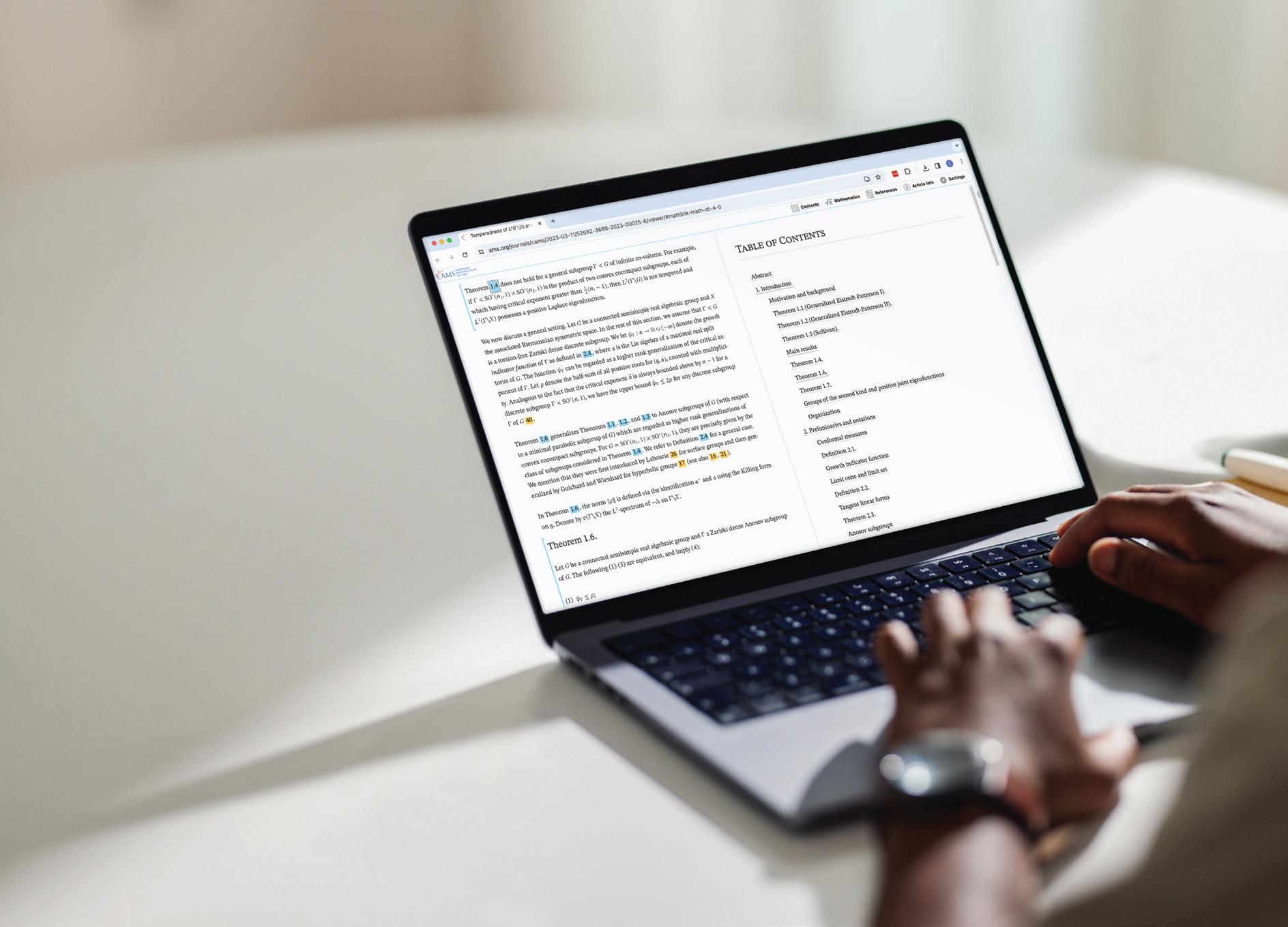
Endnotes
1. Centers for Disease Control and Prevention. “Disability impacts all of us.” 15 May, 2023. https://www.cdc.gov/ncbddd/ disabilityandhealth/infographic-disability-impacts-all.html, Accessed 2 April, 2024.
2. UK Parliament, House of Commons Library. “UK disability statistics: Prevalence and life experiences.” 23 August, 2023. https://commonslibrary.parliament.uk/research-briefings/ cbp-9602/, Accessed 2 April 2024.
3. Council of the EU and the European Council. “Disability in the EU: facts and figures.” 2022. https://www.consilium.europa. eu/en/infographics/disability-eu-facts-figures/, Accessed 2 April, 2024.
4. Government of Canada, Statistics Canada. “The Daily — Canadian Survey on Disability, 2017 to 2022.” 1 December, 2023. https://www150.statcan.gc.ca/n1/daily-quotidien/231201/ dq231201b-eng.htm, Accessed 2 April, 2024.
5. Dames J. “An Incomplete Guide to Creating Accessible Content.” In: Journal Article Tag Suite Conference (JATSCon) Proceedings 2022. National Center for Biotechnology Information (US); 2022. https://www.ncbi.nlm.nih.gov/books/ NBK579620/, Accessed 2 April, 2024.
6. Pixelplex. “Top 20 Web Accessibility Statistics and Trends in 2024.” 22 January, 2024. https://pixelplex.io/blog/webaccessibility-statistics/, Accessed 2 April, 2024.
7. smith, s e. “The Future of Design Is Designing for Disability.” The Nation, 1 August, 2023. https://www.thenation.com/ article/society/disability-design-art/, Accessed April 2, 2024.
Bet You Missed
It continued from page 10
The Rich Eat Steamboat
Steamboat Springs, 3-hours from Denver, was the “cowboy ski town” where Olympic teams mixed with friendly salt-of-the-earth locals. Now the locals have been priced out of the housing market. An offer of $167,000 annually for a human affairs officer goes unfilled as it won’t buy a house.
The ski resort loses staff who can’t put down roots. The golf pro bailed. Service jobs just don’t pay enough.
But even professionals can’t cut it. The local hospital can’t fill its M.D. roster. An offer of $1 million down on a house is out-bid by an out-of-towner who pays all cash and bids over the asking price.
See: Sophie Mann, “Colorado’s uber-exclusive ‘Cowboy ski town’ of Steamboat Springs descends into chaos — as locals who support city are priced-out of multi-million dollar property market — and even doctors can’t afford to buy,” Dailymail.com, Mar. 4, 2024.
13 Against the Grain / April 2024
<https://www.charleston-hub.com/media/atg/>
Explore the article
Try it today!
Image credit: miniseries / E+ via Getty Images
Breaking Down Barriers: Considerations for Improving Accessibility in Libraries
By Beth German (Assistant Director for Library Assessment and User Experience, Princeton University Library) <bg1162@princeton.edu>
There has been recent much-welcomed increased attention to equity within library work; however, industry-created barriers still remain for users and staff with disabilities. While these barriers were not created intentionally, all of us need to work collaboratively to remove them and increase access. Inaccessible formats, unusable websites, complicated processes, and inadequate description all contribute to making it difficult for people with disabilities to make use of and work with library resources. To help identify ways to create a more accessible library, this article will focus on the fulfillment process. Thinking through a single everyday process within the library can identify different ways that different roles in different types of library-related organizations can contribute to dismantling legacy practices that prevent equitable access to library resources.
Barriers to Accessibility
Many models that list varied barriers to accessibility are available to study and learn from. Starting from a technical perspective, the World Wide Web Consortium (also known as the W3C) describes the types of abilities that exist and corresponding barriers that might be encountered. The abilities identified include auditory; cognitive, learning, and neurological; physical; speech; and visual.1 This framing is important as it can allow an assessment of how a specific technology, process, or item might or might not be accessible for an individual. One way to act on these considerations is to create a checklist that could list these varied types of abilities and barriers. This checklist could be referred to as services and tools are developed in order to ensure that all abilities are taken into consideration. Additionally, having a shared understanding of disability across our industry will allow for more effective communication between collaborators. This definition of abilities informs the understanding of disability as this article shifts focus from an individual’s abilities to how the library industry must remove systematic barriers and move towards disability inclusion practices.
“When we start thinking about accessibility as core part of the whole system, and not just an isolated part of a process, we can find all the different partners that we need in order to remove barriers for individuals with disabilities.”
The World Health Organization (WHO) offers a model adopting a systems thinking and disability inclusion. 2 Systems thinking considers interdependencies between elements of the parts of a process or system. Disability inclusion is the philosophy, advocacy, and practice of creating systems and environments where everyone, as described by the Center for Disease Control and Prevention (CDC), “has the same opportunities to

participate in every aspect of life to the best of their abilities and desires.”3 The WHO model identifies the “5 Ps” — People, Policy, Products, service Provision and Personnel — to create a people-centered approach to systematically improve access to assistive technologies and, as efforts are made in libraries to remove barriers, a person-centric approach is also needed:
• Policy provides guidance on the rules, procedures, and data to support the adoption of equitable access. In the library setting, issues such as loan policies could have implications on the accessibility of resources for individuals with disabilities.
• Products describe the type of specifications to consider for assistive technologies. This could be similar to libraries’ application of digital accessibility and conformance to Web Content Accessibility Guidelines (WCAG) standards to websites and applications.
• Provision discusses the inclusion and integration of assistive technology into the current healthcare system. An analogous example in libraries is the inclusion of Voluntary Product Accessibility Templates (VPATs) into the procurement processes.
• Personnel considers the people involved with making systems and environments accessible to all. Library workers, publishers, vendors, and others need to work together to make libraries more accessible.
The WHO model moves the analysis towards a systems approach; a framework from Indiana University can help place this work within the education setting. The Indiana University framework focuses on “conditions or obstacles that prevent individuals with disabilities from using or accessing knowledge and resources.”4 This framework, grounded in guidance for disability inclusion from the CDC,5 identifies five types of such barriers. These include:
1. Physical — the structural environment that impedes the navigation of a setting.
2. Media format — information that is not in a usable format.
3. Technology — technologies that are not able to be used with assistive devices.
4. Systematic — the processes and policies that place undue burden on individuals with disabilities.
5. Perception — the attitudinal issues of stereotyping and stigma that individuals with disabilities encounter.
The model from Indiana University is quite suited for consideration in the knowledge and education industry and it will be used to frame the discussion of barriers for individuals with disabilities within the example fulfillment process.
What is Meant by Fulfillment?
Fulfillment in libraries relates to the functions around providing users with their requested item(s). As the Ex Libris
14 Against the Grain / April 2024
<https://www.charleston-hub.com/media/atg/>
Alma documentation defines, “Fulfillment is the process by which patrons borrow and return physical resources, or access electronic or digital resources, from the institution.”6 To examine fulfillment more fully from the user perspective, part of the discovery process will be added to the accessibility analysis. Discovery encompasses various elements, including formulating search terms, configuring algorithms, and utilizing automated search assistance. However, the focus for this accessibility analysis will be solely on aspects of discovery that occur after a potential item has been identified. These include determining whether the found item is desired and the methods for requesting or accessing the resource. To identify areas where barriers could be removed within the fulfillment process, a simplified user flow will be used that consists of selection, request, access, and use.
A Note on Digital Accessibility
Digital accessibility, such as the application of the Web Content Accessibility Guidelines (WCAG), is a factor throughout the fulfillment process. Websites and web applications should have common accessibility features, such as a logical reading order, appropriately-formatted headings, adherence to color contrast standards, ability to change zoom levels, and support for keyboard navigation. Increasingly, due to potential liability, public institutions are unable to license resources that do not meet WCAG standards. These technical issues for standard web functions that have known accessibility solutions are a requirement for any web-based tool or content provider to address, and must be applied to website and web applications used throughout the discovery and fulfillment process.
Discovery, Fulfillment, and Disability Inclusion
Taking each in turn, this section will examine aspects of the discovery and fulfillment process with respect to the elements of the Indiana University framework identifying ways that barriers could be lessened or removed for individuals with disabilities. For each step in the workflow, consideration will be given to one or more barrier — physical, media format, technological, or systemic — and how these might be successfully accommodated to help all users.
The perception barrier applies to all steps in the fulfillment process; a general description in this context could be library workers, vendors, sponsors, creators, or helpers (individuals involved in the process) behaving in ways that question whether these issues need to be addressed or if accommodations are necessary, and even potentially participating in the stigmatization of individuals with disabilities.
As each of these areas of fulfillment are discussed, the goal is to explore ways to break down the different types of barriers and consider how this example could apply to other aspects of library work.
Selection
Item selection is an important aspect of the process. An individual will need to choose from one or more options that a specific item is the one that they want or need. The inability to identify the correct item might indicate issues in description: metadata should be robust with information to help the user determine if the item is in an accessible format and what accessibility features the item might have. Additionally, any physical requirements to navigate book stacks or capability to carry books, or possession of enough mental energy to engage in in-person interactions with library staff, if needed, could all
influence whether or not an individual would be able to make the selection of their item a successful task.
Request
From the user’s perspective, the request process could be the click of a button or link or submission of a form: a consideration in this context is the placement of online features and required dexterity to navigate between them. A request process could also involve an in-person approach to a circulation desk or check-out station: the space design of service points could create a barrier if individuals are unable to navigate the circulation space.
Within the request process itself, there are many opportunities to increase options for individuals with disabilities. For example, when a user is requesting a scanned book chapter, there could be a way for a user to indicate what type of format (such as DAISY or EPUB) they would need to be compatible with their assistive technology.
When considering library policies, systematic barriers could be common. Libraries often do not have a policy to require scanned documents to support optical character recognition (OCR) which would make them more accessible to users who are sight-impaired. Another example of a systematic barrier could be the existence of a library policy that prevents an individual from requesting holds or campus deliveries automatically because of their patron type (for example, student versus faculty), and that individual might not be aware that their disability enables an exception to the restriction.
Access
Providing access to materials may be a complicated process with potentially many local policies in effect. One major barrier-reducing activity has been the global ratification of the Marrakesh Treaty which permits copyrighted material to be made available for users with print disabilities.7 However, while the legal barrier has been removed, there are still systemic issues which often prevent individuals with print disabilities from being able to access campus or library resources. One issue is the lack of awareness of accessibility standards and legal requirements for fulfillment on the provider side as well as the individual with print disabilities.
Other challenges include the need to support transparency around the process by which an individual gets authenticated to use accessible material. For example, access to Bookshare, an online library with a large collection of accessible books, might have a different procedure to validate an account and access the material than the procedure for an account within the Accessible Text Request Service from HathiTrust. Lastly, even if an individual might know their options and have access to resources, the Marrakesh Treaty does not create the obligation to create accessible versions. When an accessible version of a piece of content is not provided by creators or publishers, a local remediation process is necessary to create one, and the timeliness of user access to the material is greatly reduced as this is attended to.
Use
Throughout the fulfillment process, the goal in the library is to get a usable item to a user. The ideal user path would include checks to ensure the specific type of item that they need is usable to them, technology to support this process, simplified policies rather than barrier policies, and supportive and affirming assistance along the way. Regarding the use of material, another aspect to explore is the ability of individuals to use material on-site. Assistive technology can be difficult
15 Against the Grain / April 2024 <https://www.charleston-hub.com/media/atg/>
for someone to transport; by providing tools such as video magnifiers, document scanners, high contrast keyboards, or text-to-speech software, the library can reduce barriers for individuals with disabilities to use its materials.
Disability Inclusion within the Profession
Often the emphasis on accessibility in libraries is towards our users. However, within our own organizations, staff members with disabilities are also present as contributing colleagues and fully belong in all types of workplaces. The systematic barriers that exist for users and patrons are the same for our own staff members. This analysis of the fulfillment process centered on our end users, but these ideas are similarly applicable to our policies, technology, and attitudes for everyone involved in the workflow. Additionally, less scrutiny is often given to non-public facing tools and software, but the same considerations and analysis should be made for internal staff systems such as library service platforms, interlibrary loan software, library guides, and electronic resource management tools. Lastly, hiring processes and accommodation procedures should be inclusive and reduce any potential stigmas against individuals with disabilities. To be an inclusive library and information industry, we need to be inclusive not just for our users but for all that work within the industry.
Conclusion and Collaboration
This examination of the fulfillment process, using frameworks and principles, could be used for any type of process within the library to improve accessibility in a more holistic way. Considerations for the instruction program, archival exhibitions, or space design would all benefit from a mindful examination of how a user might approach the library with their information needs and how different library partners are required to be involved in making any experience for individuals with disabilities an inclusive one. There are many people in the library and information industry that are tackling these issues with regards to accessibility. When we start thinking about accessibility as a core part of the whole system, and not just an isolated part of a process, we can find all the different partners that we need in order to remove barriers for individuals with disabilities. A major benefit of centering accessibility is that generally the measures needed to improve the accessibility of our services for individuals with disabilities will also improve the user experience for all users.
Endnotes
1. W3C. “Diverse Abilities and Barriers.” Web Accessibility Initiative (WAI). September 10, 2019. https://www. w3.org/WAI/people-use-web/abilities-barriers/, Accessed 8 March 2024.
2. “Centers for Disease Control and Prevention. 2019. “Disability Inclusion.” April 9, 2019. https://www.cdc. gov/ncbddd/disabilityandhealth/disability-inclusion. html, Accessed 8 March 2024.
3. Banes, David and Evert-Jan Hoogerwerf. United Nations Children’s Fund (UNICEF) Regional Office for Europe and Central Asia. “Framework for Building Capacity for Assistive Technology and Alternative Augmentative Communication for Children.” August 2023. https:// www.unicef.org/eca/media/30341/file/Framework%20 for%20building%20capacity%20for%20assistive%20 technology.pdf, Accessed 8 March 2024.
4. “Indiana University. “Accessibility: Barriers to Access” https://accessibility.iu.edu/understanding-accessibility/ barriers-to-access.html, Accessed 8 March 2024.
5. Centers for Disease Control and Prevention. “Disability and Health Disability Barriers.” September 16, 2020. https://www.cdc.gov/ncbddd/disabilityandhealth/ disability-barriers.html, Accessed 8 March 2024.
6. “Introduction to Fulfillment.” Ex Libris Knowledge Center. December 3, 2015. https://knowledge.exlibrisgroup.com/ Alma/Product_Documentation/010Alma_Online_Help_ (English)/030Fulfillment/010Introduction_to_Fulfillment, Accessed 8 March 2024.
7. “Marrakesh Treaty.” National Library Service for the Blind and Print Disabled (NLS), Library of Congress. https://www.loc.gov/nls/who-we-are/laws-regulations/ marrakesh-treaty/, Accessed 27 March, 2024.
16 Against the Grain / April 2024
<https://www.charleston-hub.com/media/atg/>

Add new titles in 2024!
INFORMS JOURNAL SUBSCRIPTIONS
Did you know…
97% of the 100 Best MBA Business Schools, according to the Financial Times’ 2023 Ranking, subscribe to INFORMS journals?
88% of the Top 100 Global Engineering Schools , according to U.S. News & World Report 2023-2024 Ranking , have INFORMS journals in their collections?
Expand your holdings with INFORMS journals. Our titles cover important operations research and analytics discoveries and content that meets the needs and interests of researchers, practitioners, students, and business leaders.
Preview all 17 INFORMS journals and learn how to save over $4,000 on the entire INFORMS PubsOnline Suite.
SUBSCRIBE TODAY!
www.informs.org/subscriptions
Accessibility at Elsevier: A Collaborative, Continuous-Improvement Approach
By Nicholas Seow (Accessibility Specialist, Elsevier) <n.seow@elsevier.com>
and Simon Holt (Senior Product Manager, Content Accessibility, Elsevier) <s.holt.1@elsevier.com>
Accessibility is a necessarily expansive concept. Various other articles in this issue are likely to have traced its outline with eloquence, leaving, perhaps, a key statistic or anecdote resounding in the memory. Accessibility is that takeaway, which we do hope you’ll keep forever — as well as the diverse constellations of lived experiences underpinning its rhetorical force. The practice of accessibility invites everyone in.
We think that accessibility, encompassing as it is, is also resistant to neat solutionism. We don’t mean that the goal of universal access, however defined, is unattainable. Instead, as practitioners, our shared aspirations for equitable and inclusive societies, workplaces, or educational spaces may come to fruition only when we properly attune ourselves to the needs of marginalized groups within these institutional settings, especially people with disabilities. Here we aim to share some examples showing how this ethos underpins our efforts at our organization, and explore how we are to follow through on our broader commitment to accessibility.
What Are the Main Standards and How Do We Conform?
With complex topics, one may tend to clamor for a point of shared reference. Perhaps this shared reference is needed even more urgently when it comes to something as broad as Digital Accessibility — or (to take a stab at cogency) the designing and building of digital products so that everyone, regardless of ability or disability, can access and use them easily and meaningfully. For our collective understanding, enter the Web Content Accessibility Guidelines (WCAG), recently entering version 2.2, published by the World Wide Web Consortium (W3C) standards body. 1
An international standard incorporated by reference into the laws of various jurisdictions, pored over by experts and bureaucrats, WCAG Level AA is a conventional rubric to comprehensively evaluate the accessibility of a product or service.2 To that end, our Digital Accessibility Team at Elsevier conducts periodic assessments of our products against the normative requirements and supplementary prescriptions of the WCAG Success Criteria. 3 Some of the most important parts of our testing methodology involve the use of common assistive technology such as screen readers and screen magnifiers.
These results are compiled into publicly available documentation in the form of Voluntary Product Accessibility Templates or Accessibility Conformance Reports (VPATs/ ACRs). Here’s an example for ScienceDirect . 4 We hope the community finds these documents useful; we include explanations and examples to support conformance claims, and detail specific points of exception under each WCAG Success Criterion, including the practical consequences of various issues for users of assistive technology.

How Do We Work with Others to Improve Accessibility?
Our Digital Accessibility Team’s greater remit, beyond assessing products for standards conformance, is to foster a culture of collaboration around accessibility to tackle problems both within and beyond Elsevier. Internally, we have implemented a structured program (inspired by Intuit’s Accessibility Champions5) to promote co-leadership of accessibility practice across various roles within the organization, along with agreed objectives and reporting. The program, at its best, promotes a community of knowledgeable and committed practitioners for each product that spans the company. Accessibility Champions undergo a training and accreditation course, demystifying accessibility for even the newly initiated.
Within our ScienceDirect 6 team, an internal guild of Accessibility Champions meets weekly to discuss issues or conduct accessibility reviews of new features. We can also trace a wealth of knowledge and direct product improvements to collaborative efforts with our end users. Colleagues in various roles at ScienceDirect (e.g., on development, quality, or UX teams) are encouraged to attend user experience interviews conducted with people with disabilities. At SciVal,7 which features dense interfaces with charts and graphs, user testing is currently ongoing with a screen-reader user who is blind. The complexity of the product’s interfaces renders iteration and experimentation based on direct customer feedback essential; perhaps more progress is being made towards an accessible and user-friendly platform by closing these feedback loops than under the technical direction of a checklist-based remediation plan. Experience and empathy are built, collectively, along the process of understanding how and why users with disabilities might encounter various barriers — and in having incorrect assumptions around the utilization of assistive technology dispelled by actual users of the service.
Elsevier’s multi-year collaboration with Highcharts, 8 who specialize in a software library for interactive visualizations, grew out of a shared understanding of the challenges that charts and graphs commonly pose to users with disabilities, especially blindness and low vision/visual impairments. A routine VPAT assessment of Scopus 9 had initially uncovered several accessibility issues with a third-party component (developed by Highcharts) used to render charts. We reached out to Highcharts to communicate the issue, without necessarily proposing a specific solution; from this earnest point of contact, a joint effort to co-develop the first accessibility-focused module for Highcharts’ SVG library swiftly ensued. We continue to cooperate with Highcharts on feature development and research, including focused user experience testing on novel techniques such as sonification, and occasionally co-present new developments at assistive technology conferences.
18 Against the Grain / April 2024
<https://www.charleston-hub.com/media/atg/>
How is Accessibility Embedded into Your Design Principles?
Design systems are collections of styles, components, patterns, and other guidelines used to maintain consistency in the design of web applications. Elsevier has three design systems, each employed across different suites of products and platforms. Through consistent, accessible design building blocks which permeate downstream to dozens of products, we can integrate design principles more widely and therefore help more people with disabilities access what they need. For instance, Elsevier’s brand guidelines (one of the design systems) includes accessibility-specific guidance on color schemes to ensure sufficient contrast between text/ components and backgrounds. The documentation on many individual components within the design system is also accompanied by lists of accessibility guidelines, with applicable WCAG success criterion references.
Elsevier’s brand guidelines additionally feature several Accessibility Personas, a typology of fictionalized yet representative users. These illustrated Personas were informed by extensive user research — each includes descriptions of a hypothetical user’s disability, including the assistive technologies utilized in their typical workday, considerations for accessible content to properly meet their needs, and the common challenges and frustrations experienced along their work. Incorporating such personas into the standard set of design methods helps highlight the needs and experiences of diverse users with disabilities in product development, and further builds understanding across our development teams.
How Has a Continuous Improvement-Oriented Approach Improved Accessibility Outcomes?
ScienceDirect’s team has similarly cast a broad net for accessibility in its accounting for common “use cases” — an effort preceding the introduction of the brand guidelines’ Accessibility Personas. With an ethos of continuous improvement, ScienceDirect has attempted to address usability for a diverse range of disabilities. More details are available on our Accessibility Statement page.10 For example, to support users with blindness who may be using screen readers, content is made programmatically determinable via markup as far as possible, and keyboard modality (all functionality available using keyboard only) is fully supported; for users with low vision, the platform features good color contrast and the ability to resize (zoom in on) text without loss of content or functionality. A successful pilot project to provide closed captioning on the Open Access journal Science Talks,11 which consists primarily of audiovisual content, will be followed by an effort to extend the author proofing process to the captions to ensure their quality.
What About the Future — How is Elsevier Responding to Emerging Legislation Like the European AccessibilityAct?
The wave of accessibility-based legislation — whether via parliamentary acts or case law — passed in several nations and regions in recent years has given us all in the publishing community an opportunity to evaluate the work done to date, what gaps remain and, in the longer term, where we would ultimately like to be. The European Accessibility Act and cases brought under Section 508 of the U.S. Americans with Disabilities
Act are perhaps the most widely known amongst these, but recent acts have also been passed in Canada and Australia, for example. Each of the standards outlined in these acts aim to ensure greater accessibility of web-based content and environments, and apply the common WCAG guidelines already discussed above. As WCAG evolves, so the guidelines, standards and, ultimately, laws by which we map and measure accessibility will also evolve. This formalizes the continuous improvement approach outlined above. This framework also aligns well with the collaborative approach to try and figure out the best way collectively to provide the most accessible content to our readers, given that increasing accessibility is a goal common to us all across scholarly communications. The challenges we face to get there are common, too. To this end, we are glad to be part of organizations such as the Publishing Accessibility Action Group, 12 the Federation of European Publishers’ accessibility working group 13 and the DAISY consortium’s Inclusive Publishing group,14 as well as the Accessible Books Consortium,15 all of which help us exchange information with others across the industry and learn together in what is a rapidly changing landscape.
For a publisher such as Elsevier, who publishes a large and varied program of content each year on a multitude of platforms, a key challenge is around how to systematically ensure we are making as much of our content accessible as possible to the widest number of people as we can. This means using born accessible principles to embed accessibility into our processes and workflows, building on the Born Accessible principles we gained from undertaking the Benetech Globally Certified Accessible accreditation process16 for our books program. We are already making rapid progress in some areas — for example, we have published our books in EPUB format since 2011, and we are working to ensure our book and journal PDFs are optimized for screen reader use, too. In other areas, like image alttext, closed captions and transcripts provision, we see new technologies as a key enabler to being able to standardize accessibility features into all of our content. The pace at which we are able to do this will inevitably be dictated by how quickly these technologies mature. Automated closed captioning, for example, is markedly better today than it was five years ago. The ability for us to roll out alt-text to the entirety of our content (beyond what is already mandated by the European Accessibility Act) will in turn be led by the pace of evolution here, too. In line with our principles around responsible use of AI technology, by combining automation at scale with human subject-matter expertise, we feel it will eventually be possible to make everything we publish “born accessible.”
“There is no magic bullet that suddenly makes everything accessible; no declaration or piece of legislation can automatically make it so.”
Similarly, from a platforms point of view, we continue to make progress, whilst acknowledging this is a multi-faceted process. We are proud to note our ScienceDirect platform recently achieved the #1 spot in the 2023 WebAIM Million analysis of the world’s most accessible home pages.17 We will continue to improve our websites and mobile apps which sell, showcase, and play eBook content towards comprehensive conformity with the WCAG 2.1 AA standards. All eCommerce sites, such as those where users can make purchases, will similarly conform to WCAG
19 Against the Grain / April 2024 <https://www.charleston-hub.com/media/atg/>
2.1 level AA. We also plan to provide VPAT documentation to attest that our web content is Perceivable, Operable, Understandable, and Robust in line with WCAG 2.1 and the European Accessibility Act. 18
There is no magic bullet that suddenly makes everything accessible; no declaration or piece of legislation can automatically make it so. This is a long-term process and our plan is to keep improving each year. As we said about the ScienceDirect WebAIM Million award,
As much as we are proud of this result, the WebAIM #1 ranking does not mean we are done with accessibility, nor does it mean the platform is error free. Instead, we see it as a testament to our commitment to accessibility over the past 20 years and additional motivation to reinforce our efforts towards making ScienceDirect one of the most accessible platforms of peer-reviewed scholarly literature.19
By embracing technology, working together with our peers and communities we serve, continuously improving and learning from one another, we are able to make more of our content optimized for readers with disabilities. We are at a time of great change and great opportunity both technologically and legally; we aim to grasp this to create positive durable solutions that markedly enhance the accessibility of our content, products and services.
Endnotes
1. W3C Web Accessibility Initiative (WAI), WCAG 2 Overview, https://www.w3.org/WAI/standards-guidelines/wcag/ , Accessed 21 March 2024.
2. Accessible Metrics, “What are the Levels of WCAG Compliance?” https://www.accessiblemetrics.com/blog/ what-are-the-levels-of-wcag-compliance/ , Accessed 21 March 2024
3. MacDonald, David. “What are WCAG Success Criteria? (Tips on how to write them),” https://www.davidmacd.com/blog/ what-are-WCAG-success-criteria.html#:~:text=Success%20 Criteria%20address%20a%20situation,through%20 automated%20or%20manual%20processes , Accessed 21 March 2024.
4. Elsevier Digital Accessibility Team. “VPAT/ACR Voluntary Product Accessibility Template ScienceDirect,” 16 November 2023. https://supportcontent.elsevier.com/RightNow%20 Next%20Gen/ScienceDirect/VPAT_ScienceDirect_ November_2023.pdf, Accessed 21 March 2024.
5. Drake, Ted. “Intuit’s Accessibility Champions Program,” 29 August 2023. https://medium.com/intuit-design/intuitsaccessibility-champions-program-b6c0b945a476, Accessed 21 March 2024.
6. Elsevier. ScienceDirect home page. https://www.sciencedirect. com/, Accessed 21 March 2024.
7. Elsevier. SciVal home page. https://www.scival.com/landing, Accessed 21 March 2024.
8. Highcharts. Home page. https://www.highcharts.com/ , Accessed 21 March 2024.
9. Elsevier. Scopus Preview home page. https://www.scopus. com/#basic, Accessed 21 March 2024.
10. Elsevier. “Accessibility Statement ScienceDirect,” 30 January 2024. https://service.elsevier.com/app/answers/ detail/a_id/37160/supporthub/sciencedirect/~/accessibilitystatement-sciencedirect/, Accessed 21 March 2024.
11. Elsevier. Science Talks home page. https://www.sciencedirect. com/journal/science-talks, Accessed 21 March 2024.
12. UK Publishing Accessibility Action Group (PAAG) home page. https://www.paag.uk/, Accessed 21 March 2024.
13. Federation of European Publishers. “Accessibility.” https:// fep-fee.eu/-Accessibility-89-, Accessed 21 March 2024.
14. The DAISY Consortium. “Inclusive Publishing Website.” https://daisy.org/activities/projects/inclusive-publishing/, Accessed 21 March 2024.
15. Accessible Books Consortium (ABC) home page. https://www. accessiblebooksconsortium.org/, Accessed 21 March 2024.
16. Benetech. “Benetech Approved Publisher Tool” https:// bornaccessible.benetech.org/global-certified-accessible/ , Accessed 21 March 2024.
17. WebAIM Web Accessibility in Mind. “The WebAIM Million: The 2023 report on the accessibility of the top 1,000,000 home pages” https://webaim.org/projects/million/ lookup?domain=sciencedirect.com, Accessed 21 March 2024.
18. GOV.UK, Service Manual. “Accessibility and assisted digital: Understanding WCAG 2.2 - WCAG 2.2 design principles” https://www.gov.uk/service-manual/helping-people-to-useyour-service/understanding-wcag, Accessed 21 March 2024.
19. Van Hoeydonck, Astrid, and Ted Gies. “Three key principles for an accessible website,” 20 June 2023. https://www.elsevier. com/en-gb/connect/three-key-principles-for-an-accessiblewebsite, Accessed 21 March 2024.
20 Against the Grain / April 2024
<https://www.charleston-hub.com/media/atg/>
Developing FRAME, EMMA, and ARM: Systems and Metadata for Sharing Resources Remediated for Accessibility
By Bill Kasdorf (Principal, Kasdorf & Associates, LLC; Co-Founder, Publishing Technology Partners) <kasdorf.bill@gmail.com>
Despite the significant progress on making publications accessible in the past few years, the unfortunate truth is that the majority are not fully accessible. Many trade, scholarly, and educational publishers have made great strides in developing “born accessible” publications, with help from the production services and hosting platforms that create or disseminate books and journals. This means that new books and journals are increasingly accessible, at least in one of their available formats (ideally EPUB 3 or HTML) when they’re initially published. But these items are a small fraction of the resources in the scholarly and educational ecosystem.
This problem is especially acute in colleges and universities, many of which are legally required to provide accessible versions of course materials to any student who needs them due to a disability that prevents reasonable access to standard print or digital publications. Most institutions have disability services offices, known as DSOs, whose staff must obtain a digital file of a required publication — often a PDF that is inaccessible or only partially accessible — and fix it, a process known as remediation. That remediation is done in a particular way for a particular individual student, depending on the nature of that student’s disability.
Remediation is Labor-Intensive and Wasteful Publishers, understandably wary of piracy, have not typically made this process easy. Because digital files are so easy to duplicate, publishers usually stipulate that the DSO to which they’re sending a file for remediation may not share that remediated file; it can only be provided to the specific individual for whom it has been requested, who must also agree not to share it.
Increasingly, students can obtain an EPUB of their needed resource, but even those may not be sufficiently accessible and thus need to be remediated in some way. Sometimes the DSO staff has to create the digital file by buying a print copy, scanning it, and using optical character recognition (OCR) to convert the resulting image into machine-readable text, a process that, while having become much more sophisticated over the past two decades, still produces files with typographical errors and which lack the structure that a user needs to be able to navigate them properly. So the DSO staff must proofread the scanned file, correct the errors, and add tags for things like headings, lists, and links. You can imagine how much work this involves. And that’s just making it readable, not fully accessible (more on this below).
The result is a shockingly inefficient system. The disabled student may have to wait weeks for the resources they need to be remediated, thus falling behind the other students in the class. The staff at DSOs are chronically overworked, and their work comes in unevenly, with peak demand at the beginning of each semester. Finally, the same book or article may be remediated

by dozens, scores, or even hundreds of colleges and universities, each working in their own silo, never sharing the files — some not even with other students at the same institution.
Fixing the System: The FRAME Project
When John Unsworth, now Dean of Libraries and Professor of English at the University of Virginia, was in a similar role at Brandeis University, he worked with a student majoring in film who was blind. Remediating movies is far more difficult than remediating books and articles. For every movie that student was required to “view,” the university had to provide audio descriptions, separate narrative audio tracks describing the visual content — and that narrative must not interfere with the dialog of the film itself. This work is fiendishly difficult and expensive.
It came as a shock to Unsworth to learn that those files would not be shared with other similarly disabled students, either at Brandeis or any other university, not to mention all the remediated books and articles that his student and so many others like her needed. Finding this situation intolerable, he resolved to act. He obtained an IMLS grant that funded a study, “Repository Services for Accessible Course Content,”1 which scoped out this problem, including not only the issues and their extent but also the prevailing perceptions and misperceptions.
This study resulted in both an article, “Toward Accessible Course Content: Challenges and opportunities for libraries and information systems,” published in the Proceedings of the Association for Information Science and Technology in December 2016, 2 and an extensive white paper, “Libraries: Take AIM! Accessible Instructional Materials and Higher Education,” published in March 2017.3 That project documented, among other things, that it is widely but incorrectly believed by DSOs that they are legally prevented from sharing the remediated files that they create. (Sharing may be contractually prevented, depending on the source of the file that was remediated, but it is not illegal.)
A four-year Mellon-funded project, FRAME: Federating Repositories of Accessible Materials in Higher Education followed.4 FRAME involved the academic libraries and DSOs of eight universities — George Mason University, the University of Illinois Urbana-Champaign, Northern Arizona University, Ohio State University, Texas A&M University, Vanderbilt University, the University of Virginia, and the University of Wisconsin — and three leading repositories of content: Benetech’s Bookshare, HathiTrust, and the Internet Archive. (A later participant was Ace, the Accessible Content ePortal from OCUL, the Ontario Council of University Libraries.)
FRAME’s goal was to develop a unified search across the participating repositories to improve the ability of the DSOs
21 Against the Grain / April 2024 <https://www.charleston-hub.com/media/atg/>
to obtain resources their staff were required to remediate, and also to create a new repository in which remediated resources from whatever source could be deposited (not limited to the repositories in the project) — thus enabling other participating DSOs to obtain those already-remediated resources. Since book remediation is consistently the main challenge for DSOs, it was decided to focus the initial development of the system on books, although the system would also accommodate journal articles.
FRAME’s first priority was to clearly establish the legal foundation for its work in order to clarify the confusion across the DSO community about sharing their outputs. A group of legal experts was convened at the Association of Research Libraries headquarters in Washington, D.C., for a meeting focusing on “The Law and Accessible Texts,” in January of 2019. That meeting and the subsequent work by those experts resulted in a white paper, “Reconciling Civil Rights and Copyrights: The Law and Accessible Texts,”5 which clearly established that it is not a violation of copyright to provide an accessible version of a resource to a person who has a disability that impairs their ability to fully consume the published version. This so-called “copyright exception” is based on both U.S. law (e.g., the Chafee Amendment6) and international law (e.g., the Marrakesh Treaty,7 to which the U.S. became a signatory on February 8, 2019).
Developing EMMA: Educational Materials Made Accessible
The primary tangible result of the FRAME project was the development of EMMA, a technical infrastructure and repository at the University of Virginia.8 Initially based on the technology stack used by Bookshare, it was highly customized and refined by the UVA developers to address the specific needs expressed by the DSOs of the participating institutions.
For example, where Bookshare’s search function is based on helping people with print disabilities find books of interest (e.g., “find me books on the development of the Panama Canal,” or even more general, “find me a book about animals”), EMMA requires a “known item search”: the exact edition of the exact book specified by a professor on a student’s syllabus. And where Bookshare is intended to be used directly by a printdisabled person, EMMA is developed to be used by the staff of a given DSO in service to the disabled student, faculty, or staff person. End users do not have access to EMMA’s interface; it is the DSO’s responsibility to ensure that the recipient of the remediated resource is qualified to use it by virtue of a print disability. Finally, EMMA needed to be able to search across all three repositories — the Internet Archive and HathiTrust in addition to Bookshare — no two of which are exactly the same in design. This search enhancement involved very significant re-engineering of the Bookshare stack — though far less work than having to start from scratch.
EMMA also needed to address issues that none of the three repositories needed to address individually. Although all three require a combination of bibliographic metadata and administrative metadata for general functioning, the DSO staff needed additional metadata that expressed specific information to help select a resource to remediate, and they needed to provide specific information about the remediation tasks they performed when depositing a remediated resource into EMMA. Finding that no appropriate metadata model existed to support these descriptions, the project developed the EMMA remediation metadata model based on the requirements and vocabularies used by the participating DSOs.
Of particular concern to DSO staff is to understand the technical complexity and challenges to remediation presented by a required book’s content and design. For example, if it contains significant math and tables or many images, it would likely be much more difficult to remediate than a book that does not. Remediators need to know the formats in which the book is available, such as PDF or EPUB, and the quality of the text — an image-based PDF requires conversion to text using OCR and subsequent cleanup effort, whereas the published text-based PDF or EPUB has text that can generally be trusted to be accurate. What is the nature of the equations, if there are any? Assistive technology will properly read MathML, but images of equations will need a lot of work to help a blind reader understand them properly. Speaking of images, do the images have alternative text (alt text), descriptive text which conveys the meaning and context of a visual item in a digital setting? Knowing the answers to questions like these in advance of remediation work will have a significant bearing on which of multiple alternative available resources the DSO will select.
Additionally, “accessible” is not a binary concept: remediation is done to address the needs of a given student with particular disabilities. A DSO staff member remediating an EPUB for a dyslexic student will not need to provide alt text for images; but another DSO staff member needing the same book for a blind student will need them. On the other hand, the blind student may be satisfied with the PDF (with alt text, of course), whereas the dyslexic student may need EPUB so that they can substitute the font and change the line spacing, and a low-vision student may need the EPUB so they can enlarge the font and so it can be made to reflow. Both students need their reading experience improved, but in slightly different ways.
The EMMA metadata also needed to enable DSO staff, when depositing a remediated resource, to convey other information that will be of value to another DSO — since the whole point of EMMA is the sharing of remediated resources. Did they fix the heading structure? Did they tag an untagged PDF? If there’s math, did the DSO create MathML, or just alt text? Did they remediate the whole book, or just chapters one through six? Did they convert it to Word?
All of this description of design and work done was critical to the development of the EMMA metadata model. EMMA’s search function is designed to require only the minimum such metadata to find a resource; but it is essential that the redeposited remediated resource has much more complete, and of course accurate, bibliographic and administrative metadata. But the staff of the DSO is not necessarily expert in bibliographic and administrative metadata. This is where the academic libraries at the participating institutions come in.
Librarians are metadata experts, and as they typically work with information systems that are far more sophisticated than anything the DSO deals with, they play an essential role in the EMMA workflow. EMMA’s design enables the DSOs to supply the metadata that they’re expert in, but it also has features that can generate authoritative bibliographic metadata based on an ISBN, for example. And while the DSO staff may accumulate metadata in spreadsheets in the course of their work, the EMMA system is designed to enable bulk upload of resources, more commonly done at the end of a semester rather than individually as each book is remediated. Librarians at participating institutions are responsible for the upload process as a whole, including ensuring that all the administrative metadata is present and proper, and that the bibliographic metadata is complete and accurate.
22 Against the Grain / April 2024
<https://www.charleston-hub.com/media/atg/>
Building on EMMA to Create NISO’s ARM
When the grant-funded pilot phase of the FRAME project was complete, the EMMA metadata model was offered to NISO for standardization. NISO formed a working group in late 2023 to develop an ANSI/NISO standard model called Accessibility Remediation Metadata, or ARM.9
One of the primary tasks of this NISO working group is to review the existing EMMA model in order to refine and expand it to address use cases that were out of scope for EMMA. EMMA very deliberately focused only on what the libraries and DSOs in the pilot phase required, and on making the resulting system no more complicated than necessary.
The NISO ARM model has a much broader scope. People representing — and having expertise in — a wide variety of areas were recruited to form the working group. That working group has since formed six subgroups, each focusing on an area that may need to be better addressed in the ARM model. They are the following:
• The Resource Sharing subgroup focuses on resource sharing between libraries or other organizations, as with interlibrary loan. What kinds of resources are shared, and to what extent are they remediated by the borrower when needed by the requesting party? Does the lender get the remediated resource back? What does the associated metadata interchange need to express?
• The Non-Print Disabilities / Access Barriers subgroup focuses on types of disabilities not addressed by EMMA, such as neurodiversity and motor disabilities. This group also addresses access barrier issues in addition to access consumption issues.
• The Non-Text Media subgroup focuses on media such as audio, video, animations, and interactivity, all of which play an increasingly important role in scholarship and education.
• The Primary and Secondary Education subgroup looks beyond EMMA’s university focus to assess the needs of K-12 education, such as workbooks, elementary math, and complex fixed layout and color usage common in school textbooks.
• The Higher Education subgroup takes a deeper dive into issues in colleges and universities, such as access issues like paywalls, institutional access, and open access.
• The Internationalization subgroup will focus on languages and scripts as well as the needs in developing countries, such as issues of low or no bandwidth.
The work of these subgroups will inform the development of ARM, including not only identifying issues not addressed by the EMMA model but also the incorporation of new properties and vocabularies needed to address them.
The NISO Accessibility Remediation Metadata (ARM) Working Group officially began work in January 2024 and currently plans to complete its work, resulting in ANSI/NISO standardization, by October 2025.
Meanwhile, EMMA is currently transitioning to a membership model, which entails moving away from HathiTrust and Bookshare (each having their own membership models and unable to permit resources to be deposited in the EMMA repository), and incorporating OpenAlex10 and Unpaywall,11 which will expand its scope with extensive open access journal content — resulting in an update of the EMMA metadata model that ideally will align with ARM.
Endnotes
1. IMLS National Leadership Grants – Libraries, 2015. Log Number: LG-72-15-0009-15. Proposal, “Repository Services for Accessible Course Content.” https://www. imls.gov/grants/awarded/lg-72-15-0009-15
2. Fenlon, Katrina, and others. “Toward accessible course content: Challenges and opportunities for libraries and information systems,” Proceedings of the Association for Information Science and Technology, 27 December 2016. https://doi.org/10.1002/pra2.2016.14505301027, Accessed 26 March 2024.
3. Wood, Laura C., and others. “Libraries: take AIM!: accessible instructional materials and higher education.” 2017. http://hdl.handle.net/10427/010667, Accessed 26 March 2024.
4. Full disclosure: I served as a consultant to the FRAME project all four years and continue to participate in the work. Over this time, I have written and spoken extensively about the project. Some of the content in this article was also covered in my article “FRAME and EMMA: Enabling responsible sharing of resources remediated for accessibility,” Information Services & Use, December 2022, https://doi.org/10.3233/isu-220166, which covered a presentation I gave at NISO Plus 2022.
5. Butler, Brandon, and others. “The Law and Accessible Texts: Reconciling Civil Rights and Copyrights,” Association of Research Libraries (ARL) and the University of Virginia (UVA) Library, 22 July 2019. https:// www.arl.org/resources/the-law-and-accessible-textsreconciling-civil-rights-and-copyrights/, Accessed 26 March 2024.
6. 17 U.S.C. 121 & 121A, The Chafee Amendment, 2018. https://www.loc.gov/nls/about/organization/ laws-regulations/copyright-law-amendment-1996pl-104-197/, Accessed 26 March, 2024.
7. World Intellectual Property Organization (WIPO). Marrakesh Treaty to Facilitate Access to Published Works for Persons Who Are Blind, Visually Impaired or Otherwise Print Disabled, 27 June 2013. https://www. wipo.int/treaties/en/ip/marrakesh/, Accessed 26 March 2024.
8. https://emma.uvacreate.virginia.edu/
9. https://www.niso.org/standards-committees/arm
10. https://openalex.org/
11. https://unpaywall.org/
23 Against the Grain / April 2024 <https://www.charleston-hub.com/media/atg/>
Accounting for Accessibility in Library Acquisitions: the University of Tennessee Experience
By Elyssa M. Gould (Department Head, Acquisitions & Continuing Resources, University of Tennessee, Knoxville) <egould1@utk.edu>
and Leigh Mosley (Accessibility Coordinator, University of Tennessee, Knoxville) <lmosley1@utk.edu>
At the University of Tennessee, Knoxville, Elyssa Gould and Leigh Mosley have created a complete process for discovering, documenting, and communicating accessibility compliance for the library’s electronic collections. This interview describes the program’s genesis, development, and constant cultivation and improvement. Our talk has been edited for clarity, conciseness, length, and grammar.
How did you discover the need for your process and documentation?
Elyssa: In 2019, the UT General Counsel’s office determined that the University needed to heighten awareness of and more tangibly assure accessibility regarding all student-facing technologies on campus. Naturally, since the library possesses a great deal of these types of resources in our collection, essentially all of our electronic resources would be part of this policy … we’re probably the most impacted campus unit. From at least 2016, before I started working here, we’d already had language in all our license agreements that licensed resources were to be accessible, but General Counsel now required documentation that all resources be tested to be WCAG 2.0-compliant1 and that VPATs2 and accessibility roadmap plans be requested from all external vendors. Another staff member and I scrambled to ask every single library vendor for their VPATs; I don’t remember the return rate, but it wasn’t very impressive. The UT Office of Innovative Technologies was pulled in to help us test our resources against the VPATs and, after a short while, we quickly realized that, with the number of products and the number of staff we had at the time, this time-consuming process requiring detailed notes and documentation would not scale very well. With the campus priority and support from library administration and our provost, a new position, Accessibility Coordinator, was created within the Acquisitions & Continuing Resources department in 2022. We were really lucky to find Leigh, who had plenty of existing experience and dedication in accessibility and compliance, and also a library degree!
How did you gain your initial experience in accessibility matters, Leigh?
Leigh: I’d been working for the University of Tennessee system, creating annual compliance training for the Human Resources department. Soon after I was hired, we got feedback from users that our courses were inaccessible! No one in our office had any training or knowledge; a faculty member who was hearing impaired told us that our videos didn’t have any captions. So basic — our minds were blown. A brand new world opened … and I wanted to figure it out. I took whatever training I could find in digital accessibility. The Tennessee Board of Regents has a wonderful online course and I met others who know so much about the issues and how to support accessibility. I have to point out that community colleges often do the lion’s

share of championing accessibility and I learned so much from these colleagues at other institutions. I also took a course here on campus in Knoxville from the Office of Innovative Technologies about universal design and was introduced to the WCAG and used these lessons to try to improve our annual compliance training.
When I heard about the new job at the library, I was so excited. I think this is my dream job. My job focuses on digital accessibility, however … I don’t have an ADA background so I don’t monitor the “built environment,” such as stairs or corridors, for example.
How does the library coordinate its activities around accessibility with other campus departments in general?
Leigh: I focus on the resources that are part of the library electronic collections. The Office of Student Disability Services on campus takes responsibility for remediating any resource that has been assigned to a disabled student as part of their coursework, something listed on a syllabus. But if a student is using library resources as part of their general research, for example, working on a paper, then providing accessible materials to them is the library’s responsibility. There is also an ADA coordinator on campus who looks after ADA concerns and requirements in general for all campus users, including staff.
How does the library track and manage accessibility for its products?
Leigh: It’s part of our acquisitions workflow. When a product is made available for a trial or is under consideration by a selector, or coming up for renewal, I request a VPAT from the vendor. This might be a straightforward request or it might involve more digging, detective work, or multiple correspondence. Then I create a “scoring rubric” for the rest of this initial process, which covers some key aspects of accessibility as I work to test the resource against what is stated in the VPAT, using WCAG 2.1 requirements. This rubric is my internal notes, so it’s subjectively constructed, but it includes major, obvious things like keyboard navigation — if you need to use a library resource but you’re unable to use a mouse — then that’s a pretty big requirement. I also note whether the VPAT was hard to obtain; whether the entries “make sense” — if it’s written in a transparent way. Does the product’s technical assistance page even mention “accessibility” … does anyone answer the Accessibility email address posted? Was the VPAT filled out by someone internal to the vendor, or a third-party accessibility consultant? What is the date on the VPAT in relation to the date of the product we are evaluating? Is every item on the VPAT listed as supported, with no explanatory notes to back up that claim?
After I review the VPAT and complete my own manual testing and scan of the code, I create a second document, the Accessibility Roadmap . UT based ours on one used at
24 Against the Grain / April 2024 <https://www.charleston-hub.com/media/atg/>
California State University. This is a document required by our campus procurement and must be included with the product contract. I use it to communicate with the vendor, to list the biggest accessibility problems I uncovered in testing, and to request information from the vendor about what corrective action they plan to take: where do these fixes sit in their own development roadmap? We assume that all products have constant development, including security patches, bug fixes, etc., and UT takes the perspective that accessibility issues are bugs, not that supporting accessibility is a product enhancement or a feature request.
Many vendors are extremely grateful to receive the UT Libraries Accessibility Roadmap document! They recognize that although it is a general check of the product’s accessibility, it’s professional, knowledgeable feedback, and they may pass it on directly to developers. I’ve had at least one case where issues I cited in a Roadmap document were fixed by the following week. Other vendors must respond on the roadmap to agree that the functionality is missing and supply an estimate for when the cited support for accessibility will be released.
Elyssa: We won’t purchase the resource without this written vendor commitment.
Leigh: Another document that is used internally, and also filed with the Office of General Counsel with the contract, is the Alternate Access Plan. I develop this document, and it’s reviewed and approved by Elyssa, our Associate Dean, and then the campus ADA Coordinator. It describes the accessibility issues and provides actions that we’ll take — in the short term — if a disabled user comes forward with a need. All of these documents are part of the contract and filed in the UT contract system. The presence of these documents is a recognition that we’ve done due diligence. UT wants to document that vendors are aware of the issues and that they are making good faith steps to improve, so that they can’t rely on any defense that they didn’t know there were accessibility problems with their product.
Do end users see any of this material you’ve so painstakingly organized?
Elyssa: The last artifact we create is the Accessibility Note, which is included in our catalog record and Database A-Z list entry. It notes the defects in accessibility support that Leigh listed in the Alternate Access Plan and requests users in need contact the electronic resources help email, where their note is routed to Leigh for follow-up per the actions listed on the Alternate Access Plan.
I have to admit we don’t have Accessibility Notes for all our resources yet, but it is my five-year goal to have them for our entire collection. Nothing is 100% accessible, admittedly, but while we don’t require all of our suppliers to be perfect, we do require them to commit to improving.
How can you review improvement?
Leigh: I make a note of the promised dates for accessibility improvements listed on the Accessibility Roadmap, and follow up on these items as development dates pass. What did they promise? Did they deliver? I can check the product directly and contact the vendor if needed. Sometimes I see the issues are fixed and I’ll update the Alternate Access Plan and Accessibility Notes. Sometimes the dates for support change… but I will also note how many times the can gets kicked down the road, for inclusion in future negotiations.
I am also working on transferring my own accessibility notes from detailed spreadsheets into outputs that are more visually-
oriented. For example, I can see how many of our resources are keyboard inaccessible, or how many multimedia resources don’t support captions, and note over time how that number may change. This helps the library understand its collection better, keep track of our efforts in accessibility, and support the broader vendor communications that need to happen.
What are some of your planned enhancements to your own process?
Leigh: Oh, we are definitely working on continual improvements. A bit of a longer-term project: we are trying to assemble a funding plan to enable students with specific disabilities to become more involved with testing, and pay them for the work. A little while ago I put out an anonymized survey that the Office of Student Disability Services helped promote, asking users with disabilities about their use of library resources. One item was to request any volunteers to allow me to watch them use resources. This gave me better intelligence about their perspectives and uncovered new obstacles that I can add to my general test plan. But we can’t rely on volunteers for this input all the time.
If we had funding to support such a user-testing program, we could be more confident that we’re able to support the range of disabilities that we need to. Some users are visually impaired, some are dyslexic, some suffer from ADHD or general information processing disorders. There is no one-size-fits all disability fix and we will all need to continue evolving how we make resources accessible and usable to different audiences.
What are your general accessibility tips or requests for vendors or content providers?
Leigh: Please post your VPAT in an easy-to-find area of your website. Don’t make us log in to get it; don’t make us email someone … please just put it there, maybe on your page about accessibility support! If you have an accessibility email address, please ensure that inbox is monitored and that emails will get replies. Review and update your VPAT together with your product updates. But also recognize that VPATs aren’t the end of the conversation; they can be the beginning!
Elyssa: It’s also helpful if vendors list how they are testing the resource, for example, detailing if they used NonVisual Desktop Access (NVDA) or JAWS in their own environment. We are seeing more of this recently and it’s very helpful … it helps us to decide where we should focus our local testing, and it shows that they understand the details on accessibility support. A lot of companies seem to think they can use an automated code scanner, but those often don’t catch major issues.
Please provide your staff with accessibility training and awareness. It takes time and money, but it is an investment that will pay off. Many resources and educational tools are freely available and easily findable via general web searching. But we also need people high on the company structure to prioritize accessibility support in product development, so talk about it with your managers as well.
What are your general accessibility tips or requests for librarians?
Elyssa: Participate in the Library Accessibility Alliance3 and communicate with your consortium partners about these issues. The Library Accessibility Alliance is an amazing organization that also does comprehensive testing of resources by third-party companies, documents issues, and organizes vendor responses and reports. It’s such a good place to make connections and hear about what is going on in other libraries. We rely on it
25 Against the Grain / April 2024 <https://www.charleston-hub.com/media/atg/>
for much of the information we use in our process and local discussions.
Top-down support and policies that you can point to, ideally at the campus level, are also helpful in prioritizing your work.
Leigh: Ask your vendors for their accessibility VPAT, even if you don’t think you have time to examine it in detail! It doesn’t take much time to ask for it. If they hear about it from all of their customers, they will realize how core a tool it is in any product release. Ideally, it would be a really common request. Ask the company reps what they are doing to improve their accessibility support. If vendors and content providers hear the same questions from different customers, they’ll recognize the lingo and be able to follow up internally.
We are all partners trying to ensure successful experiences for our users and need to work together, no matter which library we work for. We’re here for everyone … that’s part of being a librarian!
U Tennessee Resources:
Leigh Mosley’s internal rubric: https://docs.google.com/ document/d/1yUuJkPb4TI9lXVs3GrwaawXs3uaBUJFk/edit Accessibility Roadmap (California State University): https:// ati.calstate.edu/sites/default/files/documents/templates/ Accessibility_Roadmap_template_v1.02.docx
Alternate Access Plan: https://oit.utk.edu/software-hardware/ accessible-evaluation/#custom-collapse-0-3
Endnotes
1. W3C Web Accessibility Initiative (WAI), WCAG 2 Overview, https:// www.w3.org/WAI/standards-guidelines/wcag/, Accessed 2 April 2024.
2. U.S. General Services Administration, Section508.gov. Voluntary Product Accessibility Template (VPAT®), May 2022. https://www. section508.gov/sell/vpat/, Accessed 2 April 2024.
3. Library Accessibility Alliance, https://www.libraryaccessibility. org/
Example of Accessibility Note:

26 Against the Grain / April 2024 <https://www.charleston-hub.com/media/atg/>
Reader’s Roundup: Monographic Musings & Reference Reviews
Column Editor’s Note: If for some reason, Ernest Hemingway and F. Scott Fitzgerald came back to life, they might want to visit their publisher. Even with all the dramatic changes in New York City that took place over the years, the grid might take them to the building on Fifth Avenue where their books were published around 100 years ago. Maybe they would spot the large name that adorns the side of the building. But entering the building, they would be shocked to learn that it has become a Sephora. I am sure they would have no idea what a Sephora is or what they do. Having been born after both of the two authors have died, I barely know. But likely, Hemingway would find a way to punch someone in the face anyway.
The dynamics of change in our cultural and commercial institutions is one that we have to navigate through lightly. Just this morning, a neighbor and I were lamenting retailers such as Montgomery Ward, Service Merchandise and K-Mart (among others). Given that these are long-gone, only the oldest of us have any recollection about what they were like and what role they played for consumers back in the day.
One of the key roles of the library is to be that archive (prefer that term over attic) so that we can remember the names and lifestyles of the past. And while we may lament the changes that we live through, especially during the last four years, dealing with a pandemic and the rise of artificial intelligence in the form of large language model programs like ChatGPT, one of our purposes is to provide our communities with a means to learn from the past. Even when our treasured institutions are turned into coffee shops, Sephora’s or cafes.
An interesting mix of works for this issue that explore the history of publishing through the lens of one of the giants of the field; a cultural history of Chemistry (a subject that I am grateful is not in my liaison responsibilities); and reader’s advisory services for young readers. Maybe one will make you want to learn more and add a book to your collection.
Thanks to my reviewers who submitted reviews for this issue. They are: Shelby Carroll (Clemson University), Kirsten Dees (University of Arkansas) and Kelly Denzer (Davidson College). As always, I want to thank them for bringing this column together.
If you would like to be a reviewer for Against the Grain, please write me at <cseeman@umich.edu>. If you are a publisher and have a book you would like to see reviewed in a future column, please also write me directly. You can also find out more about the Reader’s Roundup here — https://www.squirreldude.com/ atg-readers-roundup.
Happy reading and be nutty! — Corey

Dewan, Pauline and Megan Lacy. The Readers’ Advisory Guide
To Genre Blends For Children and Young Adults. Chicago: ALA Editions, 2022. 9780838949900, 209 pages. $59.99
Reviewed by Kirsten Dees (Acquisitions Receiving Specialist, University of Arkansas Libraries, Fayetteville)
<kd046@uark.edu>
Public and school librarians face the everyday challenge of finding the perfect answer to reader’s and advisory questions. They often need to find a series of book options in a short amount of time for younger patrons that will hopefully lead them down the path to becoming a lifelong reader. How do librarians accomplish this with the stress of being short staffed, keeping up with what is popular, and not having the time to familiarize yourself with each book that is added to your collection? They need to find a resource that is a list of all genres, is up to date, and can tell you what you need to know in a few minutes to best serve their patron. This book certainly fills that need.
The goal of this book is to take into consideration the basic fundamentals of reference and readers’ advisory to serve all parties involved in the interaction. This resource provides the tools to share fiction, non-fiction, multimedia, and even Graphic novels with your patrons. The guides are divided into sections to assist librarians with quick readers’ advisory questions or more complex questions. The sections are divided by: genre blends, reader appeals and book appeals, graphic novels, historical fantasies, historical mysteries, magical realism, steampunk fiction, and verse novels. Also included are suggestions for how to make displays and book lists using this work.
How do librarians use this book to best serve their patrons? In a time when everything is moving so rapidly, only one minute of attention on social media makes a book indispensable. The next day, it might be a completely different book. The most important aspect for any librarian when providing readers’ advisory is helping that child find the perfect book that will begin their journey of lifelong reading. Seeing the excitement in a child’s eyes to read a book is the best gift to any librarian.
Author Pauline Dewan is a liaison librarian at Wilfrid Laurier University in Waterloo, Ontario, Canada. She has previously published Survival of the Fittest: The Evolution of the Children’s Survival Novel and More than Child’s Play: The Scaffolding Role of Toys, Games, and Play in Children’s Literature. She was a member of a provincial-wide readers’ committee in Ontario for five years. She also won a RUSA Reference Press Award. This was for an article titled: “Reading Matters in the Academic Library: Taking the Lead from Public Librarians.”
The second author is Meagan Lacy, a chief librarian from Stella & Charles Guttman Community College in New York City. She was a coauthor with Pauline in Connecting Children with Classics. She was awarded the Emerging Scholar Award for Portraits of Children of Alcoholics: Stories That Hope to Hope, that they wrote together.
27 Against the Grain / April 2024 <https://www.charleston-hub.com/media/atg/>
Ross School of Business,
of
Visit him at https://www.squirreldude.com/
Column Editor: Corey Seeman (Director, Kresge Library Services,
University
Michigan) <cseeman@umich.edu>
My only drawback on this title is the question of whether we possess these books in our library collection. I have had many children come to the service desk excited to read a book and we do not own it. If that spark is there to read, you want to feed the fire right away and put the book in their hands.
Having said this, I feel that this work is especially valuable to librarians that want to use the book to make booklists of the genres to suggest to their users. This way you know you own the title and are not letting a child down.
Overall this is a great addition to any service desk. It is easy to use for any youth readers’ advisory question. The beginning of each chapter gives you a quick summary of what the genre is and then provides juvenile chapter books and young adult book suggestions. The librarian can provide the patron with a quick summary of the title and see if it is something they are interested in. If the book is checked out, there are read-alikes listed as alternatives.
ATG Reviewer Rating: I need this on my desk. (This book is so valuable that I want my own copy at my desk that I will share with no one.)
Morris, P.J.T., & Rocke, A. (Eds.). (2022). A Cultural History of Chemistry (Vol. 1-6). Bloomsbury. 9781474294928. $610.00.
Reviewed by Shelby Carroll (Assistant Librarian - Science Librarian, Clemson University) <sec8@clemson.edu>
For much of its existence, chemistry has not existed in the lab, under a microscope, or really even on paper. It has been as much of a philosophy as an industry and as much mysticism as it is fact. As more and more STEM publications are dedicated to the “what we know now” of science, this reference set aims to tackle the “why do we know that” and “how did we get here” questions of chemistry throughout its history.
Guide to the ATG Reviewer Ratings
The ATG Reviewer Rating is being included for each book reviewed. Corey came up with this rating to reflect our collaborative collections and resource sharing means and thinks it will help to classify the importance of these books.
• I need this book on my nightstand. (This book is so good, that I want a copy close at hand when I am in bed.)
• I need this on my desk. (This book is so valuable, that I want my own copy at my desk that I will share with no one.)
• I need this in my library. (I want to be able to get up from my desk and grab this book off the shelf, if it’s not checked out.)
• I need this available somewhere in my shared network. (I probably do not need this book, but it would be nice to get it within three to five days via my network catalog.)
• I’ll use my money elsewhere. (Just not sure this is a useful book for my library or my network.)
A Cultural History of Chemistry doesn’t aim to just look back, but also to dive through, connecting current practice to past perceptions of the field. The set’s broad scope in historical place and sometimes conflicting narrative reminds readers that science is influenced as much by culture as it is by praxis. For librarians, this series does what a quality reference work aims to do: shortcuts the time taken to look up lengthy academic works for patrons looking for quick[er] fixes.
Editors Peter J.T. Morris and Alan Rocke are both academics in the history of science, working in different sectors. Dr. Morris has worked with the Science Museum, London as the Keeper of Research Projects, as well as a current appointment as an Honorary Research Associate in the Science and Technology Studies Department at University College in London. Dr. Rocke is a Distinguished Professor Emeritus at Case Western Reserve University in the Department of History. Both have specialized interest in the history of the chemical sciences and development of technology and this expertise can be seen in the structure of the series. The authors of each chapter are experts as well, providing librarians additional people to turn to for scholarly works that supplement the readings from these volumes.
Unlike traditional reference sets, each volume of A Cultural History of Chemistry is split into the same eight chapters, each covering a different period of history using the same analytical lens. These chapters include: theories and concepts; practice and experiment; laboratories and technology; culture and science; society and environment; trade and industry; learning and institutions; and art and representation. The chapters then allow the reader to either explore the same concept throughout time or gain a holistic understanding of chemistry in one period. This organization is a constant throughout Bloomsbury’s “A Cultural History…” reference series. For students, this layout provides a contextual introduction to the colorful, contested, and often messy study of chemistry and the culture that influenced its development. For those more advanced in the history of science, this is a concise (ironic, I know), and useful teaching resource; each chapter is designed in a way that it could be assigned as an individual reading for students.
This set is very much in discussion with itself at times; those looking for encyclopedic presentation will not find it here. While this could be a bit unapproachable for some, the conversational nature supports the intention of the work. Looking at chapter four (culture and science) in each of the six volumes, the reader follows the evolution of chemical study from divine insight to academic practice, with discussions about cultural knowledge transfer and ideology. Although each chapter does stand strong alone, the editors have added notes referring to discussions in other chapters, so be prepared to either flip back or ahead, or be content with losing some finer discussion points. That being said, these notes do not distract from the content overall.
This series is interesting, well-constructed, and thoughtfully executed. For librarians who are regularly engaged with scientific history, this set is a solid resource and would be wellloved. For librarians who deal with these types of questions or classes less, this set is more of an accessory purchase.
ATG Reviewer Rating: I need this available somewhere in my shared network. (I probably do not need this book, but it would be nice to get it within three to five days via my network catalog.)
28 Against the Grain / April 2024
<https://www.charleston-hub.com/media/atg/>
Scribner, Charles III. Scribners: Five Generations in Publishing. Essex, Connecticut: Lyons Press, 2023. 9781493079971, 206 pages. $27.95.
Reviewed by Kelly Denzer (Collections Strategist and Discovery Librarian, Davidson College, Davidson, NC.)
<kedenzer@davidson.edu>
Scibners: Five Generations in Publishing is a look at the history of publishing in America focusing on the Scribner family and the publishing house they formed in 1846. Author Charles Scribner III is an art historian specializing in Baroque art who works with his father at their family publishing house, Charles Scribner’s Sons. He notes in the preface that this book is intended to pass down the stories from generations of his publishing family and share his personal account of meetings and interactions with authors represented at Scribners. The book is filled with interesting anecdotes about authors and editors beginning with the opening story with F. Scott Fitzgerald and the many title alternates he ran past his editor for his 1925 novel that was eventually titled The Great Gatsby.
The book begins with a brief background of the Scribners who came to America in 1679 from England and focuses on the first Charles who began his publishing venture in an old church in New York City. Not surprisingly, religious books were the early publications. They soon branched out, and in 1870 Scribner’s Monthly was first published as “an illustrated magazine for the people” filled with poems and illustrations. In 1881, the magazine publishing portion of the company was sold, and the Monthly was renamed and under new ownership. In 1887, Scribner’s Sons began Scribner’s Magazine with a byline that read “published monthly with illustrations” but was really so much more. Early American authors such as Edith Wharton published in Scribner’s Magazine
While they were expanding and navigating the best strategy to seek and publish American authors, they pursued philanthropic interests. The family has ties to higher education — both Skidmore College and Princeton. John Blair, son of Charles, married Lucy Skidmore in 1875. He died at an early age and Lucy founded the Young Women’s Industrial Club in 1903 in Saratoga Springs, NY and that became Skidmore College in
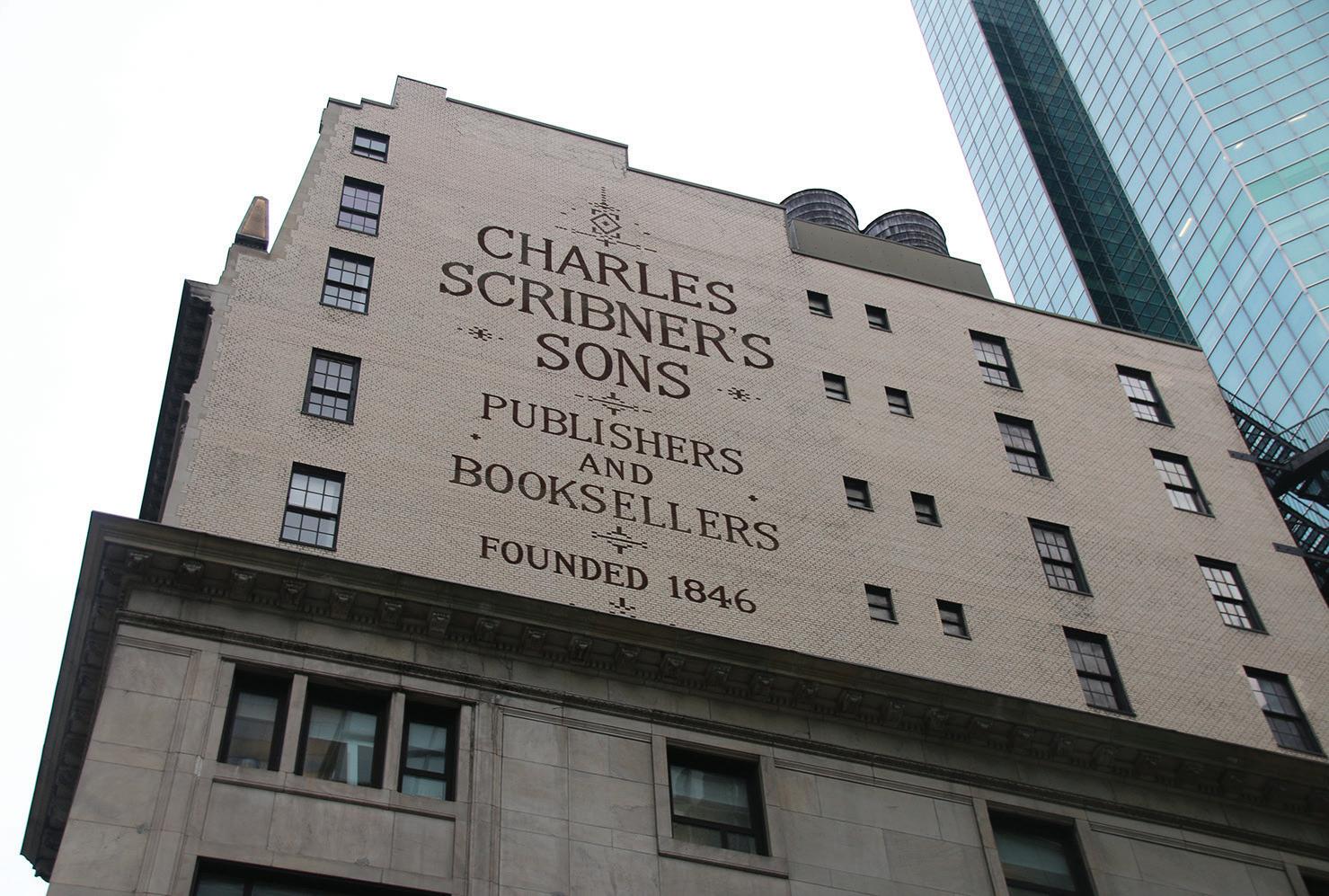
1922. The Scribner family has deep roots at Princeton, and in 1906 Charles Scribner II formally established and endowed the Princeton University Press. Princeton also houses the Scribner archives that includes the papers from F. Scott Fitzgerald’s estate.
As mentioned earlier, this is a story of authors and their close relationships with their editors and publishing house. Fans of Fitzgerald or Hemingway will be interested in the stories included on two of the most famous Scribner authors. Also interesting is the discussion on copyright and the complications that came from the Copyright Act of 1979 when Scribner’s was poised to lose the rights to Fitzgerald’s books. Despite a lucrative income from the classroom editions sold each year, the estate considered moving the rights to another publisher for various reasons. At the last hour, Fitzgerald’s daughter signed an extension of the rights to Scribners.
It is definitely a worthwhile read for those interested in publishing and the behind the scenes work of editors and authors relationships, at least in the twentieth century. The portions of the book specific to Scribner’s editors, such as Maxwell Perkins who worked with Fitzgerald and Hemingway among others, provide a keen insight into the authors and the dynamic of the editor/author relationship that they developed. Scribner also writes about their first female editor, Alice Dalgliesh. Hired in 1934, she developed and oversaw the children’s books department and was herself an author who published with Scribners.
Despite this being a relatively short book, it is dense and I did not devour it as quickly as I originally expected. The flow is choppy and the author admits to meandering in his retelling of the stories. This made it hard at times to follow his train of thought. Though it is laid out in chronological order, many times Scribner intertwines a side story or inserts an antidote about his finding a related letter or document in their archives decades after the story being relayed. As interesting as these tidbits are, they do make the main story difficult to follow. To use this as a research source, eBook format is ideal in that a keyword search will quickly get you to what you need and help you tie the threads together.
ATG Reviewer Rating: I need this available somewhere in my shared network. (I probably do not need this book, but it would be nice to get it within three to five days via my network catalog.)

29 Against the Grain / April 2024 <https://www.charleston-hub.com/media/atg/>
Pictures of the building for Charles Scribner’s Sons - Publishers and Booksellers at 597 Fifth Avenue, New York City in February 2017 (photos by column editor).
Booklover — Greased Groove
Column Editor: Donna Jacobs (Retired, Medical University of South Carolina, Charleston, SC 29425) <donna.jacobs55@gmail.com>
“The world was once again spinning in greased grooves.” is one of my all-time favorite ending lines from a movie and comes at the conclusion of “Cannery Row,” the 1982 film starring Nick Nolte and Debra Winger. The line is delivered by John Huston who narrated the film, which is an adaptation of two of John Steinbeck’s novels: Cannery Row and the sequel Sweet Thursday As many times as I have seen this movie (I own a copy), it only recently occurred to me to read the book, Cannery Row. And it is a charmer. It is easy to see how Steinbeck was heavily influenced by the environment in which he grew up in Salinas, California. Aspects of migration, immigration, the manual and itinerant labor of fishing, farming and the general rural nature of this greater area peek out through the words that create his works.
Sidebar: The film’s ending line doesn’t come from the book Cannery Row. However, one might speculate that the screenplay adapted the ending from this line in Sweet Thursday: “If only people would give the thought, the care, the judgment to international affairs, to politics, even to their jobs, that they lavish on what to wear to a masquerade, the world would run in greased grooves.” This quote doesn’t end the Sweet Thursday story either, but one can see that it influenced the ending narration in the film “Cannery Row.”
“Books are the best friends you can have; they inform you, and entertain you, and they don’t talk back.”
— John Steinbeck
John Steinbeck was awarded the 1962 Nobel Prize in Literature “for his realistic and imaginative writings, combining as they do sympathetic humour and keen social perception.” Spot on description for Cannery Row . Most avid readers are more familiar with Steinbeck’s Pulitzer-prize winning novel The Grapes of Wrath or his other famous titles: East of Eden or Of Mice and Men, but turn the pages of Cannery Row or Sweet Thursday if you want a sweet read that delivers the Nobel descriptive accolade.
Another sidebar: It is worth noting by this Booklover that several of Steinbeck’s works were translated to film. Here we will stay focused on the reading not the watching, especially in this era of book banning. Steinbeck’s books have found themselves running the gamut from required reading lists, banned by school boards, award winning and even burned. The American Library Association listed Steinbeck as one of the ten most frequently banned authors during the time period 1990-2004.

Ponder that thought and enjoy a few teasers from the written word. The first one comes mid story and paints a beautiful picture for a place that might not be considered picturesque. The second details Doc’s laboratory. Doc is a major character and the laboratory is the backdrop for many scenes. In the third, one meets Mack. In the film, Mack is played brilliantly by M. Emmet Walsh, just sayin’.
“Early morning is a time of magic in Cannery Row. In the gray time after the light has come and before the sun has risen, the Row seems to hang suspended out of time in a silvery light. The street lights go out, and the weeds are a brilliant green. The corrugated iron of the canneries glows with the pearly lucence of platinum or old pewter. No automobiles are running then. The street is silent of progress and business. And the rush and drag of the waves can be heard as they splash in among the piles of the canneries. It is a time of great peace, a deserted time, a little era of rest.”
“From this room come smells — formaline, and dry starfish, and sea water and menthol, carbolic acid and acetic acid, smell of brown wrapping paper and straw and rope, smell of chloroform and ether, smell of ozone from motors, smell of fine steel and thin lubricant of microscopes, smell of banana oil and rubber tubing, smell of drying wool socks and boots, sharp pungent smell of rattlesnakes, and musty frightening smell of rats. And through the back door comes the smell of kelp and barnacles when the tide is out and the smell of salt and spray when the tide is in.”
“Mack was the elder, leader, mentor, and to a small extent the exploiter of a little group of men who had in common no families, no money, and no ambitions beyond food, drink, and contentment.”
For this Booklover, it doesn’t get much better than this.
30 Against the Grain / April 2024 <https://www.charleston-hub.com/media/atg/>
Legally Speaking — That Word Doesn’t Mean What You Think It Means: Antitrust Edition
There’s nothing like a strangely-aggressive policy change to make me want to take a deep dive into an area of law that I know little about. In October of last year, the American Association of Law Libraries introduced a new Antitrust Compliance Policy.1 This policy was full of expansive language about prohibited activities, and its announcement was accompanied by two unrecorded informational webinars with a guest speaker from the Association’s outside counsel. The gist seemed to be: the first rule of Fight Club is, don’t talk about our vendors.
Suggested new problem activities ran the gamut from boycotting vendors to simply expressing negative opinions about vendor products on association-run forums or listservs. The policy included an explicit instruction not to engage in pricing or cost discussions of any kind on association platforms. The Annual Salary Survey was called into question. Increasingly detailed and incredulous questions about potentially prohibited activities abounded during the webinars, synthesized by the diplomatic interventions of the moderators. In short, the new policy seems to prohibit nearly every useful member activity of the association. So I had to ask myself: what drove this change?2
Enter the Department of Justice and the Federal Trade Commission. In February of 2023, the Department of Justice announced the withdrawal of a long-standing set of agency guidance documents that had created a so-called “safety zone” for certain information-sharing activities that might otherwise appear to trigger scrutiny for anti-competitive practices. 3 Primarily, but not exclusively, this allowed organizations to participate in market surveys with three objective criteria: 1) Data is collected by a third party; 2) Information is more than three months old; and 3) Information is sufficiently anonymized in the aggregate.4 There were three documents that provided guidance on these practices over time: Antitrust Enforcement Policy Statements Issued for Health Care Industry (1993), Statements of Antitrust Enforcement Policy in Health Care (1996), and Statement of Antitrust Enforcement Policy Regarding Accountable Care Organizations Participating in the Medicare Shared Savings Program (2011).5 You might be noticing one strange commonality amongst all of these documents: they’re explicitly targeted at the healthcare industry.
So how did their withdrawal set off a reaction in a library professional association? Despite the healthcaretargeted nature of the original guidance, “practitioners have

long viewed the Guidance as broadly addressing the exchange of information through third parties” and the “FTC has described the Guidance as providing a ‘safety zone’ for data exchanges (regardless of industry).”6 Because companies, including companies who are increasingly themselves members of professional associations, have “commonly participated in third-party surveys regarding historical labor conditions including wage and hiring surveys,”7 the threat of the Guidance withdrawal is implicit.
It all seems to come down to the “dramatically increased civil and criminal enforcement activity” of the DOJ and FTC in recent years.8 President Biden’s FTC chair appointee, Lina Khan, is described by news organizations as having “steered the agency to its most aggressive antitrust enforcement in decades” and the DOJ is described as also having increased enforcement.9 And yet, it is the DOJ who led the charge in revoking the previous guidance — the FTC took another five months to issue a similar withdrawal.10
Professional associations are rightfully wary of litigious threats from the mega-corporations who participate in their organizations in the dual capacity of members and vendors,11 and of the threat of overzealous enforcement of antitrust law. But it is still the law of the land, regardless of agency guidance, that “exchange of price data and other information among competitors does not invariably have anticompetitive effects” and is therefore not a per se violation of the Sherman Act. 12 But all of these information-sharing activities seem far different from the grasping many-tentacled Standard Oil of antitrust’s origins. So it makes me wonder: how did antitrust law get here, to this point where it feels as if it is being wielded to protect the trade secrets (if you believe that pricing can ever be a trade secret)13 and business interests of corporations rather than the right to competitive markets and pricing for the members of the professional associations who deal with them?
The greatest enforcement concern tends to be against economic boycotts. The history of the Sherman Act begins with the efforts to dismantle the “trusts” of the late 19th and early 20th centuries, but despite the way the law has been deployed over the years, early debates surrounding the Sherman Act and related antitrust proposals indicated that there was a recognized
31 Against the Grain / April 2024
<https://www.charleston-hub.com/media/atg/>
Editors:
Jack
<jmontgomery@georgiasouthern.edu>
LEGAL ISSUES Section
Bruce Strauch (Retired, The Citadel) <bruce.strauch@gmail.com>
Montgomery (Georgia Southern University)
Column Editor: Abby L. Deese (Assistant Library Director for Reference and Outreach, University of Miami School of Law) <aldeese@law.miami.edu>
benefit to allowing “labor combinations,” or trade unions, to similarly consolidate power.14 Under U.S. antitrust law, there is a difference between the objective of unions to organize for “self-protection” and the objective of members of a professional association to organize in order to force corporations to take more favorable actions.
This difference has played out in several major cases involving professional associations over the years. When the Superior Court Trial Lawyers Association tried to boycott the District of Columbia over inadequate compensation related to indigent defense provided under the DC Criminal Justice Act in 1983, the Court of Appeals for the DC Circuit found that the activism of the association might be subject to First Amendment protection.15 However, the Supreme Court disagreed, pointing out that “every concerted refusal to do business with a potential customer or supplier has an expressive component” and that creating an exception from the per se antitrust laws based on this common element would “create a gaping hole in the fabric of those laws.”16 As such, the boycott was a “naked restraint of price” and a per se violation.17
In 1982, in finding that a nonprofit trade association could be liable for treble damages for the actions of its agents, the U.S. Supreme Court was particularly interested in the fact that a competitor used the association’s internal procedures to injure the business of the plaintiff corporation.18 In the dissent, however, three Justices disagreed that encouraging “plaintiffs to seek recovery from nonprofit organizations, rather than from the commercial enterprises that benefited from the violation [would] facilitate proper antitrust enforcement.”19 At the same time, the potential for “anticompetitive activity” is great when “many of [the organization’s] officials are associated with members of the industries regulated” by that same organization’s codes.20
The anti-competitive power of standard-setting organizations was explored again with the American Bar Association in 1995, when the FTC alleged that “law school accreditation program[s] [were] controlled by law school faculty, who were using the ABA’s power over accreditation to force law schools to inflate faculty salaries and benefits.”21 The result was a consent decree that, among other things, prohibited the ABA from collecting salary
data and using it in setting accreditation standards. While law school faculty arguably intended their efforts to advocate for better compensation, the courts have found that these efforts are anti-competitive price-fixing when the member collective leverages its accreditation powers in order to achieve its goals.
What strikes me the most about the timing of these professional association cases and the original issuance of the DOJ and FTC guidance documents creating safe zones for certain information-sharing activities is that the guidance came after. And yet, the cases that came before largely did not arise because of the kinds of information-sharing shielded by the guidance. From conversations with librarians who are members of other, much larger, library associations, and particularly one with more complex legal structures and more involved lobbying activities, I gather that the antitrust conversations are not so grim elsewhere in libraryland.22 So I come back once again to the question: why this powerful reaction now to the revocation of the guidance?
I suspect that the heart of the matter is an institutional and corporate reaction to a robust and rejuvenated labor movement,23 and to the growing use of economic boycotts to put pressure on institutions and governments.24 Unions and boycotts make every C-suite nervous, whether they’re in a nonprofit or a Fortune 500.
I have three thoughts in conclusion. The first is that professional associations are not labor unions, and we can’t (and sometimes shouldn’t) rely on them to support us in advocating for fair wages. We need a different solution.25 The second is that a professional or trade association is most likely to be a “walking conspiracy” when competitors occupy a dual role as members and vendors — which is perhaps a dual role we should not encourage or allow in our professional associations.26 And the third is that if the antitrust and defamation threats have reached the point where professionals can’t engage in frank discussions about products and services crucial to their business purposes, then we need to have a conversation about whether professional associations have been effectively reduced to social clubs — and whether we might just need an Anti-SLAPP for Anti-TRUST.
I’ll see you off-list.
32 Against the Grain / April 2024 <https://www.charleston-hub.com/media/atg/>
Endnotes
1. American Association of Law Libraries, Antitrust Compliance Policy (Sept. 25, 2023), https://www.aallnet.org/about-us/whatwe-do/policies/antitrust-compliance-policy/ (membership required).
2. Spoilers: This is relevant to anyone who belongs to a professional association.
3. William T. McEnroe et al, “DOJ’s Rescission of Longstanding Guidance Creates Uncertainty for Market Benchmarking Activities,” LawFlash: Morgan Lewis, February 7, 2023, https://www.morganlewis.com/pubs/2023/02/dojs-rescission-of-longstandingguidance-creates-uncertainty-for-market-benchmarking-activities.
4. Sheldon Klein, “Don’t Ask, Don’t Tell? The Antitrust Risk of Conducting and Participating in Market Surveys Increase,” Client Alerts: Butzel, February 13, 2023, https://www.butzel.com/alert-dont-ask-dont-tell-the-antitrust-risk-of-conducting-andparticipating-in-market-surveys-increase
5. McEnroe, “DOJ’s Rescission of Longstanding Guidance.”
6. McEnroe, “DOJ’s Rescission of Longstanding Guidance.”
7. McEnroe, “DOJ’s Rescission of Longstanding Guidance.”
8. “DOJ Withdraws ‘Out of Date’ Antitrust Enforcement Guidance Relating to Healthcare Providers,” McGuireWoods, February 8, 2023, https://www.mcguirewoods.com/client-resources/alerts/2023/2/doj-withdraws-out-date-antitrust-enforcement-guidancerelating-healthcare-providers/
9. Jim Tankersley, “An Emboldened F.T.C. Bolsters Biden’s Efforts to Address Inflation,” New York Times, February 27, 2024, https:// www.nytimes.com/2024/02/27/us/politics/biden-ftc-competition-mergers.html.
10. “Federal Trade Commission Withdraws Health Care Enforcement Policy Statements,” Federal Trade Commission, July 14, 2023, https://www.ftc.gov/news-events/news/press-releases/2023/07/federal-trade-commission-withdraws-health-care-enforcementpolicy-statements.
11. SPARC’s Landscape Analysis Report from 2019 is an eye-opening introduction to the impact of corporate business models and acquisitions on a contracting academic publishing market. Claudio Aspesi et al. “SPARC Landscape Analysis,” March 29, 2019, https://doi.org/10.31229/osf.io/58yhb
12. United States v. U.S. Gypsum Co., 438 U.S. 422, at n.16 (1978), available at https://supreme.justia.com/cases/federal/us/438/422/
13. Neal F. Weinrich, “When Is Pricing Information a Trade Secret,” February 17, 2014, https://www.bfvlaw.com/when-is-pricinginformation-a-trade-secret/.
14. As said Henry D. Clayton of Clayton Act fame: “A mere organization for self-protection is not a trust and is not contrary to good government,” and “You cannot treat labor as a mere commodity.” 33 Cong. Rec. Appx. 333 (1900) (speech of Rep. Henry D. Clayton).
15. FTC v. Sup. Ct. Trial Lawyers Ass’n, 493 U.S. 411, 411 (1990), available at https://supreme.justia.com/cases/federal/us/493/411/ (hereinafter Trial Lawyers).
16. Trial Lawyers, at 431-32.
17. Trial Lawyers, at 412.
18. American Soc. of Mechanical Engineers, Inc. v. Hydrolevel Corp., 456 U.S. 556, 571 (1982), available at https://supreme.justia. com/cases/federal/us/456/556/. (hereinafter Hydrolevel)
19. Hydrolevel, at 591.
20. Hydrolevel, at 571.
21. “Recent Enforcement Actions By The Antitrust Division Against Trade Associations,” U.S. Department of Justice, December 31, 1969, https://www.justice.gov/atr/speech/recent-enforcement-actions-antitrust-division-against-trade-associations
22. The somewhat dated but publicly available ALA Legal Framework, by comparison, devotes one paragraph to antitrust, and only briefly alludes to information-sharing risks in a 2008 update. See “ALA Legal Framework: Twenty Questions,” American Library Association, 2006, https://www.ala.org/ala/ourassociation/governingdocs/legalguidelines/legalframework/alalegalframework. htm and “ALA Legal Framework: Twenty questions and answers,” American Library Association, last updated March 12, 2008, https://www.ala.org/aboutala/mleader/factsheets/legalframework
23. Wyatte Grantham-Phillips, “Labor Movements Are Seeing Historic Victories This Year. Can Unions Keep Up The Momentum?” PBS News Hour, October 11, 2023, https://www.pbs.org/newshour/economy/labor-movements-are-seeing-historic-victoriesthis-year-can-unions-keep-up-the-momentum
24. Make Me Smart, “Boycotts, Buycotts and the Rise of Consumer Activism,” March 12, 2024, https://www.marketplace.org/shows/ make-me-smart/boycotts-buycotts-and-the-rise-of-consumer-activism/.
25. And perhaps that solution is as simple as the public Google Sheet, a tool wielded with great effect during the #MeToo movement and in sharing salaries in professions where pay parity is a constant battle. See, Tanya Basu, “How Google Docs Became the Social Media of the Resistance,” June 6, 2020, https://www.technologyreview.com/2020/06/06/1002546/google-docs-socialmedia-resistance/.
26. The caveat to this is that, increasingly, even librarians are competitors, particularly those of us caught in the corporatization of higher ed.
<https://www.charleston-hub.com/media/atg/>
33 Against the Grain / April 2024
Questions & Answers — Copyright Column
Column Editor: Kyle K. Courtney (Director of Copyright & Information Policy, Harvard Library) <kyle_courtney@harvard.edu>
QUESTION FROM A GRADUATE PROGRAM LIBRARIAN:
Many of our dissertation and thesis writers always have questions about whether they should “get copyright” by registering for copyright as part of a formalized process with the U.S. Copyright Office. They are also curious about the “proper” copyright notice. What should I advise these writers about registration and notice? Do they have to register to get copyright and deposit a copy of their work?
ANSWER: This is a very common question — and especially from students who are writing now and planning to publish their work formally as a thesis or dissertation. The good news is that copyright applies automatically whenever a work is original and is fixed in tangible form. It does not require registration. Under the law, the “owner” of the copyright is the creator, and there is no formal registration required for the thesis and dissertation writers to “get copyright.” However, the U.S. Copyright Office does encourage registration of your work through a series of legal and policy-based incentives.
First, registration establishes a legal claim to copyright with the Copyright Office. After you go through the registration process, a certificate of registration is awarded to the creator. This document creates a verifiable public record of the significant facts about the work, including: the title, the author, information about the claimant or copyright owner (they could be different), the year of creation, and any additional information which can include information about whether the work is published, has been previously registered, or includes preexisting material.
Second, registration is a prerequisite to filing a copyright infringement claim in a federal court. So, while an author may be considered the creator of the work under the automatic protection of the law, the author cannot enforce their rights as the owner unless they register with the Copyright Office. This registration serves as prima facie evidence that your copyright is valid, the certificate is accurate, and when registration is made prior to infringement or within three months after publication of a work, a copyright owner is eligible for statutory damages, attorneys’ fees, and costs. These categories of damages and fees are some of the costliest portions of copyright litigation. Statutory damages can reach into the hundreds of thousands in fines per infringement. And attorney’s fees and court costs, depending on the size and scope of the litigation, can range from thousands to, potentially, millions, if the case is taken on through trial, appeal, and other courts.
Third, registration of an author’s work also permits a copyright owner to share the work’s information with the U.S. Customs and Border Protection (CBP). CBP is a part of the Department of Homeland Security and is an administrative agency with law enforcement powers that allow for search, seizure, and arrest. However, it also has a special authority to make substantive determinations regarding infringement of copyrights pursuant to the Copyright Act of 1976 and the Digital Millennium Copyright Act (DMCA) of 1998. This authority is what enables the CBP to monitor the U.S. border for any potential pirated and infringing copies of an author’s work. If the CBP determines that items coming over the border are clearly illegal infringements of a
protected and registered U.S. work, the infringing items are subject to seizure, forfeiture, and, possibly, destruction.

The critical component of all these advantages offered by the U.S. Copyright Office is the registration. Fortunately, registration can be made at any time within the life of the copyright. A basic application for copyright registration can be filed by the author or owner of an exclusive right in a work, the owner of all exclusive rights, or an agent on behalf of an author or owner. All that is required is a form, a fee, and a copy (or copies) of the work being registered and deposited with the Copyright Office.
As far as deposit, we covered a portion of this in a previous column, but it is worth revisiting here. The United States Court of Appeals for the District of Columbia Circuit ruled a portion of the Copyright Act was constitutional in a copyright case on mandatory deposit. The case, Valancourt Books v. Garland, addressed the constitutionality of Section 407 of the Copyright Act, which mandates the deposit of copies or phonorecords for the Library of Congress.
Valancourt Books, a print-on-demand publisher specializing in rare fiction, found itself at odds with the Copyright Office when asked to deposit copies of several hundred books under Section 407. Valancourt had argued that the deposit requirement imposed undue financial burden and constituted a violation of the Takings Clause of the Fifth Amendment.
The crux of the case rested on whether the mandatory deposit requirement, particularly as applied to a print-on-demand publisher like Valancourt, was constitutional. Section 407 of the Copyright Act requires the owner of copyright work published in the U.S. to deposit two complete copies of the best edition of each copyrighted work with the Library of Congress. Failure to make a deposit could result in fines. However, failure to deposit does not result in any loss of copyright protection (copyright protection in a work is generally automatic the moment the work is creative and fixed).
In many cases, these Section 407 deposits also satisfy the copyright registration deposit requirement under Section 408 if the depositor includes the copyright registration form and filing fee.
The court held that the Copyright Office’s demands for physical copies of works under Section 407 of the Copyright Act is an unconstitutional taking of property in violation of the Fifth Amendment. However, the Court noted that its decision did not evaluate the constitutionality of Section 407 as enforced through requests for electronic copies of works.
QUESTION FROM A REFERENCE LIBRARIAN: A few large international publishers have updated their websites with revised copyright statements at the bottom of their webpages, explicitly “reserving rights” and preventing actions like text
34 Against the Grain / April 2024 <https://www.charleston-hub.com/media/atg/>
& data mining and artificial intelligence training. Do these statements at the bottom of the webpages change the fair use case for these activities?
ANSWER : First, let’s be clear: These statements at the bottom of a website exist within the purview of contract law (or licensing “Terms of Use”). So, before we get to the fair use aspect of the question, a discussion about the principles of contract law that will help guide the analysis to this question.
Broadly speaking, contract law is about enforcing promises. A contract is a promise or a set of promises, which the law recognizes as a sort of “duty” and provides remedies when that promise is breached. A license is a legal interest created by a rightsholder that grants use-privileges to a non-rightsholder. In other words, a license is a type of contract — it is a “contract not to sue.” (Therefore, we’ll occasionally use the terms “license” and “contract” interchangeably.)
As you can imagine, contract and licensing agreements can determine what a user can do within legal bounds, including text and data mining with AI-based tools. However, this depends on whether the contract or license is valid in the first place. Whether a contract or license is valid depends on how it’s entered into. Two key aspects of this are “acceptance” and “mutuality.”
“Acceptance” means that when one party offers a contract, the offer must be clearly accepted by the other party — either through words, actions, or the performing the obligations as called for in the contract. “Mutuality” is a “meeting of the minds” between the contracting parties. In other words, the contracting parties must have understood and agreed to the basic substance and terms of the contract.
With these principles in mind, let’s take a look at the language that sits at the bottom of a webpage, known as “browse-wrap licenses,” that are at issue here. A browse-wrap license is a type of non-negotiable, unilateral contract where explicit agreement was not obtained. This is a very different kind of license than the standard negotiated vendor license that libraries work with all the time. Browse-wrap licenses are typically a fixed display of the terms and conditions (or “Terms of Service/Use”) for using the webpage or the resource, usually found through a hyperlink or language in the footer of the page. This indicates to the user that by using the resource, they are bound by those terms.
These browse-wrap agreements may be valid (and therefore enforceable), but only if there was acceptance or mutuality (a “meeting of the minds”). A study by two law professors in 2019 found that 99% of the 500 most popular U.S. websites had terms of service written as equally complex as an academic journal article, which makes them possibly inaccessible to most humans. (Uri Benoliel & Shmuel I. Becher, “The Duty to Read the Unreadable,” 60 B.C. L. Rev. 2255 (2019))
How can someone “accept” a contract if they do not understand it?
However, acceptance and mutuality may be fairly implied based on the user’s conduct after the user is put on actual or reasonable notice that their access or use is subject to these terms and conditions. An example of such conduct could be continued access to or use of the website, database, or service; or, the conduct could be that the user downloaded the product.
A strategic question to ask for on-campus projects involving TDM or AI training is: How will you access the material necessary for the use? Answers will vary. Some access will certainly be via a library-licensed resource, which is sometimes part of institutional-wide access. Other access might be through an individual subscription containing an agreement that you clicked on in order to access the material. And some access might be through public-facing websites featuring terms of use. Each of these examples have varying implications for whether a valid contract exists. But simply because the owner of the website puts language at the bottom of their website, does not mean that the language is binding.
Now, the very core of the fair use doctrine is such that the user does not need permission from a rightsholder to make fair use of a work. A license or contract is inherently a set of permissions or restrictions. While the nature of the licensed content can change the fair use analysis based on the characteristics of the work, the fact that it is licensed does not in itself change the fundamental four-factor analysis that exists under the fair use statute.
The revised copyright statements at the bottom of websites do not inherently change the fair use case for TDM and AI activities, because those statements operate within the realm of contract law.
35 Against the Grain / April 2024 <https://www.charleston-hub.com/media/atg/>
And They Were There — Reports of Meetings 2023 Charleston Conference
Column Editor: Sara F. Hess (Business and Entrepreneurship Librarian, 309 Paterno Library, Pennsylvania State University, University Park, PA 16802) <sfh5542@psu.edu>
Column Editor’s Note: Thanks to the Charleston Conference attendees, both those who attended on-site and virtually, who agreed to write brief reports highlighting and spotlighting their 2023 Charleston Conference experience. In 2023, the conference moved to an asynchronous format: the in-person conference (November 6-10) was followed two weeks later by a virtual week (November 27-December 1) that included online-only sessions and presentations as well. Conference registrants had the opportunity to view recordings and see slides (if available), to re-visit sessions they saw “live,” or to visit sessions they missed. Without a doubt, there were more Charleston Conference sessions than there were volunteer reporters for Against the Grain, so the coverage is just a snapshot. In 2023, reporters were invited to either provide general impressions on what caught their attention, or to select individual sessions on which they would report.
There are many ways to learn more about the 2023 conference. Please visit the Charleston Conference YouTube site, https://www.youtube.com/user/CharlestonConference/ videos?app=desktop, for selected interviews and videos, and the conference site, http://www.charleston-hub.com/thecharleston-conference/ for links to conference information and blog reports written by Charleston Conference blogger, Donald Hawkins, http://www.charleston-hub.com/category/blogs/ chsconfnotes/. The 2023 Charleston Conference Proceedings will be published in 2024, in partnership with University of Michigan Press. — SFH
VENDOR SHOWCASE
What I Learned After Visiting the 2023 Charleston Conference Vendor Showcase
Reported by Ramune K. Kubilius (Northwestern University, Galter Health Sciences Library & Learning Center) <r-kubilius@northwestern.edu>
The vendor showcase at the Gaillard Center was not unlike a busy marketplace: hustle bustle, opportunities to chat at “stations” (tables) to “find out about the wares” and also enjoy tantalizing refreshments. In 2023, “C’s” came to mind — chatting, comparing, contrasting, currency, and curiosity. “Open” was touted — “Subscribe to Open” in 2025 (a society publisher), “author-choice open access publishing” (a new small niche publisher), and so on. Vendor and publisher partnerships were in evidence, as were “brave new world” products that may be attempts to tap into perceived marketplace gaps or needs. One can’t argue with a later mention by closing conference session speaker, Derek Law, of “new products from old companies.” Indeed, stopping at tables of known vendors and publishers in the showcase venue often revealed new product announcements, promised upgrades, and enhancements. Law’s actionable item: “new tools to add access,” for many of us was more likely “new

products and resources to put on our radars.” A return on invested time in the vendor showcase was the guarantee that one saw a lot, but some might also agree with Lisa Janicke Hinchliffe, who, in her Scholarly Kitchen blog posting of November 21 wrote about “high level trends and surprise about what she didn’t see.”
The conference blog report by Don Hawkins the closing session: Closing Session | Charleston Hub (charleston-hub. com) and his report about the vendor showcase: The Vendor Showcase | Charleston Hub (charleston-hub.com)
POSTERS
Top 3 Things I Learned After Viewing the 2023 Charleston Conference Posters
Reported by Shelby Carroll (Clemson University) <sec8@clemson.edu>
1. Librarians can pivot like they play professional basketball!
Artificial intelligence was a standout presentation topic at the Charleston Conference this year and posters were no exception. Librarians have quickly adjusted their research, outreach, and teaching to adopt this new tool into their spaces. Posters ranged from improving workflows using generative AI to individuals that have integrated AI data visualization into their collections development decisions. What was most evident is that the library community is not shying away from this new (and sometimes daunting) application of technology.
2. Collections for the collective.
There were many discussions on the nitty gritty of acquisitions and diversifying collections using intentional and reparational techniques. Some posters emphasized the importance of DEIAcentered collecting choices and others approached the topic from a user-centered perspective, sharing how collections have become more individualized and specialized. There was a theme of collecting for more purposes than academic — supplementary, unique collections, and collections in varied formats were popular topics. There’s no one-size-fits-all approach to collecting, but there were a lot of great applicable ideas laid out at this year’s poster session.
3. There’s so much to explore with open access.
Open access has dominated the conversations within libraries for the past decade and these are still going strong. Several posters focused on the adoption of transformative agreements in their institutions and experiences with this new form of openness. Others discussed the need for reproducibility with open data and general need for more open science. The open access movement has spurred some interesting self-exploration within institutions, as well as conversations around scholarly communication.
36 Against the Grain / April 2024
<https://www.charleston-hub.com/media/atg/>
Top 3 Things I Learned After Viewing the 2023 Charleston Conference Posters
Reported by Linnea Shieh (Stanford University) <laiello@stanford.edu>
1. While I wouldn’t call this a new revelation for me, the Charleston posters confirmed just how many hats are worn by a typical collections librarian.
I expected a few topics to dominate the poster sessions (as felt true for the conference’s presentations), but instead the diversity of content was pleasingly engaging and refreshing. We had a few posters about AI and OA resources of course, but also about managing work roles, discoverability, cyberthreats, collection policy, decolonization, ethnography, streaming video evaluation, and many more. The hall was crowded and quite loud, as every attendee found something worth a lengthy conversation with a colleague.
2. It is oft repeated that budgets everywhere are flat or declining, but Coastal Carolina presents a positive and uplifting story of how to achieve growth through effective communication with university administration.
In 20 years CCU had grown from 3k to 10k students but library budgets had not increased to support the new programs. The team used run-of-the-mill data reports from peer institutions to prove to administrators how far they’d fallen behind. Now budgets are up, and a building that was to become an auditorium will instead be a library. The team believes the key to their success was nailing the timing.
3. It is well known that the California Digital Library is a leader in executing OA agreements for the University of California system.
But by talking to them about their strategy and approach, what I found most interesting was how collaboration throughout the OA ecosystem was critical to their innovation. APCs are paid via a multi-payer model, and the team partners with faculty committees and with publishers to put focus on expediting publication workflows. The CDL is an interesting case worthy of examination by libraries trying to go it alone in managing OA at their institutions.
REFLECTIONS
Southern Hospitality Meets Open Access: Insights from the Charleston Conference
Reported by Vivi Billeso (ChronosHub) <vb@chronoshub.io>
Attending the Charleston Conference for the first time was more than just a professional endeavor; it was a delightful immersion into Southern charm and hospitality that set it apart from other conferences. The sunny weather, combined with an international flair, created a unique atmosphere that left a lasting impression. It was evident that the U.S. is increasingly embracing Open Access (OA), with conversations buzzing about how OA is reshaping library workflows.
I might be viewing the world through the lens of my role at ChronosHub, but the transformation in libraries was a focal point, with discussions revolving around hiring OA staff, managing agreements, and establishing efficient workflows.
Interestingly, the prevailing talk was often about reporting on this transformative journey. Many still rely on spreadsheets, but questions about scalability and efficiency were at the forefront. The urgency stemmed from articles needing to comply with federal research funders’ OA policies, aligning with conditions familiar to European funders and Plan S, intensified by the Nelson OSTP memo.
For ChronosHub, specializing in OA management, the conference was a source of enthusiasm about the future of the industry. The evolving landscape, with libraries investing in OA resources and adapting to new workflows, signaled a positive trajectory.
A highlight of the conference was the one-day vendor showcase, providing a platform for engaging conversations. The format was particularly appealing, offering a conducive environment for meaningful interactions. The success of this showcase emphasized the importance of such forums in fostering collaboration and advancing technological solutions in the industry.
In conclusion, the Charleston Conference was a blend of Southern hospitality, OA insights, and a showcase of innovation. It not only provided a unique perspective on the state of the industry but also left us with a renewed sense of optimism for the future of open access management.
Top 3 Things I Learned about the 2023 Charleston Conference
Terry Brandsma (University of North Carolina at Greensboro)
<twbrands@uncg.edu>
I was fortunate to be given the opportunity to present on the collection reduction plans my library developed in preparation for a comprehensive renovation, including the complete reconfiguration of our stacks footprint. As the system librarian, my interaction with “issues in book and serial acquisition” is only tangential so I was excited to attend this conference for the first time and learn as much as I could. I reviewed the preliminary schedule to find topics that were applicable to me and messaged a few vendors and colleagues to arrange a few meetings. I knew that this conference was well attended, but I was a bit surprised by the number of inperson attendees (2000+) and the extensive programming. So here are three “tips” that made this conference successful for me. Tip #1: The conference app (Whova this time) was a huge time saver as I navigated the many presentations and events held in the three conference locations! Selecting sessions ahead of time allowed me to easily and quickly see when and where I needed to be. Tip #2: Wear comfortable shoes, and dress in layers. While the three conference locations were relatively close to each other, I did quite a bit of walking to get from one session to the next. I chose not to use the shuttles as the weather was perfect, but they were available for those who needed them. And tip #3: Attend vendor events that are held outside of the conference schedule, usually during the lunch break or in the early evening. I was able to talk directly to vendor representatives and executives, interacting much more closely than I had expected. Overall, the conference surpassed my expectations, and I hope to attend again next year!
This concludes the General Reports we received from the 2023 Charleston Conference, however, watch for Session Reports from the 2023 Charleston Conference to begin appearing in upcoming issues of Against the Grain. In the meantime, you can visit the Charleston Conference YouTube site for selected interviews and videos, and the Charleston Conference site for links to conference information and blog reports written by Charleston Conference blogger Donald Hawkins.
37 Against the Grain / April 2024 <https://www.charleston-hub.com/media/atg/>
Wandering the Web — April Showers Bring May Flowers: Online Reference Sites for Hobbyist Gardeners
Column Editor: Lesley Rice Montgomery, MLIS (Catalog Librarian, Tulane University Libraries’ Technical Services Department)
Reaping What You Sow: Inspirational Websites to Get You Started
Gardening is one of the oldest occupations. For centuries, humans have supplemented their food supplies with homegrown fruits and vegetables, herbs and other leafy edibles, have decorated their living spaces with beautiful flowers, and have tried to keep domiciles cool during blazing hot summer months with surrounding shade trees. Horticulturalists go by many names including farmers, arborists, floriculturists, landscape architects, plantspersons, nurserymen, lawn-care specialists, and so on. No matter how you view your participation in the honorable tasks of cultivating soil, sowing, growing and harvesting crops, sometimes the prospect of creating a new garden can be daunting for the hobbyist. Questions might arise regarding design, like whether or not you should consign flowers and vegetables to a pot, to an aluminum bin, to a raised and tiered garden, or should you just start digging in the ground and hope for the best?
To provide inspiration and hopefully encourage you to get planting, here is a lovely website that will connect you to 10 great gardening websites you must read, https://www.treehugger. com/great-gardening-websites-4858719, an article that appears in the Treehugger blog. Mr. Gonzalez’ article serves as a onestop tour of exemplary websites. It is his stated intention to cull the millions of retrieved items from a standard search, ignoring SEO-curated search results, and thereby to provide a list of high-quality gardening websites. The resulting list, which is not presented in any particular order, starts with Kitchen Gardeners International, an online community of people who advance the concept of self-reliance by maintaining sustainable food systems. Full disclosure: Their web link is broken! This is a good example of how private websites such as Treehugger often will not continue to police the URLs buried within their site, once a specific article has been published online. Other hyperlinks work, such as for Chiot’s Run, a chronicle of an organic life at https://chiotsrun.com/. This is a long-running blog, last updated as of October 2020. The unnamed blogger has done a fabulous job of archiving postings since June 2008, covering topics as varied as using kale as an ornamental, setting up an edible garden in Maine — the blogger’s home base — and helpful hints on covering an awkward yard space with a beneficial and scenic pollinator bed. The website is streamlined, minimalist, and the illustrative full-color photographs are nicely edited.
Another link in 10 great gardening websites you must read is The Royal Horticultural Society’s site at https://www.rhs.org. uk/. You can become a member, which might be useful if you live anywhere near the United Kingdom, but the site itself provides a wealth of information on horticultural matters, with an array of articles, blogs within the site, even tips for how to develop a career in the RHS. Databases for finding gardens and flower shows, how to sign up for listservs that will connect you with

fellow gardening enthusiasts, a gorgeous gift shop that sells reproductions of vintage botanical plates and high-definition photographs of famous gardens… It is all here on this one site. Other hyperlinks in 10 great gardening websites you must read are viable and all are maintained by bloggers.
In fact, the Treehugger blog itself is worth browsing. Founded by self-professed eco-advocate Graham Hill in 2004, this extensive, well-organized blog is said to be “the only modern sustainability site that offers advice, clarity, and inspiration for both the eco-savvy and the green-living novice. With 2.6 million monthly users, Treehugger is the world’s largest information site dedicated to driving sustainability mainstream.” https://www.treehugger.com/about-us-5024862 The site owners promise to report gardening information with integrity, to trust science and never preach, and to carefully cite all sources of information. They report news stories on the environment, including items of interest about wildlife, as well as cover topics related to gardening. Natural cleaning, five attributes of a successful gardener, and thoroughly documented planting guides at https://www.treehugger.com/plantingguides-4846052 are all interesting articles and relevant for today’s environmentally savvy citizens.
Back to Basics
Better Homes & Gardens has been around for decades as a print magazine, the company has published DIY books, and nowadays has an online site. The link at https://www.bhg.com/ gardening/yard/garden-care/ten-steps-to-beginning-a-garden/ shows beginners how to start a garden, with the information broken down into ten easy steps. Better Homes & Gardens first helps you to decide on the type of garden you might want to plant — an herb garden, a flower garden, and whether to plant annuals or perennials. The directions proceed to discuss matters of design, how to clear the ground and prepare the soil, the timing for planting vegetables and flowers, lets you know how often you should water depending on the type of soil, if or when you should mulch, and the list finishes with tips on continuing garden maintenance. This article is attractively illustrated, is concise and very useful.
Almanac at https://www.almanac.com/ is a modern take on The Old Farmer’s Almanac. The website is comprehensive. On the home page, they have internal links to plant growing guides. These guides are fully indexed, with links to vegetables, fruits, herbs, flowers, foliage plants, trees, shrub and vines, and houseplants. Once you click on the broader topic, each subtopic lists page after page of full-color links. If you click on the herbs link, the illustrated index allows you to poke on the internal links for various herbs — basil, chives, cilantro (coriander), dill, and so on. For example, the basil web link provides the botanical name, plant type, sun exposure, soil pH needed to grow the herb, the blooming time, planting timing, how to harvest and store the herb, what pests or diseases might impact your crop,
38 Against the Grain / April 2024 <https://www.charleston-hub.com/media/atg/>
and anecdotal wit and wisdom including an old Italian saying, “Where salt is good, so is basil.” This is a fun site to browse through.
Forbes at https://www.forbes.com/home-improvement/ lawn-care/how-to-start-a-garden/ might seem like an unlikely source for gardening advice. Forbes’ article, however, is excellent. The Ultimate Guide for how to Start a Garden from Scratch discusses the many benefits to gardening while listing fundamental processes based on your local microclimate, soil type, the time of year; tells you how to grow plants vertically, how to hire landscaping contractors, how to create a Zen garden; and provides so many more helpful tips to help your garden flourish.
Know Your Garden Growing Season
Harvest to Table — https://harvesttotable.com/know-yourgarden-growing-season/ — Longer days are here, it’s still early springtime for those of us in the Northern Hemisphere, and now is the time to plant cool-season vegetables. The site Harvest to Table at https://harvesttotable.com/ is another full-color site that is packed with beautiful photographs, gardening hints, and a lengthy cross-referenced index of the entire site. A-Z topics include an indexed page on growing vegetables, listed alphabetically by the name of each vegetable, with live links leading you from how to plant and grow artichokes to how to grow zucchini. Less common vegetables are discussed, including cardoon, which evidently is like a delicate celery that you eat after blanching; various cresses; mizuna, which is an Asian leafy green that’s good to eat in salads or to cook … sort of like mild mustard greens with a light cabbage flavor; and salsify, which is a carrot-like, off-white colored root that tastes a little like an oyster! Other items on Harvest to Table’s drop-down menu include page after page discussing ornamental plants, gardening basics, courses like the Vegetable Garden Grower’s Masterclass that is on sale for $99, lowered from $299, podcasts, and another thoroughly indexed list of kitchen tips and recipes. You can join the gardening family to get the latest tips; otherwise, you can simply spend hours perusing this exceptional site.
Maintaining Your Garden
Now that you have successfully designed, planted and grown your garden, how do you keep it going so you can continue to enjoy the fruits of your labor? There are numerous online articles on garden maintenance. They all essentially follow the same pattern, emphasizing proper watering, how to destroy weeds, prevent diseases, and protect your garden from pests, whether bugs or critters or invading plant species. MasterClass’s article demonstrates how to increase the quality and longevity of your garden. This quick read at https://www.masterclass.com/ articles/how-to-keep-plants-alive is an excellent mini course on keeping your garden safe from weeds, flooding and other menaces. Happy gardening!
References
Albert, S. (2024). Vegetable garden growing season. Harvest to Table. https://harvesttotable.com/know-your-garden-growingseason/
Beck, A. (2024, March 5). How to start a garden: 10 easy steps for beginners. Better Homes & Gardens. https://www.bhg.com/ gardening/yard/garden-care/ten-steps-to-beginning-a-garden/ Chiotsrun.com. (2020, October 1). Chiot’s run, a chronicle of an organic life. https://chiotsrun.com/
Finley, R. (2021, June 7). 10 ways to care for your garden: How to keep plants alive. MasterClass. https://www.masterclass.com/ articles/how-to-keep-plants-alive
Fisher, T. (2024). About us . Treehugger. https://www. treehugger.com/about-us-5024862
Gonzalez, R. (2018, October 11). 10 great gardening websites you must read. Treehugger. https://www.treehugger.com/greatgardening-websites-4858719
Harvest to Table. (2024). Harvest to Table. https:// harvesttotable.com/
RHS. (2024). The Royal Horticultural Society. https://www. rhs.org.uk/
Treehugger. (2024). Planting guides. Treehugger. https:// www.treehugger.com/planting-guides-4846052
Waterworth, K., & Pelchen, L. (2023, April 25). The ultimate guide for how to start a garden from scratch. Forbes. https:// www.forbes.com/home-improvement/lawn-care/how-to-starta-garden/
Yankee. (2024). Almanac. Yankee. https://www.almanac. com/
39 Against the Grain / April 2024 <https://www.charleston-hub.com/media/atg/>
Libraries, Leadership, and Synergies — Collections Trends: Changing Work, Evolving Skill Needs, and Career Directions
Column Editor: Antje Mays (Collection Analysis Librarian, University of Kentucky Libraries) <antjemays@uky.edu>
Column Editor’s Note: Digitization, diversifying formats, proliferating information technologies, and heightened tensions between access and ownership have led to changes in dissemination frameworks, access models, purchase models, and shifting priorities in library commitments. These changes impact libraries across selection criteria, budget priorities, infrastructure investments, broader strategies, intensified analysis needs, and workflows. To address the proliferation of data in tandem with deepened and broadened analysis needs, and the widened lens of collection considerations, libraries are increasingly moving toward separate collection analyst and strategist positions. The first in a two-part series, this article traces key developments shaping the shifting library collections ecosystem to highlight the broadened environment. The next article will analyze evolving collections tasks, workflows and policy considerations, logically resulting trends in reconfigured positions, related skill needs and training strategies, and career considerations. — AM
Collections Trends: An Introduction
Changes in publishing frameworks, information technologies, increase and diversification of digital forms of scholarly content, purchase and access models, licensing complexities, datainformed assessment and decision-making, intensifying public access mandates, growing need for data and research support, the rise and diversification of Open Access models, textbook affordability crises, and affordable course content developments have tasked libraries with new services and approaches to information resources (Barnes et al., 2024; Frederick, 2023; Murphy, 2024; Kılıçkaya & Kic-Drgas, 2021). Reconfigured library collections operations and services reflect these changes, most prominently in the rising trend of separate positions for collection analysis and collection strategy (Fieldhouse & Marshall, 2012; Hirsh, 2022; Ralph, 2024).
Historical Collections Practices
Library collections practices have historically mirrored contemporaneous knowledge production practices, informationdissemination technologies, and distribution mechanisms. During the era of print and other hardcopy resources, collections practices focused on identifying new research publications, systematic resource acquisition, evaluating existing collections, and serving readerships.
In analog and purchase-centric times, selection and acquisitions were the core drivers of collection development operations: Teams of bibliographers selected content in concert with their institutions’ evolving intellectual needs across academic and research programs. In research environments especially, bibliographers’ subject expertise informed these endeavors. Collections, or collection development as this function was widely known, coordinated with selectors in determining

overall needs, ascertaining collection gaps through bibliometrics and program assessment, gift acceptance decisions, and working with acquisitions in cost-benefit evaluations. In research-intensive university libraries, subject bibliographers were traditionally linked to collection development or reference. Collection development worked closely with acquisitions in budget monitoring and analysis, interlibrary loan (ILL) and circulation for analysis of collection strengths and gaps, usage analysis, stacks space projections, and evaluation for weeding decisions. Selection and purchasing of hardcopy materials centered on one-time purchases and subscriptions, with both purchase types leading to library ownership of the materials. Content leases constituted a minimal percentage of library commitments, mostly as book leases for rotating recreational reading collections (Boyd, 2019; Cushman, 1976).
Cross-functional collaborations between collection development, selectors, ILL, and circulation have remained timeless through evolving content and access models. However, growing technological capacity continues to multiply knowledge production and dissemination; these changes have introduced growing complexity for the library and research enterprise (Hirsh, 2022; Ralph, 2024).
Digitization, Growing Complexity
Content expansions from analog to digital formats and technological developments gave rise to vast increases in publishing volume and knowledge dissemination.
The rise of digital content and its impacts: Early forms of digitized content began with subscription journal databases and eBook collections for one-time purchase, with EbscoHost article databases (“EBSCO Publishing,” 1999) and NetLibrary eBook collections (Cavanagh, 1999) among early examples of electronic content products. Since inception, databases have expanded the range and amount of content available to libraries. Yet growing proliferation of aggregated full-text databases also saw rising publisher restrictions: Subscribing libraries and their clients relying on stable content experienced growing disruptions as publishers embargoed full-text content while others pulled their content outright from full-text databases and developed their own subscription products, leaving subscribing libraries with coverage gaps. Bundled database content includes large coverage but not always includes specifically needed titles (Machovec, 2014); publishers’ journal withdrawals from databases leave libraries facing cancellation decision to free up funds for restoring lost content (Brooks, 2023; Chen, 2022; Keiser, 2002; Monaghan, 2007).
Diversifying formats and access models: In tandem with growing online education and its demand for intellectually rigorous online content (Harlow & Hill, 2020), continual technological advances enabled development and growing
40 Against the Grain / April 2024
<https://www.charleston-hub.com/media/atg/>
offers of digital formats spanning eBooks (Wells & Sallenbach), e-journals and ever-widening database coverage (“Database,” 2023), streaming audio (Czeisel & Smith, 2021) and video (Levenson & Lombardo, 2023), interactive media, datasets, and digital archives of primary sources and multimedia (Hirsh, 2022). Adding to long-standing online content across the sciences and social sciences, growing digital primary source archives are adding deep humanities coverage and strengthening digital humanities (Gilson & Strauch, 2020; Lafia et al., 2023). Yet disciplines less saturated with digital content still need library coverage and recent studies have shown some users’ persistent preference for print over eBooks (Matthews & Johnson, 2023); the demand for print coverage persists. The need endures for library expertise in publishers and vendors for coverage by subject matter, geography, and format options (Hirsh, 2022; Makarova & Ashcraft, 2024; Wicht, 2006).
Purchase frameworks: Reflecting the growing range of formats and access models, purchase models have widened from basic title-level firm orders and subscriptions to encompass database subscriptions (“Database…,” 2023), journal archives and backfiles with one-time purchase options (Swogger, 2023), publishers’ Big Deals (Machovec, 2014; Mongeon, 2021), society memberships with package subscriptions, publishers’ curated eBook collections via subscription or one-time purchase with perpetual ownership rights, publishers’ content bundles, subsequent unbundled title-by-title purchasing in response to buyers’ resistance to forced bundling and demand for greater purchase flexibility (Gagnon, 2017), and strategic advantage through consortium purchasing. Newer purchasing models also include demand-driven acquisitions (DDA) (Prelitz & Roll, 2021), evidence-based acquisitions (EBA) for eBooks (Jacobs & Hellman, 2023) and primary source collections (Elliot & Hazen, 2020), limited-term subscriptions for project-specific resources such as special-focus databases and datasets, subscriptions for streaming-video collections, and term-limited leases for streaming videos (Levenson & Lombardo, 2023). Following failures of earlier eBook DDA programs as short-term loan prices rose to unaffordable levels, newer DDA frameworks offer the price stability and transparency needed for managing library budgets. Streaming media DDA programs have developed (Foster et al., 2019), but reports have emerged of finding such plans unsustainable (Lowe et al., 2020).
Shifting Priorities, Budget Implications, Licensing Complexities
Online education: Rising demand for online education, particularly among working adults balancing higher education with adult responsibilities, led to growing market demand for online resources. Previously outlined among diversifying formats, these online content resources provide remote access to intellectual rigor and depth equal to the hardcopy scholarly content of analog times. These online access needs are shared by distance learners, instructors and librarians developing course-supporting resource portfolios within universities’ learning management systems, researchers collaborating across campus areas on- and off-site, and teachers and scholars working remotely in preparing courses and conducting research. For libraries owning or subscribing to digital content, user authentication technologies enable libraries to fulfill contractual obligations of limiting access to authorized users who are members of the institutional community. These already latent growth trends in distance learning and online education saw marked acceleration resulting from the Covid-19
pandemic. Beginning in early 2020, the physical distancing, lockdowns, and curtailed on-site operations required improvised online equivalencies to support the continuation of existing educational programs to honor commitments previously made on established preexisting timelines. The pandemic magnified the reliance on libraries’ online content. Business operations and academic institutions widely closed their physical spaces on a global scale as a health-safety physical-distancing measure to minimize contagion and fatality risks during the period when Covid vaccines and therapeutics were still under development. Operational continuity during physical closures prompted learning institutions’ rapid mass pivot from in-classroom instruction to online instruction and learning as workers and students worked remotely and sheltered in place (Trembach & Deng, 2022). In navigating these shifts, institutions leaned heavily on educational technologies, teleconferencing tools, libraries’ licensed digital content, and librarian expertise across instruction and collections. The institution-wide scale of need for access raised the importance of eBook licensing with unlimited access free from digital rights management (DRM). As libraries and their print-only content were inaccessible (Bettivia & Davis, 2023; Harlow, 2022), HathiTrust and Open Library instituted emergency access to digital copies of print titles held in libraries — Hathi Trust opened its digital content for emergency access (Fulkerson et al., 2020) and libraries were permitted the same number of digital copies as their owned print copies. Controlled digital lending enabled institutional community members to borrow the digital copies in a manner mirroring hardcopy checkout (Pike, 2023). Tensions around intellectual property, emergency-driven content access, and the meaning of licensed authorization of access to digitalized versions of purchased hardcopy remain — as illustrated by Hachette Group’s litigation against the Internet Archive (Schard, 2019; Shein, 2023). Several publishers and e-textbook aggregators opened emergency access to libraries during the pandemic lockdowns at no charge to libraries. Librarians tested these opened sources ahead of recommending them to campus communities. Publishers also provided no-charge access to high-quality scholarly and pedagogy eBooks to support faculty through the rapid pivot to online teaching. Providers facilitated access through purpose-specific portals, opened-up content, and IP recognition for libraries with other preexisting agreements. Pandemic-era support for programs heavily reliant on films proved challenging as streaming videos available for personal accounts proved unavailable for library and educational licensing and led to wide gaps between need and availability (Dotson, 2023; Foley, 2023; Fullmer, 2023; Levenson & Lombardo, 2023; Serrano & Fernandez, 2023). Geo-blocking, the practice of selectively allowing or prohibiting licensing and access by countries and world regions, continues to curtail access to videos and other digital content culturally relevant to the educational mission (Zahrádka & Schmücker, 2022).
Textbook affordability crisis and affordable course content: Unmet needs hindering students’ academic and personal progress have prompted student success studies to pinpoint harmful impediments. Rapid and steep rising prices in textbooks leave many students unable to afford textbooks, prompting the students to forego textbook purchase and falling behind academically as a consequence (Barnes et al, 2024). Adding to established practice of closely monitoring curricular developments, libraries have taken leadership roles in leveraging licensed scholarly content to support course-learning goals, library-licensing additional textbook titles where possible, upgrading eBook licenses to unlimited
41 Against the Grain / April 2024 <https://www.charleston-hub.com/media/atg/>
access, and working with faculty in identifying and creating open learning resources (Kılıçkaya & Kic-Drgas, 2021; Murphy, 2024). Differences between publishers’ categorical definitions of textbooks result in uneven library purchase availability. Textbook licensing, traditionally designed around individual student accounts, has widespread availability gaps for library licensing. Conversations toward licensing frameworks continue across the industry.
Systematic reviews and grey literature: Scholar-produced research publications that are not peer-reviewed or accessible through established library access mechanisms (Lawal et al., 2023), but scientifically sound research reports from government agencies, international organizations, and scientific bodies are increasing the breadth, range, and scale of publicly accessible information. This growing body of topically relevant grey literature is of increasing importance for systemic reviews. Librarians and researchers across widening clinical and social sciences fields need tools to reliably capture this content. These factors magnify the need for databases with the reach to capture the depth and range of research to ensure the completeness conducive to accurate systematic reviews (Blake & McLeod, 2023).
Public access mandates: In the United States, a history of introduced bills reflects long-standing efforts toward mandating embargo-free public access to federally funded research (Federal Research Public Access Act, 2006; 2009; 2012). The Office of Science and Technology Policy memo issued guidance on public access to federally funded research publications and data with minimal constraints (Holdren, 2013). A 2019 report to the U.S. Congress reported on 16 U.S. federal agencies’ progress on the U.S. GAO’s public access recommendations (U.S. General Accountability Office 2019). In 2022, OSTP published new guidance regarding embargo-free public access to federally funded research (Nelson, 2022; White House Office of Science and Technology Policy, 2022). Subsequently, Science.gov (n.d.) published a comprehensive update on federal agencies’ responses and progress. Europe’s Plan S is similarly focused on immediate access to publicly funded research (European Science Foundation, 2024).
Open Access publishing: According to the Open Science Foundations (2018), the OA movement began in 2001 to foster unrestricted access to research. Its principles are philosophically linked to subsequently formalized public access mandates. The rise of OA publishing has facilitated access to online research content. OA resources are accessible to readers unaffiliated with institutions with licensed content. As production, hosting, and dissemination incur costs, funding approaches to covering these costs vary widely across the industry. The fluid environment reflects the ongoing but incomplete quest for sustainability.
While the APC model is an endeavor to cover the infrastructure costs of publishing OA articles, the model has shifted production costs from many subscribers to comparative few users of the publishing infrastructure. Costs are borne by researchers’ home institutions but rising APC prices, subscription inflation, and occurrences of publisher doubledipping have created a combined burden on institutional budgets that makes payers’ outlays increasingly unsustainable (Asai, 2023; Jurchen, 2020).
Research has found the APC model to exacerbate inequities: Countries and world regions differ greatly in wealth and income levels. These resource differences shape varied capacities for absorbing APC fees. Uneven capacity for funding APC is similarly driven by variations in institutional budget sizes and access to grant funding across disciplines. While wealthier world regions and institutions benefit from OA articles’ power to amplify their research-sharing reach, their under-resourced counterparts’ voices go unheard. Lack of funding diminishes poorer regions’ and organizations’ research-sharing reach (Cox, 2023). A recent study cited institutionally and self-funded authors’ view that APCs are too high (Halevi & Walsh, 2021). Researchers at institutions unable to fund APCs must either personally fund the APCs which exposes some to financial distress (Borrego, 2023), or risk exclusion from contributing to the body of knowledge. Rationing by the research sources’ wealth concentrates the research conversation among a small percentage of scholars, encourages monoculture, and stifles innovation and progress (Druelinger & Ma, 2023) — an information outcome to reject on moral and strategic grounds. Tensions and ethical dilemmas between short-term profit maximization, fair pricing, and the long view toward the ecosystem’s sustainability have yet to reach resolution beneficial to all industry partners (Echterling, 2019; Stern, 2005).
Sustainability and digital infrastructures: Long-term preservation initiatives and sustainable dark archives funded through memberships and tiered participation fees have arisen to preserve the historical record and digital content. Membership-based HathiTrust (HathiTrust, n.d.) provides searchable digitized full-text resources in the public domain and catalog searchability for materials still in copyright; Portico (ITHAKA, 2024), LOCKSS (LOCKSS Program 2024), and CLOCKSS (CLOCKSS, 2024) exemplify dark archives of digital scholarly content supported through library and publisher participation. Public access mandates have given rise to institutional repositories and encouraging authors to deposit accepted pre-print versions of their work and related datasets. Digital Commons and PURE are two prominent examples of such repositories (bepress, 2024; Clarke & Kim, 2023; “Pure,” 2024).
Evolving funding priorities, shifting allocations: The proliferation of diversifying scholarly content, accompanied by continual rise of collections-adjacent technologies and support infrastructures has increasingly tasked budgets with covering ever-widening ranges of collections and technology categories. Budgets are shifting between purchase frameworks for scholarly publications, OA and research-sharing infrastructures, research metrics and analytics technologies, and budget lines for supporting new task realms. These developments require strategic thinking to determine which of the developing trends warrant budget prioritization as sustainable matches to the library’s mission (Merriman, 2023; Ojala, 2022).
Open Access funding models: Pricing and funding models vary. Bearing the costs of production, hosting, and dissemination has shifted toward supporting infrastructures in contrast to the title-specific purchase or subscription model. OA funding mechanisms include memberships and pledge support from academic institutions and publishers. Examples of such institutionally crowdfunded OA collections include the Directory of Open Access Books (DOAB, n.d.), the Open Library of Open Access Books (OAPEN n.d.), Directory of Open Access Journals (DOAJ, 2024), Knowledge Unlatched (2022), and Central European University Press (CEU Press, n.d.). Additional funding models include Direct to Open (D2O) (Harris, 2022), Subscribe to Open (S2O) (Lanham-Putrow & Carter, 2020), transformative agreements (Farley et al., 2021), read & publish agreements (Anders et al., 2021; Grogg et al., 2021; Marques & Stone, 2020), and article processing charges (APCs). The APC model functions through author-pays fees (Chaudhuri & Dobry, 2023).
42 Against the Grain / April 2024
<https://www.charleston-hub.com/media/atg/>
Implications for Workflows, Skill Priorities, Training, and Career Strategies
From early roots in subject-based selection, purchase, and collection management, the above-described shifts have expanded the collections sphere into a complex array of analysis, copyright and intellectual property, license evaluation and negotiation, systems interoperability for access and authentication, Open Access publishing and infrastructures. At the same time, the intellectual depth, range, and agility required for meaningful content selection endures as a core element of collections work (Hirsh, 2022). These widened task realms require expanded skill sets: Building on this overview of collections changes, the follow-on article in the next ATG issue will analyze evolving collections functions, workflow and policy considerations, emerging skill needs, skill development strategies and recommended training programs, and pertinent career planning.
References
Andre Anders, Adam Chesler, Keith Webster, Sara Rotjan, and Drew Balduff. 2021. “‘Read and Publish’ – What It Takes to Implement a Seamless Model.” Serials Librarian 80 (1–4): 128–32. doi:10.1080/0361526X.2021.1865421.
Sumiko Asai. 2023. “Does Double Dipping Occur? The Case of Wiley’s Hybrid Journals.” Scientometrics 128 (9): 5159–68. doi:10.1007/s11192-023-04800-8.
Christopher A. Barnes, Scott Vine, and Ryan Nadeau. 2024. “Assessing Textbook Affordability before and after the COVID-19 Pandemic: Results of Student and Faculty Surveys.” Journal of Academic Librarianship 50 (2): N.PAG. doi:10.1016/j. acalib.2024.102864.
bepress. “Home - bepress.” 2024. Accessed March 31, 2024, https://bepress.com
Rhiannon Bettivia and Rebecca O. Davis. 2023. “E-Support for E-Learning: A Tool to Empower Students in Online Courses.” Journal of Education for Library & Information Science 64 (1): 53–70. doi:10.3138/jelis.2021-0047.
Aleksandra Blake and Margaret McLeod. 2023. “Grey Is the New Black: Changing Library Instruction Virtually.” Grey Journal (TGJ) 19 (2): 86–93. Accessed March 31, 2024, https:// open-shelf.ca/201209-grey-is-the-new-black-changing-libraryinstruction-virtually/.
Ángel Borrego. 2023. “Article Processing Charges for Open Access Journal Publishing: A Review.” Learned Publishing 36 (3): 359–78. doi:10.1002/leap.1558.
Christopher W. Boyd. 2019. “Inside the Front Door: Tailoring a Leisure Reading Collection to Attract an Academic Population.” College & Undergraduate Libraries 26 (1): 88–108. doi:10.1080/ 10691316.2019.1602490.
Sam Brooks. 2003. “Academic Journal Embargoes and Full Text Databases.” Library Quarterly 73 (3): 243. doi:10.1086/603417.
Luke Cavanagh. 1999. “NetLibrary Brings E-Books to the Wired Campus.” Seybold Report on Internet Publishing 3 (8): 33.
Jayati Chaudhuri and Adele Dobry. 2023. “Sustainability of Open-Access Author Fund: A Case Study of Faculty Usage Patterns and APC Cost.” Library Philosophy & Practice, January, 1–17.
CEU Press. “Opening the Future.” n.d. Accessed March 31, 2024, https://ceup.openingthefuture.net/
Xiaotian Chen. 2002. “Embargo, Tasini, and ‘Opted Out’: How Many Journal Articles Are Missing from Full-Text Databases.” Internet Reference Services Quarterly 7 (4): 23. doi:10.1300/ J136v07n04_03.
Christopher D. Clarke and Hak Joon Kim. 2023. “A Study of the Deployment of Institutional Repositories in Colleges and Universities in Connecticut.” Practical Academic Librarianship: The International Journal of the SLA 13 (1): 27–59.
CLOCKSS. “Join CLOCKSS.” 2024. Accessed March 31, 2024, https://clockss.org/join-clockss/
Emily Cox. 2023. “Research Outputs as Testimony & the APC as Testimonial Injustice in the Global South.” College & Research Libraries 84 (4): 513–30. doi:10.5860/crl.84.4.513.
Ruth Carol Cushman. 1976. “Lease Plans — A New Lease On Life For Libraries?” Journal of Academic Librarianship 2 (1): 15–19.
Marianna J. Czeisel and Veronica D. Smith. 2021. “University Music Students’ Choice of Music Listening Sources: Use of Library Resources as Compared with Non-Academic Streaming Services.” Music Reference Services Quarterly 24 (4): 194–220. doi:10.1080/10588167.2020.1854568.
“Database Updates.” 2023. Library Journal 148 (11): 60–63.
DOAB. “Support DOAB.” n.d. Accessed March 31, 2024, https://www.doabooks.org/en/librarians/how-to-become-adoab-supporter.
DOAJ. “Support.” 2024. Accessed March 31, 2024, https:// doaj.org/support/publisher-supporters.
Daniel S. Dotson. 2023. “Streaming Videos: Subject Area Usage Trends.” Collection Management 48 (2): 97–113. doi:10.1080/01462679.2022.2081831.
David Druelinger and Lai Ma. 2023. “Missing a Golden Opportunity? An Analysis of Publication Trends by Income Level in the Directory of Open Access Journals 1987–2020.” Learned Publishing 36 (3): 348–58. doi:10.1002/leap.1543.
“EBSCO Publishing Launches EBSCOhost Web Version 2.0.” 1998. Information Today 15 (4): 55.
Amanda Echterling. 2019. “Ethical Dilemmas in Collection Development of Open Access Electronic Resources.” Serials Librarian 76 (1–4): 141–46. doi:10.1080/0361526X.2019.1571851.
Cynthia Elliott and T. Hazen. 2020. “An EBA Plan for Primary Source Content: A New Model for Access and Ownership.” Technical Services Quarterly 37 (2): 148–59. doi:10.1080/0731 7131.2020.1728126.
European Science Foundation. “Plan S: Making Full and Immediate Open Access a Reality.” 2024. Accessed March 31, 2024, https://www.coalition-s.org/
Ashley Farley, Allison Langham-Putrow, Elisabeth Shook, Leila Belle Sterman, and Megan Wacha. 2021. “Transformative Agreements: Six Myths, Busted: Lessons Learned.” College & Research Libraries News 82 (7): 298–301. doi:10.5860/ crln.82.7.298.
Federal Research Public Access Act of 2006, S.2695, 109th Congress (2005-2006).
Federal Research Public Access Act of 2009, H.R.5037, 111th Congress (2009-2010).
Federal Research Public Access Act of 2012, H.R.4004 and S.2096, 112th Congress (2011-2012).
Margaret Fieldhouse and Audrey Marshall. Collection Development in the Digital Age. London: Facet Publishing, 2012.
43 Against the Grain / April 2024 <https://www.charleston-hub.com/media/atg/>
Marianne Foley. 2023. “Evaluation of Streaming Video Usage in a University Library before, during, and after the COVID-19 Pandemic Lockdown.” Journal of Academic Librarianship 49 (3): N.PAG. doi:10.1016/j.acalib.2023.102698.
Anita Foster, Asungwe Kwembe, Joanna Kolendo, and Charlene Snelling. 2019. “Piloting the Surge: Streaming Video and Academic Libraries,” Presentation at the Charleston Library Conference, November 6, 2019. https://2019charlestonlibraryconference. sched.com/event/UZSd.
Donna Ellen Frederick. 2023. “Automation, the Growth of Online Information and Digital Formats: The Story of Libraries.” Library Hi Tech News 40 (2): 1–11. doi:10.1108/LHTN-02-20230023.
Natalie Fulkerson, Sandra McIntyre, and Melissa Stewart. 2020. “HathiTrust Emergency Temporary Access Service: Reaping the Rewards of Long-Term Collaboration.” Collaborative Librarianship 12 (2): 187–92.
Millicent Fullmer. 2023. “Future Proofing Streaming Video Acquisitions: A Medium Sized Academic Library Adapts.” Technical Services Quarterly 40 (2): 59–75. doi:10.1080/07317 131.2023.2187109.
Stéphanie Gagnon. 2017. “Journal Publishers’ Big Deals: Are They Worth It?” Against the Grain 29 (2): 22–28. doi:10.7771/2380-176x.7747.
Tom Gilson and Katina Strauch. 2020. “Khal RudinManaging Director, Adam Matthew Digital.” Against the Grain 32 (5): 52–53.
Jill Grogg, Jason S. Price, Lev Rickards, Sara Rouhi, Courtney Young, and Rebekah Kati. 2021. “How Do We Ensure ‘Read’ Institutions Can Still Contribute to a ‘Publish’-Oriented OA Ecosystem?” Serials Librarian 80 (1–4): 65–68. doi:10.1080/03 61526X.2021.1865762.
Gali Halevi and Samantha Walsh. 2021. “Faculty Attitudes Towards Article Processing Charges for Open Access Articles.” Publishing Research Quarterly 37 (3): 384–98. doi:10.1007/ s12109-021-09820-x.
Samantha Harlow. 2022. “Assessing Demographics and Needs of Online Students before and during the COVID-19 Pandemic: Lessons from Academic Libraries.” Journal of Library & Information Services in Distance Learning 16 (1): 20–37. doi:1 0.1080/1533290X.2022.2056279.
Samantha Harlow and Katherine Hill. 2020. “Assessing Library Online Patrons Use of Resources to Improve Outreach and Marketing.” Serials Librarian 79 (1/2): 200–227. doi:10.10 80/0361526X.2019.1703873.
Amy Harris 2022. “Launching an Open Access Model for Books — Lessons Learned on the Road with MIT Press Direct to Open.” Against the Grain 34 (July): 18–19.
HathiTrust. n.d. “Our Mission & History.” Accessed March 31, 2024, https://www.hathitrust.org/about/mission-history/.
Sandra Hirsh. 2022. Information Services Today: An Introduction. Third edition. Lanham, Maryland: Rowman & Littlefield Publishers.
John P. Holdren. “Increasing Access to the Results of Federally Funded Scientific Research.” Official Memorandum. Washington, D.C. Executive Office of the President, Office of Science and Technology Policy, 2013.
ITHAKA. “Join Portico.” 2024. Accessed March 31, 2014, https://www.portico.org/join/
William Jacobs and David Hellman. 2023. “Beyond Usage – Selection Strategies for EBA Programs.” Journal of Academic Librarianship 49 (3): N.PAG. doi:10.1016/j.acalib.2023.102662.
Sarah Jurchen. 2020. “Open Access and the Serials Crisis: The Role of Academic Libraries.” Technical Services Quarterly 37 (2): 160–70. doi:10.1080/07317131.2020.1728136.
Barbie E. Keiser. 2022. “Libraries and the U. N. Sustainable Development Goals.” Online Searcher 46 (5): 22–27.
Barbie E. Keiser. 2002. “Sage Publications Withdraws Titles from EBSCOhost, ProQuest.” Information Today 19 (8): 25.
Ferit Kılıçkaya and Joanna Kic-Drgas. 2021. “Issues of Context and Design in OER (Open Educational Resources).” Educational Technology Research & Development 69 (1): 401–5. doi:10.1007/s11423-020-09852-8.
Knowledge Unlatched. “Crowdfunding.” 2022. Accessed March 31, 2024, https://knowledgeunlatched.org/ku-crowdfunding/
Sara Lafia, David A. Bleckley, and J. Trent Alexander. 2023. “Digitizing and Parsing Semi-Structured Historical Administrative Documents from the G.I. Bill Mortgage Guarantee Program.” Journal of Documentation 79 (7): 225–39. doi:10.1108/JD-03-2023-0055.
Allison Langham-Putrow and Sunshine J. Carter. 2020. “Subscribe to Open: Modeling an Open Access Transformation.” College & Research Libraries News 81 (1): 18–21. doi:10.5860/ crln.81.1.18.
Akanbi Mohammed Lawal, Atanda Saliu Sambo, and Suebat Ajoke Busari. 2023. “Inhibiting Factors of Selection and Acquisition of Grey Literature in Universities Libraries.” Library Philosophy & Practice, January, 1–17.
Robert Lawson and Patricia Lawson. 2002. “Libraries in a Bind: Ownership Versus Access.” Journal of Consumer Affairs 36 (2): 295. doi:10.1111/j.1745-6606.2002.tb00435.x.
Helen N. Levenson and Shawn V. Lombardo. 2023. “The State of Streaming Video Content at Academic Libraries.” Collection Management 48 (4): 397–408. doi:10.1080/01462679.2023.22 55561.
LOCKSS Program. “Global LOCKSS Network.” n.d. Accessed March 31, 2024, https://www.lockss.org/join-lockss/networks/ global-lockss-network#participation-fees.
Randall A. Lowe, Rick Davis, Leigh Ann DePope, Deborah K. Li, Robert K. Reeves, and Cindy Steinhoff. “Managing Streaming Video: The Experiences of Six Academic Libraries.” Journal of Electronic Resources Librarianship 32, no. 2 (2020): 119–26.
George Machovec. 2014. “Consortia and the Future of the Big Deal Journal Packages.” Journal of Library Administration 54 (7): 629–36. doi:10.1080/01930826.2014.964034.
Olga Makarova and Katherine Ashcraft. 2024. “Integrating Print Reference Materials, Curated Digital Collections, and Information Needs.” IFLA Journal 50 (1): 151–59. doi:10.1177/03400352231219670.
Mafalda Marques and Graham Stone. 2020. “Transitioning to Open Access: An Evaluation of the UK Springer Compact Agreement Pilot 2016-2018.” College & Research Libraries 81 (6): 913–27. doi:10.5860/crl.81.6.913.
Kevin Merriman. 2023. “Naïve Questions and Tenuous Connections: Improving Strategic Collection Initiatives.” Technicalities 43 (6): 19–23.
Ray Metz. 1990. “The Impact of Electronic Formats and Campus Networks on University Libraries in the United States.” Computers in Libraries 10 (5): 30–31.
44 Against the Grain / April 2024
<https://www.charleston-hub.com/media/atg/>
Peter Monaghan. 2007. “Critics Balk at Withdrawal of Journal From Archive. (Cover Story).” Chronicle of Higher Education, October 19.
Philippe Mongeon, Kyle Siler, Antoine Archambault, Cassidy R. Sugimoto, and Vincent Larivière. 2021. “Collection Development in the Era of Big Deals.” College & Research Libraries 82 (2): 219–36.
Julie A. Murphy. 2024. “Supporting an Inclusive and Equitable Classroom: Student Perspectives on a Textbook Affordability Initiative.” Portal: Libraries & the Academy 24 (2): 265–83. doi:10.1353/pla.2024.a923707.
Alondra Nelson. “Ensuring Free, Immediate, and Equitable Access to Federally Funded Research.” Official memorandum. Washington, D.C.: Executive Office of the President, Office of Science and Technology Policy, 2022. https://www.whitehouse. gov/wp-content/uploads/2022/08/08-2022-OSTP-PublicAccess-Memo.pdf
OAPEN. “Support Open.” n.d. Accessed March 31, 2024, https://www.oapen.org/librarians/15963583-support-oapenlibraries
Marydee Ojala. 2022. “Sustaining Sustainable Libraries.” Online Searcher 46 (5): 4.
Open Science Foundation. “What is ‘Open Access’?” 2018. Accessed March 1, 2024, https://www.opensocietyfoundations. org/explainers/what-open-access.
George H. Pike. 2023. “Legal Issues.” Information Today 40 (5): 26–27.
Keri Prelitz and Ann Roll. 2021. “Ten Years of DemandDriven Acquisition.” Against the Grain 33 (4): 12–14.
“Pure: The world’s leading RIMS or CRIS.” 2024. Elsevier. Accessed March 31, 2024, https://www.elsevier.com/products/ pure.
Taylor Ralph. 2024. “Preparing for the Best: Adapting Collection Assessment for an Era of Transition.” College & Research Libraries News 85 (2): 67–71. doi:10.5860/crln.85.2.67.
Robin Schard. 2019. “Hachette Book Group v. Internet Archive: Is There a Better Way to Restore Balance in Copyright?” Internet Reference Services Quarterly 24 (1/2): 53–58. doi:10.10 80/10875301.2021.1875100.
Science.gov. “Open Science Announcements from Federal Agencies.” 2024. Accessed March 31, 2024, https://open.science. gov/
Science.gov. “Public Access Plans & Guidance.” n.d. Accessed March 31, 2024, https://www.science.gov/Public-Access-PlansGuidance.html
Amauri Serrano and Michael Fernandez. 2023. “Impacts of COVID-19: Toward a Streaming-Preferred Video Collection Policy.” Collection Management 48 (1): 5–21. doi:10.1080/014 62679.2022.2124392.
Esther Shein. 2023. “Saving Digital Libraries and the Internet Archive: A Battle over ‘Truth and Who Has Access to It in the Digital Age.’” Communications of the ACM 66 (12): 11–12. doi:10.1145/3625392.
David Stern. 2005. “Open Access or Differential Pricing for Journals: The Road Best Traveled?” Online 29 (2): 30–35.
Susan E. Swogger. 2023. “The Interactive Web – Weeding Bound Serials Based upon Licensed Perpetual and Open Access to Digital Journals.” Journal of Electronic Resources in Medical Libraries 20 (4): 174–79. doi:10.1080/15424065.2023.2278642.
Stan Trembach and Liya Deng. 2022. “A Window of Opportunity: Sustained Excellence in Academic Library Response to the Challenges of COVID-19.” College & Undergraduate Libraries 29 (1/2): 1–22. doi:10.1080/10691316.2021.1995921.
United States Government Accountability Office. “Federal Research: Additional Actions Needed to Improve Public Access to Research Results.” 2019. Accessed March 31, 2024, https:// www.gao.gov/products/gao-20-81.
David Wells and Anita Sallenbach. 2023. “Print Books and Ebooks: The New Equilibrium in an Academic Library.” Journal of the Australian Library & Information Association 72 (2): 166–77. doi:10.1080/24750158.2023.2183560.
The White House. “OSTP Issues Guidance to Make Federally Funded Research Freely Available Without Delay.” Press release. August 25, 2022. https://www.whitehouse.gov/ostp/newsupdates/2022/08/25/ostp-issues-guidance-to-make-federallyfunded-research-freely-available-without-delay/
Heather Wicht. 2006. “Buying Ebooks. (Cover Story).” Library Journal 131 (April): 15–17.
Pavel Zahrádka and Reinold Schmücker. 2022. “‘We Are Sorry This Video Is Not Available in Your Country’: An Ethical Analysis of Geo-Blocking Audio-Visual Online Content.” Journal of Media Ethics 37 (1): 2–17. doi:10.1080/23736992.2021.2014850.
45 Against the Grain / April 2024 <https://www.charleston-hub.com/media/atg/>
The Digital Toolbox — One Size Does Not Fit All: Part 1 of 2
How Libraries Use a Variety of Lending Models to Optimize Access and Affordability of Digital Book and Video Collections
Column Editor: Steve Rosato (Director of Digital Book Services for Academic Libraries, OverDrive, Cleveland, OH 44125) <srosato@overdrive.com>
Unlike baseball hats and rain ponchos, digital book and video collections are not One Size Fits All. Ebooks, audiobooks, digital magazines and streaming video are available to lend to college and university students under a variety of access models and lending licenses. These models –from perpetual access to subscription and pay-per-use – offer two primary levers of digital content acquisition strategy: cost and access.
In the first part of a two-part series, librarians from a diverse set of colleges and universities share insights on how they manage digital collection development and deliver the access and affordability needed for a successful collection. Many thanks to these librarians for joining us:
• Victoria Turner, Technical Services Librarian, Elgin Community College (IL)
• Katie Gohn, Head of Collection Services, University of Tennessee at Chattanooga
• Keani King, Collections Specialist, University of Tennessee at Chattanooga
• Al Salatka, Interim Director of Acquisitions and Content Management, University of Tennessee at Chattanooga
• Stephanie Kaceli, Dean, Educational Resources, Cairn University (PA)
What are the core benefits of utilizing different lending models and licenses for content acquisition?
Victoria Turner (ECC): Utilizing different lending models allows for greater flexibility to meet instructional needs. Some teaching faculty teach the same course semester after semester and would benefit from a perpetual access license. On the other hand, some teaching faculty teach a course as a one-off; in turn, a pay-per-view license is acceptable.
“Meeting the instructional needs of our teaching faculty and students through streaming video resources has been wellreceived by the administration.”
— Victoria Turner, Elgin Community College
It’s difficult to know from semester to semester what an instructor’s needs will be, or if the same instructor will be teaching the same course. It is also difficult to explain to teaching faculty why a link to their video worked last semester but no longer works due to content removals. Because of these hindrances, I always prefer perpetual access over other lending models, even though it is often more expensive than DDA or subscription access.
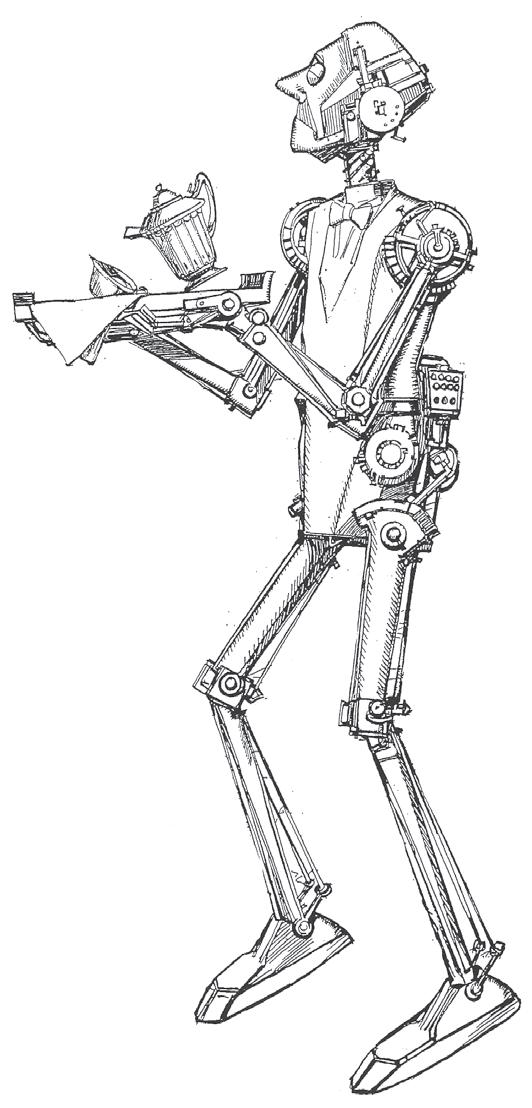
Katie Gohn (UTC): We use OverDrive for popular materials: fiction, non-fiction, wellness. We haven’t purchased many titles with pay-per-use or limited checkouts. We see OverDrive as serving a similar one user/one title option as our traditional print collection. Our print fiction section in the library was continuing to grow at a higher rate than other areas of the collection. OverDrive provided us a way to provide a similar lending model to patrons and help us keep our print stacks in order.
Keani King (UTC): As Katie describes above, we primarily rely on perpetual access. We see our use of OverDrive as an opportunity to build a lasting collection of resources that don’t “fill up our shelves.” We also subscribe to the magazines collection and the Duke UP Classics as they both provide a wide variety of titles for all types of users.
Stephanie Kaceli (CU): Cairn uses all different models for a variety of reasons and I think there are benefits and risks in all of them. When asked which lending model Cairn prefers, I always answer, “It depends.”
The core benefits for us: more bang for our ever-shrinking buck, flexibility/wise stewardship, stability. Not all collections/ titles are created, nor priced, the same. The ability to have options allows us to select what work works best for us within the context of use, cost, and subjects. Within the academic setting, patrons do not expect anything other than unlimited users. Hitting a turn-away for an eText is a foreign and frustrating concept for students who do not have the luxury to wait for a copy to become available. Even when downloads are limited, or short lending periods are set, a needed item can create dozens of turn-away emails in a single day. Subscriptions to collections are typically unlimited user; however, the trade-off is loss of access during budget cuts or removed titles.
Though perpetual access is preferred, the one-time pricepoint for collections and single titles, is not always attainable. Purchasing single titles, particularly unlimited or DRM-free, can be cost-prohibitive. Purchasing 1 or 3 user licenses adds additional work for librarians managing collections. Where available, concurrent access/non-linear lending can be a sweet spot of perpetual access + cost. For smaller institutions, the download limits are rarely hit.
Pay-per-use is a great way to avoid turn-aways, but the chance of run-away charges is real. Cairn has had great success with OverDrive’s cost-per-checkout as turn-aways are avoided and we can control the budget. This has been a good solution for many higher priced 1-user titles.
46 Against the Grain / April 2024
<https://www.charleston-hub.com/media/atg/>
Though subscriptions can be more volatile in terms of the lack of control with content coming and going and yearly subscription increases, it can be seen as good stewardship when ensuring a collection will be used before using budget dollars on perpetual purchase. This is especially attractive when vendors put previous subscription spend towards a perpetual purchase.
What are the risks?
Al Salatka (UTC): At UTC, OverDrive also provides access to audiobooks, which is a big win for our users. Traditional CD audiobooks are easily damaged and not transportable. Our patrons are really happy about this option (we utilize Perpetual Access and Subscription models). The only risk to perpetual access is that we acquire titles that will never get used, but at the same time, little risk to that because we’re investing in a long term collection — access won’t go away — no worry that “we shouldn’t weed this” because it was a popular title, even a few years ago.
Stephanie Kaceli (CU): The risks have to do with budgets and staff time. Perpetual purchases typically require a large up-front outlay with yearly hosting fees. A perpetual purchase is typically only the content from time of purchase back so when a new edition or new titles are added to a collection, the library needs to spend additional money and human resources to have the latest content. I do believe the toughest aspect of a perpetual purchase, outside of the up-front costs and continual hosting fees, is the belief that it is a one and done deal. There is a lot of tending to perpetual access titles and collections or both can become stale and irrelevant to the community, as well as another burden to over-burdened librarians.
The pay-per-use model can blow through budgets rightquick and then students are turned-away from accessing the item which was the main reason to use the pay-per-use rather than a 1 or 3-user perpetual purchase.
Subscriptions, with the benefit of having new titles added, have a considerable risk for unsustainable yearly increases and significant titles being removed. Both risks also require a large amount of staff resources to either re-negotiate costs or manage pulled titles.
How do you navigate any trade-offs and continue to meet the needs of your users, while factoring in the omnipresent budgetary constraints?
Katie Gohn (UTC): We allocate a specific amount of budget per month for selections. Since our collection is focused primarily on popular fiction and nonfiction at this point in time, we are able to purchase perpetual access to about 10-12 titles per month. This seems to keep the content fresh enough for our patrons as we consider other budget options for funding OverDrive in the coming years.
Keani King (UTC): We budget a specific amount of money for requests and stick to that budget; on a rare occasion, we will receive purchase requests that mention OverDrive options specifically, but will utilize other options if needed based on budget.
Regarding trade-offs: We’d like to be able to provide more multi-user options for very popular titles, but we are either restricted by budget or the option isn’t available from the publisher. We also don’t acquire series or sets; we have to have some limitations on what we provide our users for this niche collection that falls outside the scope of curricular or research needs, and the time spent on managing series for our small team isn’t worth it at this point.* One benefit we’ve
found with self-help and wellness titles acquired through OverDrive is the layer of anonymity provided to users — they don’t have to bring the books to the desk to check them out.
*Editor’s note: OverDrive offers the services of Digital Content Librarians to assist in the selection and management of a library’s digital collection.
“One benefit we’ve found with self-help and wellness titles acquired through OverDrive is the layer of anonymity provided to users — they don’t have to bring the books to the desk to check them out.” — Keani King, University of Tennessee, Chattanooga
Victoria Turner (ECC): The impact on the learning experience is of utmost priority at our institution. Meeting the instructional needs of our teaching faculty and students through streaming video resources has been well-received by the administration. In the past two years since I have been in my position, I have been able to persuade the administration to double the amount of funding in my AV line. This likely ties into the pandemic, as more of our courses have moved into an online or hybrid environment. Additionally, our student enrollment has increased by nearly 10% in the past year, and new programs are being added, so financially supporting learning resources has been amenable to our administration.
Stephanie Kaceli (CU): Cairn attempts to obtain perpetual access to e-content used in courses to ensure access for all students and limit staff/faculty resources to manage titles removed from collections. For subscriptions, librarians watch the titles being removed and purchases, within budget constraints, titles with high use, required for courses, or mission fit.
How is sustainability and accessibility accounted for with content acquired through different licensing models? Are there models that offer better guarantees for future access and format compatibility?
Al Salatka (UTC): At this moment, we are building a collection of materials. In the future, we hope to develop more rigorous assessment on what’s getting used, and begin looking at different licensing models. We need to figure out how to carve out staffing time to investigate how sustainable those models are for us in the long term, but for now, we are able to sustain our collection and meet the needs of our users through our current purchasing model.
Katie Gohn (UTC): Anything that is perpetual and available to download to other devices feels more guaranteed. However, because we are sticking to a niche popular collection — these titles do not have to “future proof.” I can see a time when we would pull stats and purchase print copies of some of these titles or make sure we have a preservation plan for the most popular and award winning titles.
Victoria Turner (ECC): It depends on the teaching faculty and their instructional needs. Faculty teaching an in-person course and wishing to show a documentary synchronously in the classroom will be able to do so through certain streaming video providers. However, if that same professor is teaching that same course online as well, some platforms or content
47 Against the Grain / April 2024 <https://www.charleston-hub.com/media/atg/>
providers will not allow for online, synchronous streaming. This can be hindering to the learning experience and frustrates faculty unaware of varying delivery methods. Many times, I have received a, “This video doesn’t work!” phone call from a professor during a lesson to troubleshoot, which is an awful time to tell them that their method of delivery is unsupported. Greater accessibility to content is imperative to our institution and the learning experience.
It is clear from these libraries’ experiences that using a variety of lending models has nuances and can be complex to understand what is best for serving both student and faculty
needs. The upside in navigating the lending model options that are available can make a big difference in having resources available as they are needed while controlling and minimizing costs.
There are more insights to share as we could not fit all our librarians’ astute comments into one column. Looking ahead to Part 2, the librarians will share their thoughts on the impact of access models on the user experience, challenges with discovery and the pros and cons of Open Access Resources.


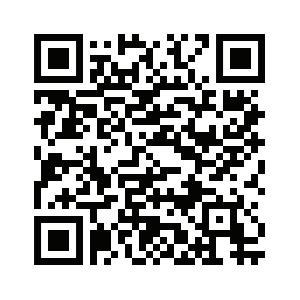
48 Against the Grain / April 2024
<https://www.charleston-hub.com/media/atg/>
Sky’s the Limit!" In Person: November 11-15 Online: December 9-13 SAVE THE DATE! Call for Papers opens April 24 Registration and Hotels open June 13 Scan for Call for Papers Proposal Form Charleston Conference ISSUES IN BOOK AND SERIAL ACQUISITION ™
“The
ATG Interviews Daniel J. Doody
Former President, CEO, & Owner, Doody Enterprises, Inc.
By Ramune Kubilius (Collection Development / Special Projects Librarian, Galter Health Sciences Library & Learning Center, Northwestern University Feinberg School of Medicine) <r-kubilius@northwestern.edu>
and
Leah Hinds (Executive Director, Charleston Hub) <leah@charlestonlibraryconference.com>
At the end of 2023, it was announced that Tim Butzen is now the owner of Doody Enterprises, Inc. (DEI) and that Daniel J. Doody is retiring after a fulfilling 46-year career in medical publishing. ATG caught up with Dan to chat with him about a look-back on his career, and plans for his retirement.
ATG: Tell us about your early career path and how you ended up in medical publishing.
DD: I obtained my master’s degree from Northwestern University’s Medill School of Journalism in 1977. While completing my studies, we were visited by recruiters from multiple media outlets. One of the recruiters was the Vice President of Marketing for a scientific, technical, medical (STM) publisher in New York City called Marcel Dekker, Inc., the one and only scientific publisher among the many media outlets recruiting at Medill. (Marcel Dekker, Inc. was subsequently acquired by Taylor and Francis.) The Vice President from Marcel Dekker who came to Medill to recruit graduate students to her firm was Mary Ann Liebert, who left Marcel Dekker more than 30 years ago to start her own firm, Mary Ann Liebert, Inc., publishers. She had done her undergraduate work at Northwestern’s Medill School of Journalism, and it was her observation that an education in journalism would prepare someone well for a career in scientific publishing. On the basis of that initial interview, Marcel Dekker, Inc. hired me to be an acquisitions editor in training in the fields of engineering and mathematics. Within six months, due to the departure of the medical editor, I was offered the opportunity to become Dekker’s medical acquisitions editor, thus launching a 46+-year career in medical publishing.

I left Mosby-Year Book to start Doody Publishing, Inc. (the forerunner to Doody Enterprises, Inc.) in January 1993. Doody Publishing was a very early adopter of the Internet. We introduced the online version of Doody’s Journal at the MLA meeting in May of 1995. We were the only publisher on the exhibit floor charging money for our digital content. Other early adopters at that meeting were using the web strictly for promotional purposes (called brochureware at the time) or were offering their content for free, certain they would attract enough traffic to be entirely advertising supported. That business model had a relatively short shelf life.
Over the past 31 years, there have been countless adventures and many highlights, but perhaps the most memorable was to survive the dot.com bust of the early 2000s.
ATG: Can you tell our readers how and when was Doody Enterprises, Inc. formed?
ATG: Please name a few career highlights that stand out.
DD: In addition to the hiring story at Marcel Dekker that I just recounted, other career highlights include getting hired as a medical editor at Year Book Medical Publishers, Inc. in October of 1979, allowing my family and me to return to our native Chicago from New York City. While Year Book was eventually merged with Mosby in 1989 forming Mosby-Year Book (which was subsequently purchased by Elsevier), in the ten years I worked at Year Book, the company grew from losing money on $10MM in annual revenue to being highly profitable with annual revenues of $45MM. So, it was very exciting to be part of that company during a period of such dynamic growth. A highlight from the mid-’80s to mid-’90s was attending the annual Frankfurt Book Fair several years in a row.
DD: As mentioned, I originally incorporated my company as Doody Publishing, Inc. and we launched our business in January of 1993. After 15 years in the medical publishing business, I decided to go out on my own. At the time, I felt medical publishing was a grossly overpublished niche. I was interested in making an original contribution. I was intrigued by two publishing models, one was Current Contents, founded by the legendary Eugene Garfield, and the other was CHOICE Magazine, a book review periodical published by the Association of College and Research Libraries (ACRL) division of the American Library Association. Influenced by the apparent success of those two products and aware there was not a systematic way of providing reviews of newly published medical books, I decided to develop a timely, authoritative, comprehensive, and fair way to publish expert reviews of the 3,000 new books published in the health sciences every year. The Doody’s Review Service™ system became the foundation of the company and is the single foundational element that has accounted for the company’s durability and success. (Doody Publishing, Inc. was reorganized in 2003 under the name of Doody Enterprises, Inc. (DEI), the name it still operates under.)
ATG: Over the years, your connections with medical librarians seem to have led to some of the services and products of Doody Enterprises, Inc. (DEI). How did some of those come about?
DD: From the earliest days, we have described our products and services as developed by librarians for librarians. We had a Library Board of Advisors even before we incorporated the
49 Against the Grain / April 2024 <https://www.charleston-hub.com/media/atg/>
company. Back in 1992, I met with about a dozen librarians active in health sciences libraries in Chicago to get their advice on the need for a systematic and comprehensive medical book review system. That group was responsible for developing the taxonomy for Doody’s Review Service®. They also introduced me to department heads at the six (at that time) academic medical centers in the Chicago area, many of whom accepted my invitation to serve as the first Editorial Review Group Chair in their specialty area(s) of interest.
In 2004, when it was announced that the Brandon-Hill List, a free acquisitions tool medical librarians had been using for the last 30+ years, was no longer going to be published, our Library Board of Advisors served as the sounding board for our plan to fill the void in the wake of the demise of the Brandon-Hill List with a new product that relied on the virtual collaboration of about 100 librarians. The result: the first edition of Doody’s Core Titles® (DCT), published in December of 2004. This year the company will publish the 21st version of DCT, due to the continued contributions of DCT’s Librarian Selectors.
When the pandemic froze the world in March of 2020, librarians did not freeze, continuing to work every day (albeit most of them virtually) and providing the essential work of keeping front-line workers informed with the latest information about what we were learning about COVID-19. By May of 2020, DEI decided to publish a list of 90 essential books on subjects that were related to this infectious disease outbreak on our publicly available website, Doody’s Collection Development Monthly . Within a short time, this list generated several thousand hits. That gave birth to the quarterly Doody’s Special Topics Lists, a publication that is overseen by an Editorial Board of five health sciences librarians. Each quarterly list is researched and chosen by a panel of three librarians who are subject matter experts in the topic area of the list.
ATG: Your retirement letter alluded to the fact that you are pleased and hopeful about the future of Doody Enterprises, Inc. in new hands, with someone you mentored over the years at the helm- would you agree?
DD: Yes. To elaborate, let me excerpt one of my quotes from the press release announcing the sale of Doody Enterprises:
“I’m so grateful that the company is in the hands of such a capable, creative, and forward-thinking owner as Tim Butzen. Tim’s competence is wide-ranging and exceptional. What is especially remarkable are his personal characteristics. He never wavers from his positive outlook, and he always leads with kindness. It’s hard to imagine a better outcome when transferring the ownership of Doody Enterprises, Inc., than selling to such a trusted, valuable employee. This transaction ensures continuity for what has been a remarkably stable and successful company.”
ATG: What are you most excited about or looking forward to in your retirement? Any plans you’d like to share?
DD: For the last few years, I have been volunteering at a grammar school (PreK 3 – 8) about a mile from my home that educates 200+ children from the most impoverished neighborhood in Chicago. The education the kids get is outstanding; but the school is terribly under resourced, and the children come from homes where the needs are many. Since I believe that education is one of the keys to breaking generational poverty, my volunteer work has been focused on bringing more resources from the community (human and financial) to advance the mission of the school and to help stabilize the homes the children come from. It’s been tremendously satisfying the way in which the community has responded to the opportunity to support the school’s mission, its students, and their families.




50 Against the Grain / April 2024 <https://www.charleston-hub.com/media/atg/>
N E W E P I S O D E S E V E R Y M O N D A Y C H A R L E S T O N - H U B . C O M / M E D I A / P O D C A S T S /
ATG PROFILES ENCOURAGED

Beth German
Assistant Director of Assessment and User
Experience, Princeton University
One Washington Road Princeton, NJ 08544
<bg1162@princeton.edu>
https://www.princeton.edu/
BORN AND LIVED: Champaign-Urbana, Houston, College Station, New Jersey.
FAVORITE BOOKS: Pride and Prejudice and the last book I’ve read, most recently Americanah by Chimamanda Ngozi Adichie.
HOW/WHERE DO I SEE THE INDUSTRY IN FIVE YEARS: The core mission of the library industry doesn’t change while the means to meet the mission will always change. In the next five years, I see technological advances such as AI; changes in the political landscape and the continued need to advocate for education, educators, and students; increased reliance and need for sustainable governance for open infrastructure; climate uncertainty and its effects on the workplace; and increasing access to global research will factor in to how the library industry acts as a community hub and archive for the use and growth of human knowledge.

Elyssa M. Gould
Head, Acquisitions & Continuing Resources
University of Tennessee Libraries
Hodges Library, 1015 Volunteer Blvd. Knoxville, TN 37996
Phone: (865) 974-6908
<egould1@utk.edu>
PROFESSIONAL CAREER AND ACTIVITIES: I began as a Cataloging & Metadata Librarian but moved into an E-Resources position early on in my career. The cataloging role provided a good foundation for my e-resources work, and I’ve been fascinated by e-resources ever since!
HOW/WHERE DO I SEE THE INDUSTRY IN FIVE YEARS: I see the industry of electronic resources having fewer vendor options due to more mergers; more automations both within the resources themselves as well as the systems that enable discovery of library resources; and (hopefully) more acceptance of preferred library terms in licensing.
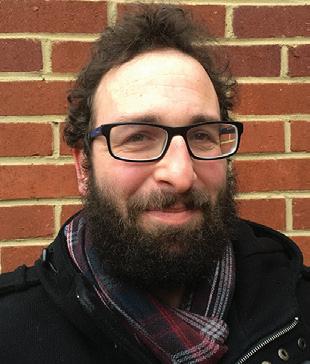
Simon Holt
Senior Product Manager, Content Accessibility
Elsevier
Headquarters: Radarweg 29
1043 NX Amsterdam
The Netherlands
<s.holt.1@elsevier.com>
https://www.elsevier.com/
PROFESSIONAL CAREER AND ACTIVITIES: I have worked in scholarly communications for the past 15 years, primarily in book and journal publishing roles. Alongside this I have been a part of various industry-level initiatives seeking to increase equity within our industry, with my work primarily devoted to disability inclusion. I serve on several industry bodies, including currently as a Director for the Society for Scholarly Publishing.
IN MY SPARE TIME: I enjoy playing chess, watching live music and supporting my local football team, Stockport County FC.
FAVORITE BOOKS: Small Island by Andrea Levy is comfortably the best book I’ve read in the last 5 years — it resonates a great deal with where we’re from, who we are and where we’re going as a society.
 Bill Kasdorf
Bill Kasdorf
Principal
Kasdorf & Associates, LLC
1308 Cambridge Road
Ann Arbor, MI 48104
Phone: (734) 904-6252
<kasdorf.bill@gmail.com>
https://pubtechpartners.com/
PROFESSIONAL CAREER AND ACTIVITIES: Publishing technology consultant active in many organizations: in the W3C as Global Publishing Evangelist and the various publishing activities in the W3C; also active in SSP, NISO, BISG, IPTC, and the DAISY Consortium.
HOW/WHERE DO I SEE THE INDUSTRY IN FIVE YEARS: Traditional monographs and formal peer-reviewed journal articles will be complemented by many more modes of publication. Scientific and scholarly research will be communicated throughout the research process, with data, software, and research resources shared with peers and the public. Much of this has begun, and many disciplines now emphasize preprints. I hope the new CP/LD format I helped standardize with NISO is widely used by then.
51 Against the Grain / April 2024 <https://www.charleston-hub.com/media/atg/>
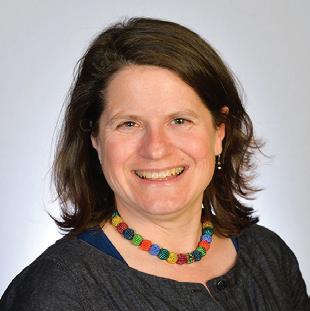 Nettie Lagace Associate Executive Director
Nettie Lagace Associate Executive Director
NISO
3600 Clipper Mill Road Baltimore, MD 21211
<nlagace@niso.org>
https://www.niso.org/
BORN AND LIVED: Montana; Connecticut; New Brunswick, Canada; Saudi Arabia; New Hampshire; Michigan; Massachusetts.
IN MY SPARE TIME: Through a friend who owns a pet business, I maintain a side hustle dogsitting and hiking. I love all dogs, but big dogs are my favorites! I also like to bake, knit, read the news, and cheer for the Boston Celtics and Red Sox.
HOW/WHERE DO I SEE THE INDUSTRY IN FIVE YEARS: Improved tools will enable more effective collaboration; it will be easier for any organization to contribute to community work and utilize these resources to attack local challenges.

Leigh Hall Mosley
Accessibility Coordinator
University of Tennessee Libraries
Hodges Library, 1015 Volunteer Blvd. Knoxville, TN 37996
Phone: (865) 974-0011
<lmosley1@utk.edu>
BORN AND LIVED: Born in Boone County KY. Studied and worked in Indiana, Texas, New York, London, Bratislava, Prague, and St. Petersburg.
PROFESSIONAL CAREER AND ACTIVITIES: Certified Web Accessibility Specialist.
FAMILY: Married with two children.
IN MY SPARE TIME: Spending time with my children before they completely flee the nest.
FAVORITE BOOKS: The Goldfinch by Donna Tartt and Olive Kitteridge by Elizabeth Strout.
PET PEEVES: Vendors of expensive databases that don’t require even basic accessibility training for their web developers.
GOAL I HOPE TO ACHIEVE FIVE YEARS FROM NOW: Finally completing an initial accessibility assessment of every one of the electronic subscription resources at the UT Libraries!
HOW/WHERE DO I SEE THE INDUSTRY IN FIVE YEARS: Looking ahead to the “industry” of digital accessibility, I see two things: 1) a stricter regulatory environment being promoted by the DOJ and stricter web standards with WCAG 3.0; and 2) greater integration of AI into both the creation of accessible code, thus facilitating a move toward more “born accessible” products, and also into personal user assistance (including in the form of wearable tech), thus helping to adapt the experience of electronic interactions to meet a more diverse array of needs.

Nicholas Seow
Accessibility Specialist
Elsevier
Headquarters: Radarweg 29
1043 NX Amsterdam
The Netherlands
<n.seow@elsevier.com>
https://www.elsevier.com/
FAVORITE BOOKS: I’ll share several that have made an impression over the past couple of years. On living in the moment: Francisco by Alison Mills Newman. On escape and interiority: The Wall by Marlen Haushofer. On memory and the archive: Landscapes by Christine Lai. On the weirdness of the present and future: Lambda by David Musgrave and The Employees by Olga Ravn.
52 Against the Grain / April 2024
<https://www.charleston-hub.com/media/atg/>

Charleston Conference ISSUES IN BOOK AND SERIAL ACQUISITION
2024 Vendor Showcase
Tuesday, November 12 10:00 am - 5:30 pm
Charleston Gaillard Center Exhibitor registration opens June 11.
“The Sky’s the Limit!"
Back Talk continued from page 54
skeptical of just how good these books can be. Everybody in the fashion business pays thousands of dollars for them.
Well, who knew all this? There have been some curious bits of business in the transition from the old management to the new and some interesting headaches with the wifi network in the building. (In the transition year, we needed to run the old institution’s program and students with access to one set of digital resources and the newly-admitted ASU folks with access to another.) We were lucky, though, to inherit a small but truly excellent staff of smart people who know what they’re doing, genuinely like each other, and (as it happens) really like the new ASU management. (Another set of headaches? Get an American public university based in one state to run programs in another. Employment laws, tax, health insurance, retirement — even America’s most innovative university has to take bureaucratic pettifoggery in stride!)
We’ve just completed a search for a senior librarian to replace one who had left during the ownership transition, and we’re about to grapple with all the adventures of integrating catalogs and de-duping subscriptions. The whole experience has been
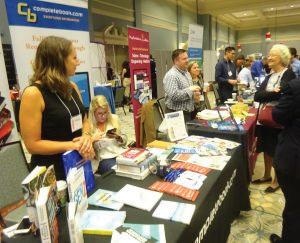

Scan for Details
and Registration
one with the special pleasure that comes from discovering a domain of human activity I knew nothing about and finding that it is populated by smart and interesting people with imagination, creativity, and (nowadays) technology applied in amazing ways. Our taking on this library has really been a perk and privilege of my job this year.
So, another day, another new library. Since that meeting last spring, ASU has announced that it will open a medical school in two years, so there’s another all-hands-on-deck scramble to figure out accreditation requirements and work on getting licensed resources in place. (NOTE TO OUR VENDOR FRIENDS: Yes, we know you’re there and we’ll come talk to you when we’re ready. Don’t call us, we’ll call you.)
Then recently (in September 2023), the President of the United States showed up in town and announced a significant gift for ASU to build a John McCain National Library on a nearby hilltop, and that’s got a two-year timeline attached. Note to all friends: if you want to give ASU another library, maybe we could chat first? It’s all a bit much, but quite wonderful at the same time.
53 Against the Grain / April 2024
<https://www.charleston-hub.com/media/atg/>
™
Back Talk — Another New Library? What Fun!!
One day last spring, I went to a meeting that had turned up on my calendar. I hadn’t a clue what it was to be about, and it turned out to be a working group focused on “inboarding” a whole new enterprise in Los Angeles. ASU had purchased the facilities and program rights of the Fashion Institute of Design and Merchandising (FIDM), a 50-year old private degree-granting institution in downtown LA. “And Jim,” they said, “you’ll run the library, right?” First time anybody’s ever given me a whole library without, you know, a warning
Now as any Charleston-goer who’s seen me ambling in and out of the Francis Marion in my J.C. Penney Geezerwear(TM?) will immediately know, fashion isn’t exactly my, um, métier, but, hey, we’re “America’s most innovative university” (our busses remind us of that all the time), and we can try anything.
It’s been a revelation. Back and forth to LA a few times, and if you hate LAX, I’m happy to tell you about Burbank, and if you need a downtown hotel with rooms that aren’t large enough to change your mind in, I’ve got a great recommendation. That said, it’s been a wonderful experience.

LA is a fashionmanufacturing city (the place ASU bought is a few short blocks from the Fashion District), so the library has a standing relationship with various vendors who donate odds and ends of their current fabrics, which turn into the substance of a fabric swatch library collection, where students working on a project rummage around and are allowed to snip off a sample to attach to their finished project. Next door to the swatch library is the innovative fabrics library offering specimens of newly invented materials — vegan leathers made of unusual materials and the like.

What can be different about running a fashion library, I naively asked myself. Well, for one thing, the focus is relentlessly visual and tactile. The print collection (quite a good one) is heavily oriented towards materials that will stimulate the visual imagination of students learning the basics of fashion design. On top of that, the FIDM library has two unique collections of a kind I’d not seen before.
And the traditional print collection has its own delights. Running a fashion school in LA means an interest in Hollywood, which means an interest in costume design, especially for period pictures. That remake series of Perry Mason set in 1930s LA? They need costumes, you know. So the FIDM library has collected for that sort of request. To my delight, one of their regular tools is their collection of old Sears and Roebuck catalogs, the big fat mail order volumes that take you right back — took me right back — to 1960, in elaborate detail. I’ve never seen those in a library before, but they fit right in.
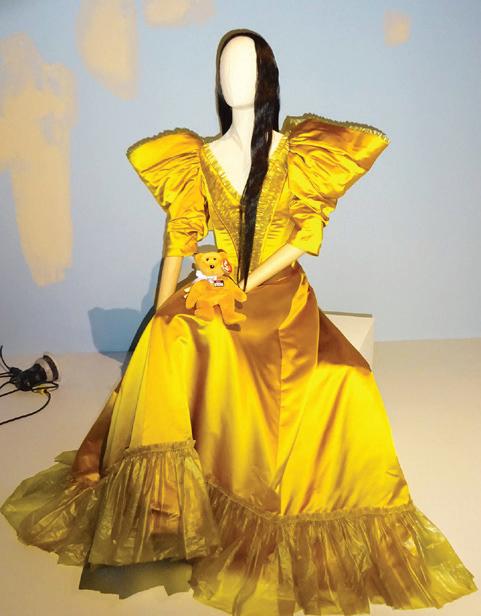
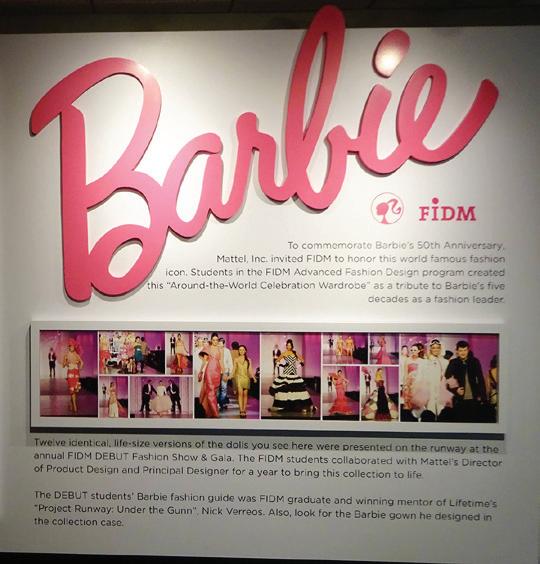
There are other features of fashion school that I had never imagined. It turns out that sizing patterns for manufacture is a tricky and complicated business. You don’t just design a size medium top and expect the factory to be able to do everything from small to XXL with the same pattern, because human beings don’t change size by scaling in a linear fashion but go out more than up and some parts go further than others in what turn out to be complicatedly predictable ways. Enter the faculty member who teaches students to use the software that’s now the tool of choice for taking a brilliant original design and making it something that can actually be mass-produced and sold: fascinating to listen to, working at the boundaries between art, taste, physiology, and technology.
And then there are the trend books. These cost several thousand dollars each, are published twice a year, and come with elaborate designs, typography, and inlaid swatches of fabric. The fashion industry, I am told, lives and dies by these books, because they purport to tell the industry what will be hot 18 months from now — tracking trends. So in early 2022, these books would have said SUMMER 2023 – THINK PINK! Or something like that. Everybody outside the fashion business is continued on page 53
54 Against the Grain / April 2024 <https://www.charleston-hub.com/media/atg/> ADVERTISER’S INDEX FOR ADVERTISING INFORMATION CONTACT Toni Nix, Advertising Manger, Against the Grain, Charleston Hub <justwrite@lowcountry.com> • Phone: 843-835-8604 2 ACS Publications 56 Against the Grain 13 American Mathematical Society 7 Association for Computing Machinery 50 ATGthePodcast 48 Charleston Conference 2024 53 Charleston Vendor Showcase 5 Cold Spring Harbor Laboratory Press 17 INFORMS 55 Knowable Magazine 11 Mary Ann Liebert, Inc. 3 Optica Publishing Group 9 OverDrive
Column Editor: Jim O’Donnell (University Librarian, Arizona State University) <jod@asu.edu>
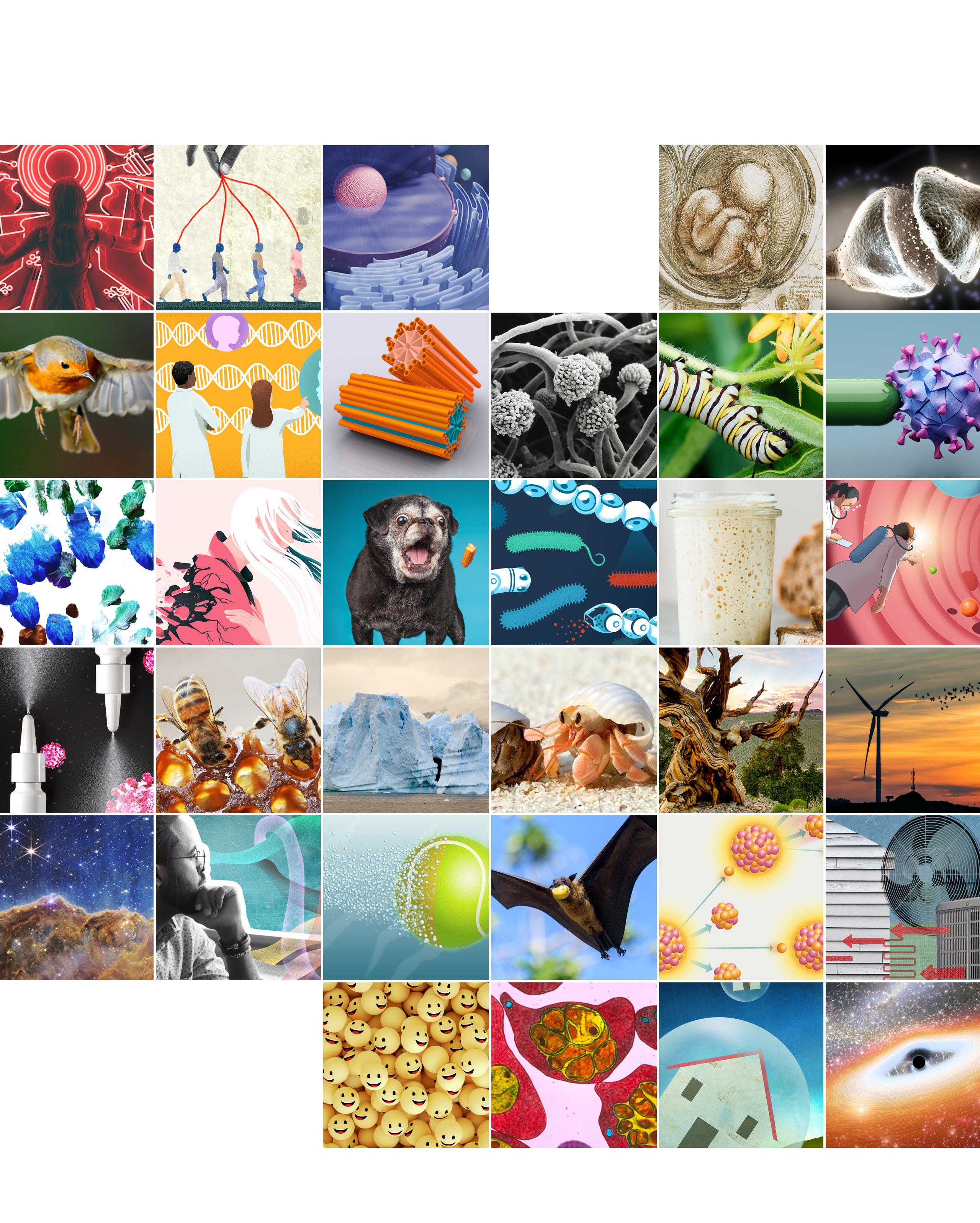
Explore the latest: knowablemagazine.org
Lea en español: es.knowablemagazine.org
Sound science, smart stories Free to read, free to republish Knowable Magazine
“We’re


Against
Against the Grain
the Grain (ISSN: 1043-2094) is your key to the latest news about libraries, publishers, book jobbers, and subscription agents. Our goal is to link publishers, vendors, and librarians by reporting on the issues, literature, and people that impact the world of books and journals. ATG eJournal will be published five times a year (February, April, June, September, and November) and will be distributed to ATG subscribers, Charleston Library Conference attendees, and registered members on the Charleston Hub. Find ATG on the Charleston Hub at www.charleston-hub.com TO ADVERTISE IN ATG Contact Toni Nix at <justwrite@lowcountry.com> Click the links below for information on how to Subscribe, Submit Content, or Contact Us
the Grain has gone digital! About
Against
still linking Publishers, Vendors and Librarians EVERYDAY!”








































































 Bill Kasdorf
Bill Kasdorf
 Nettie Lagace Associate Executive Director
Nettie Lagace Associate Executive Director


















